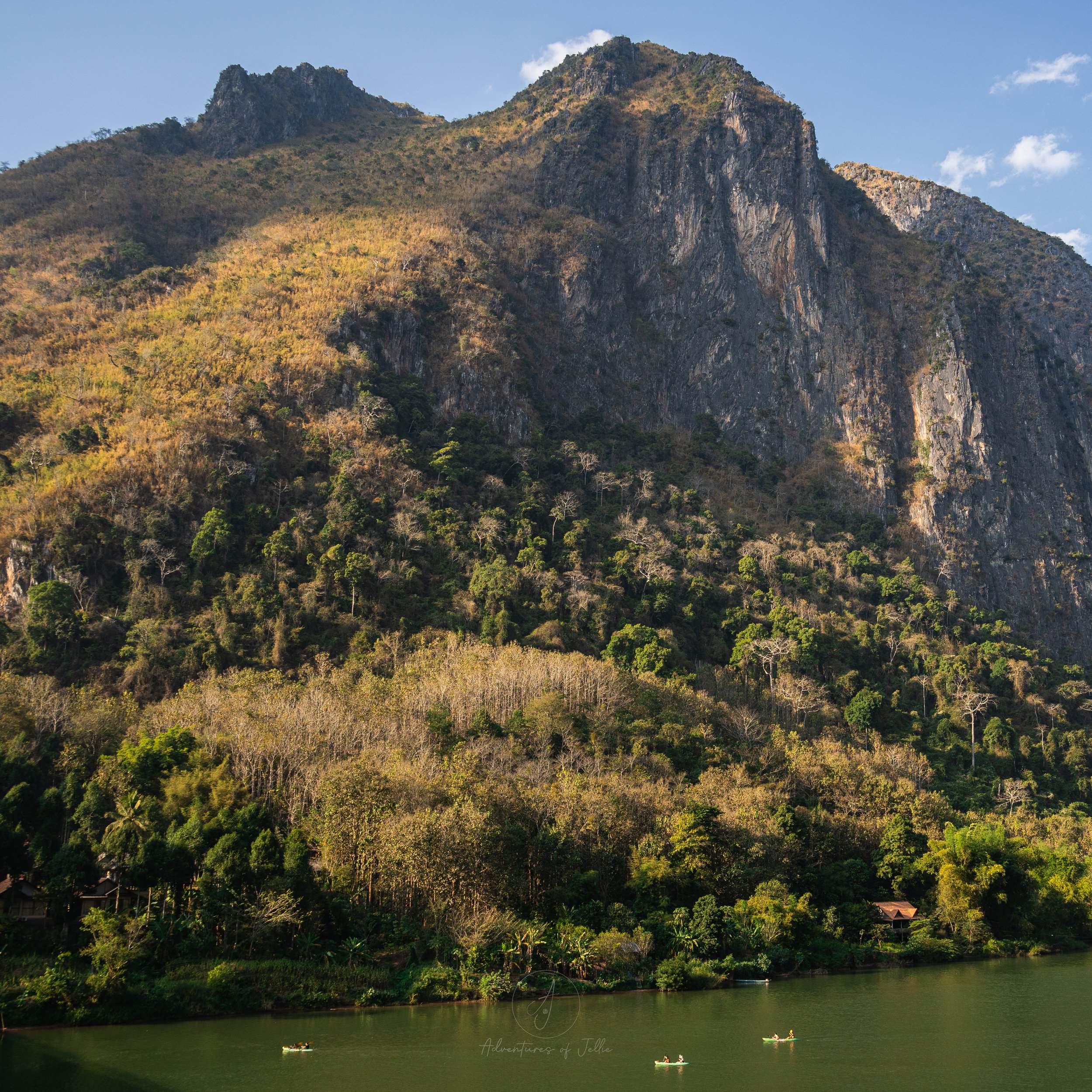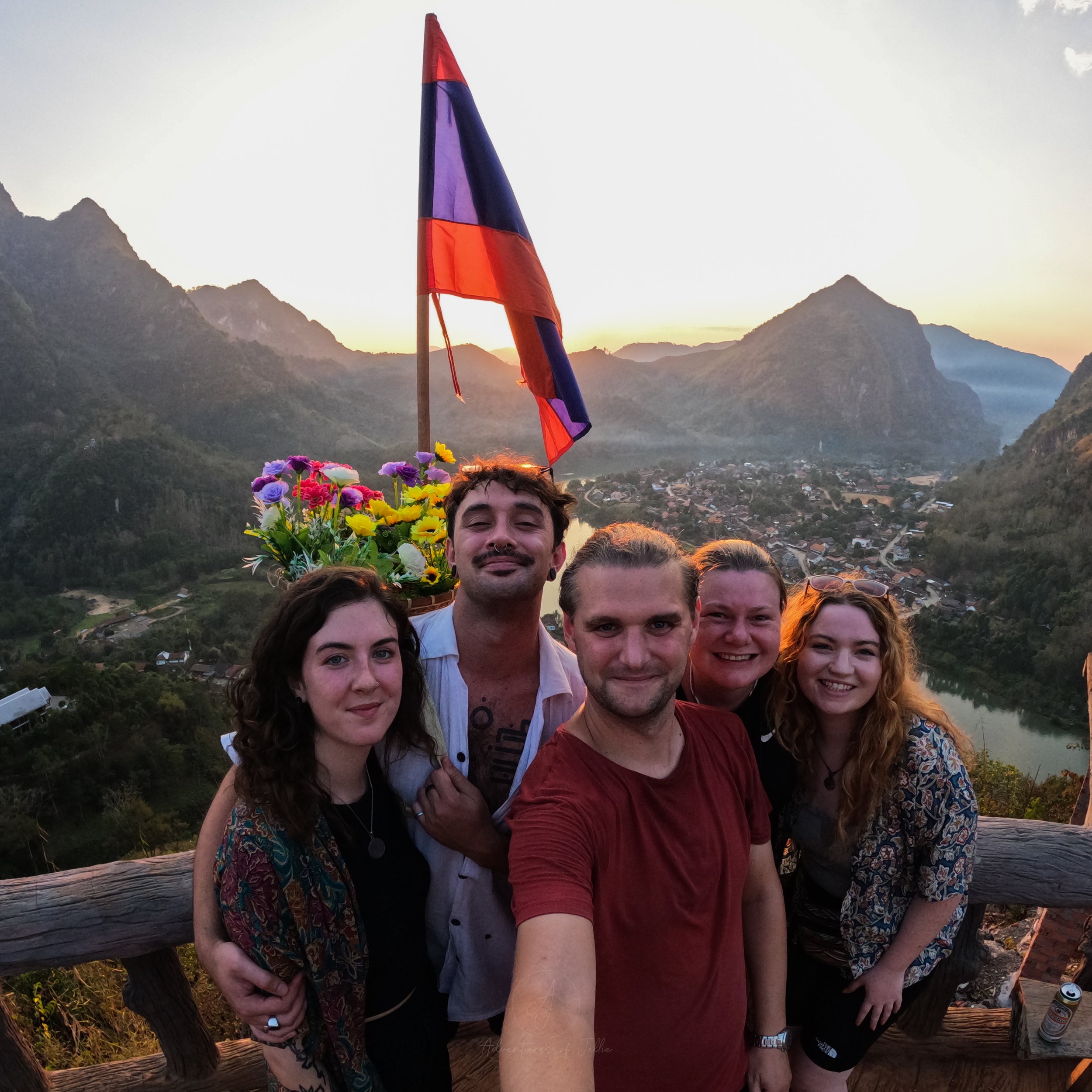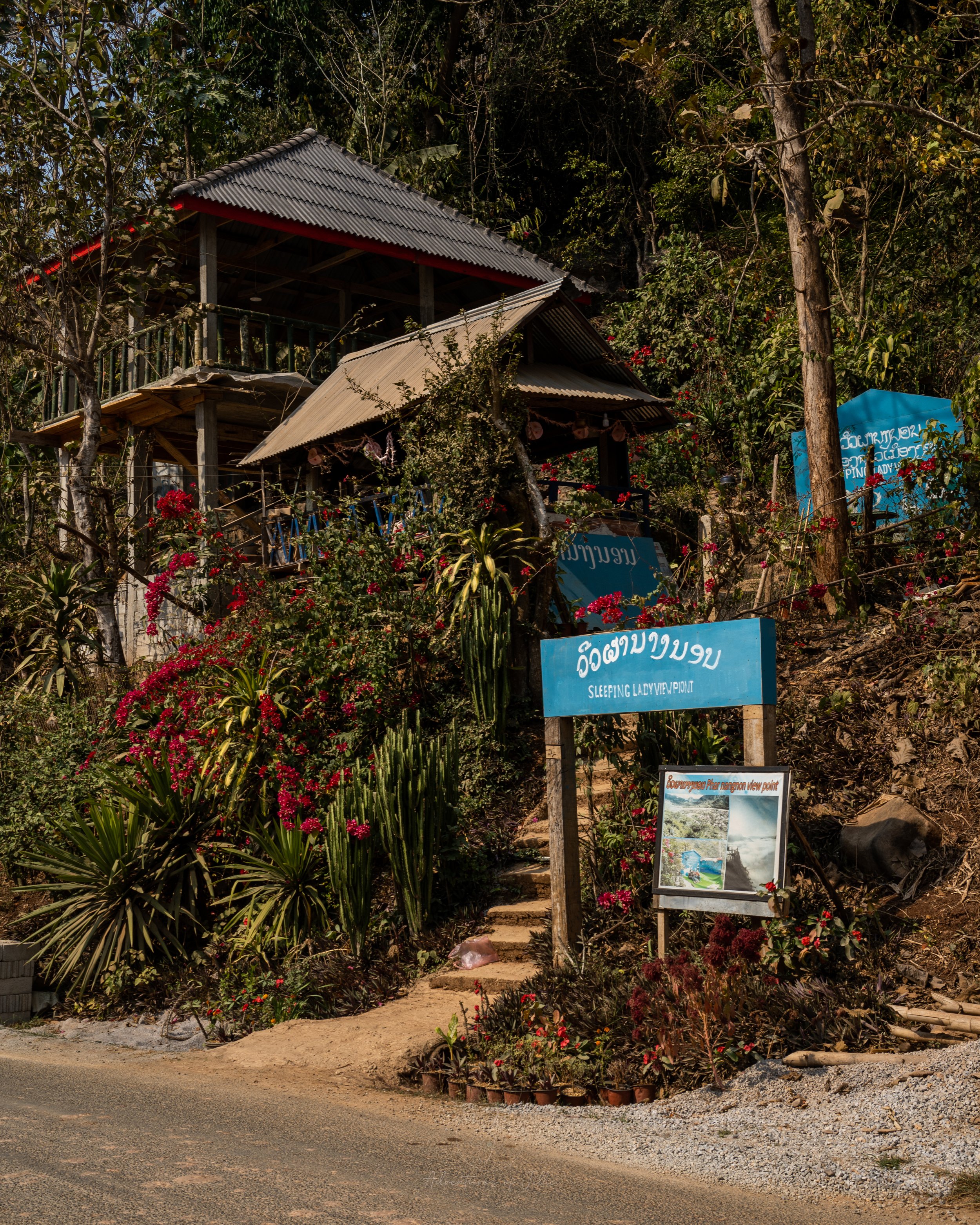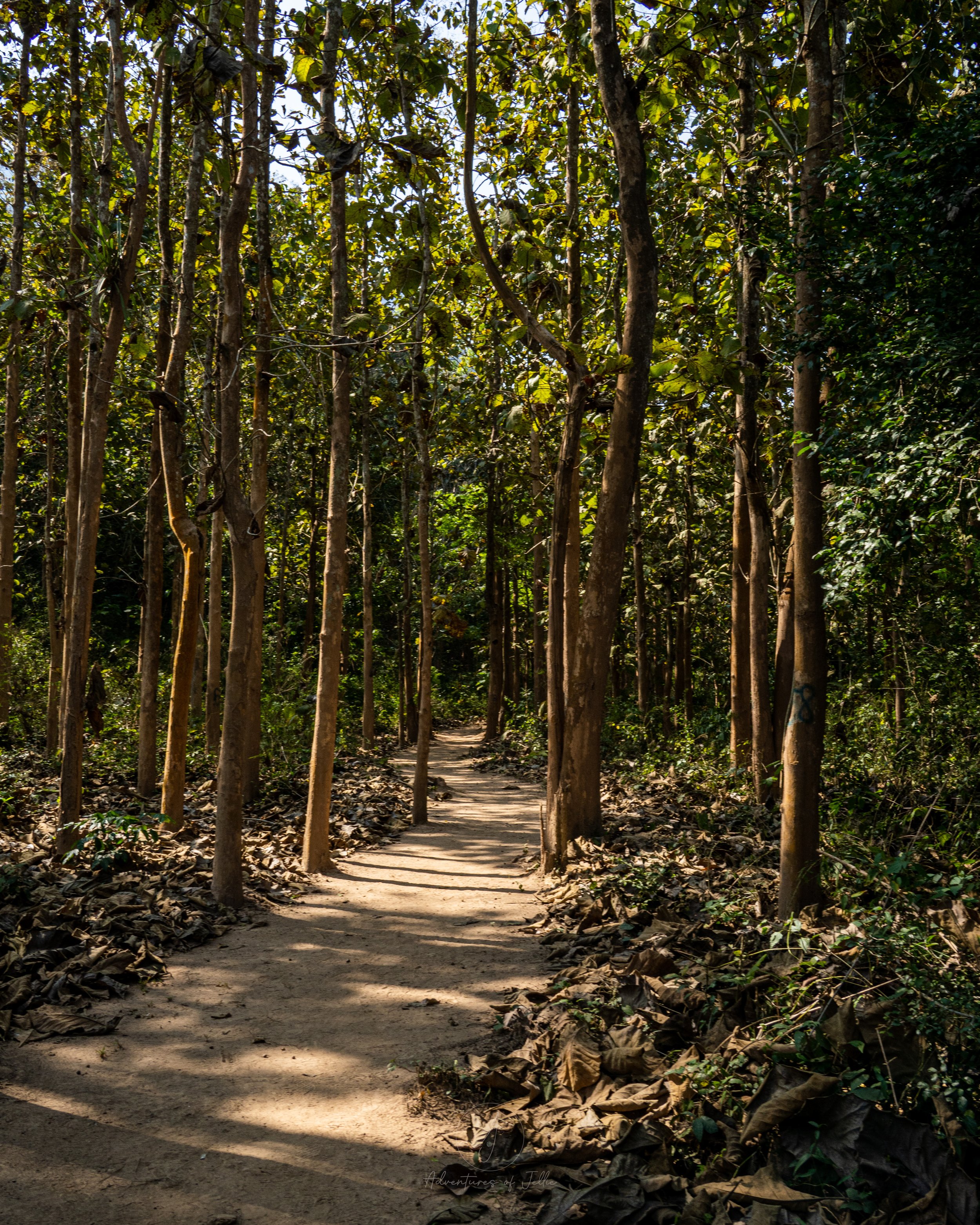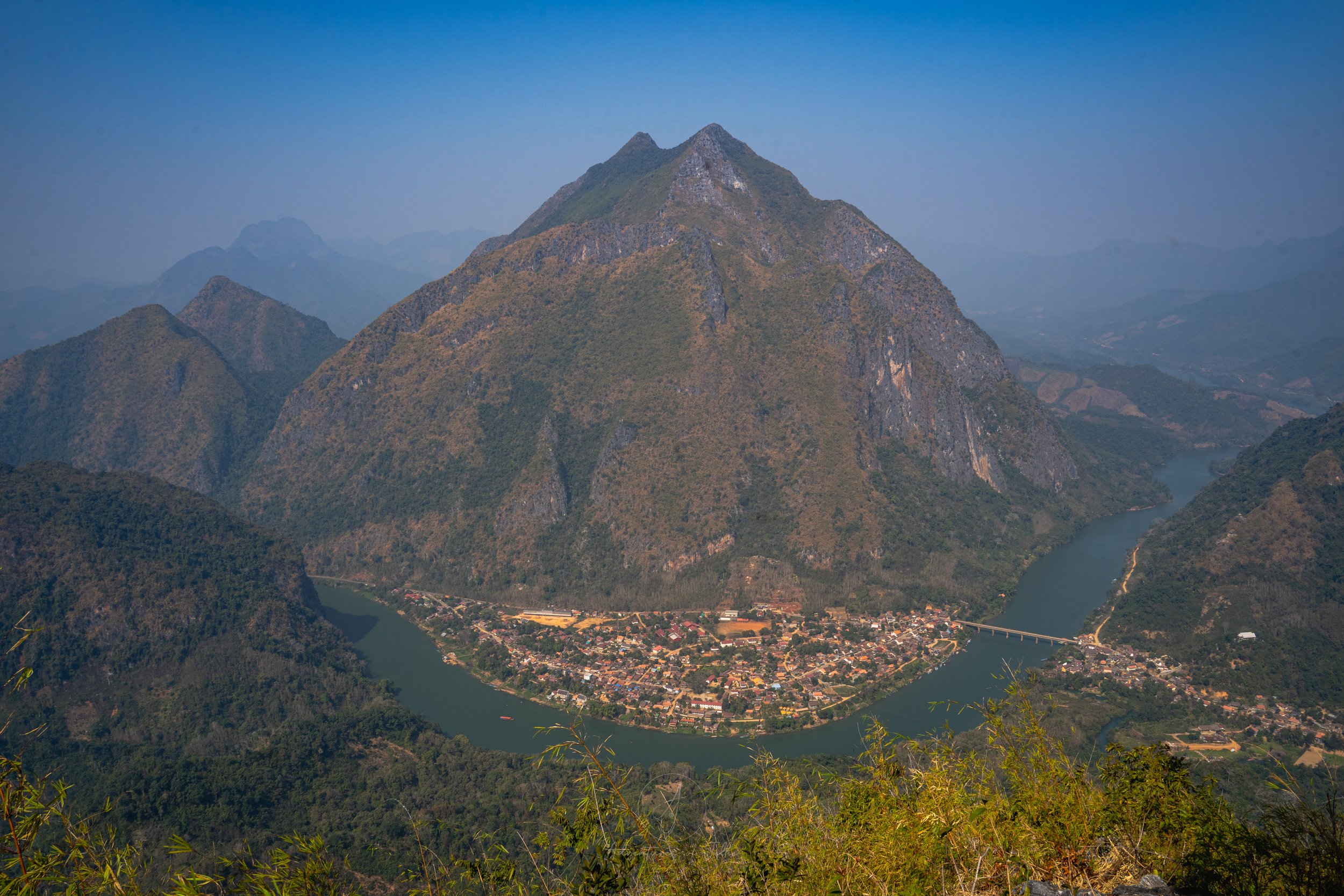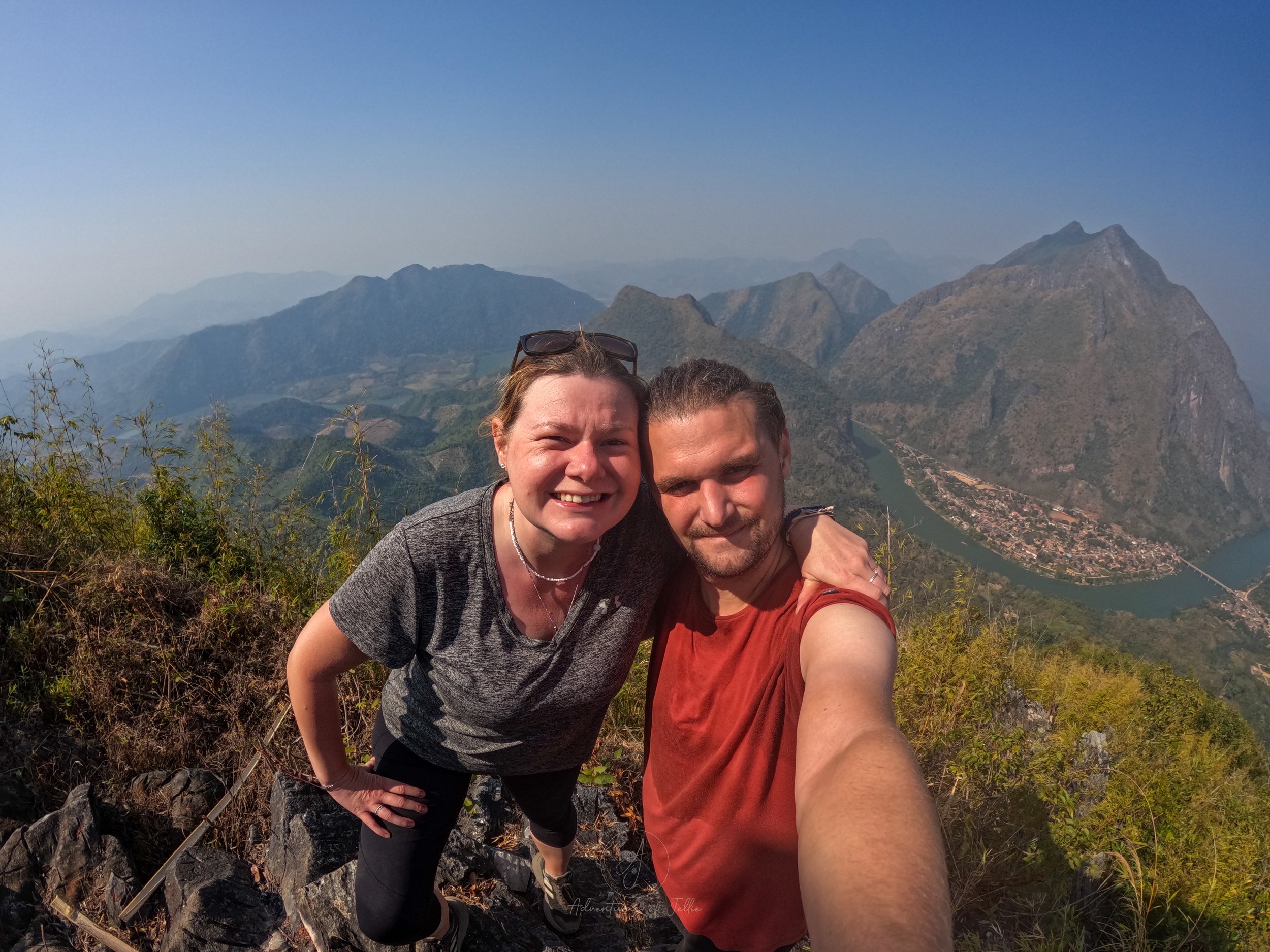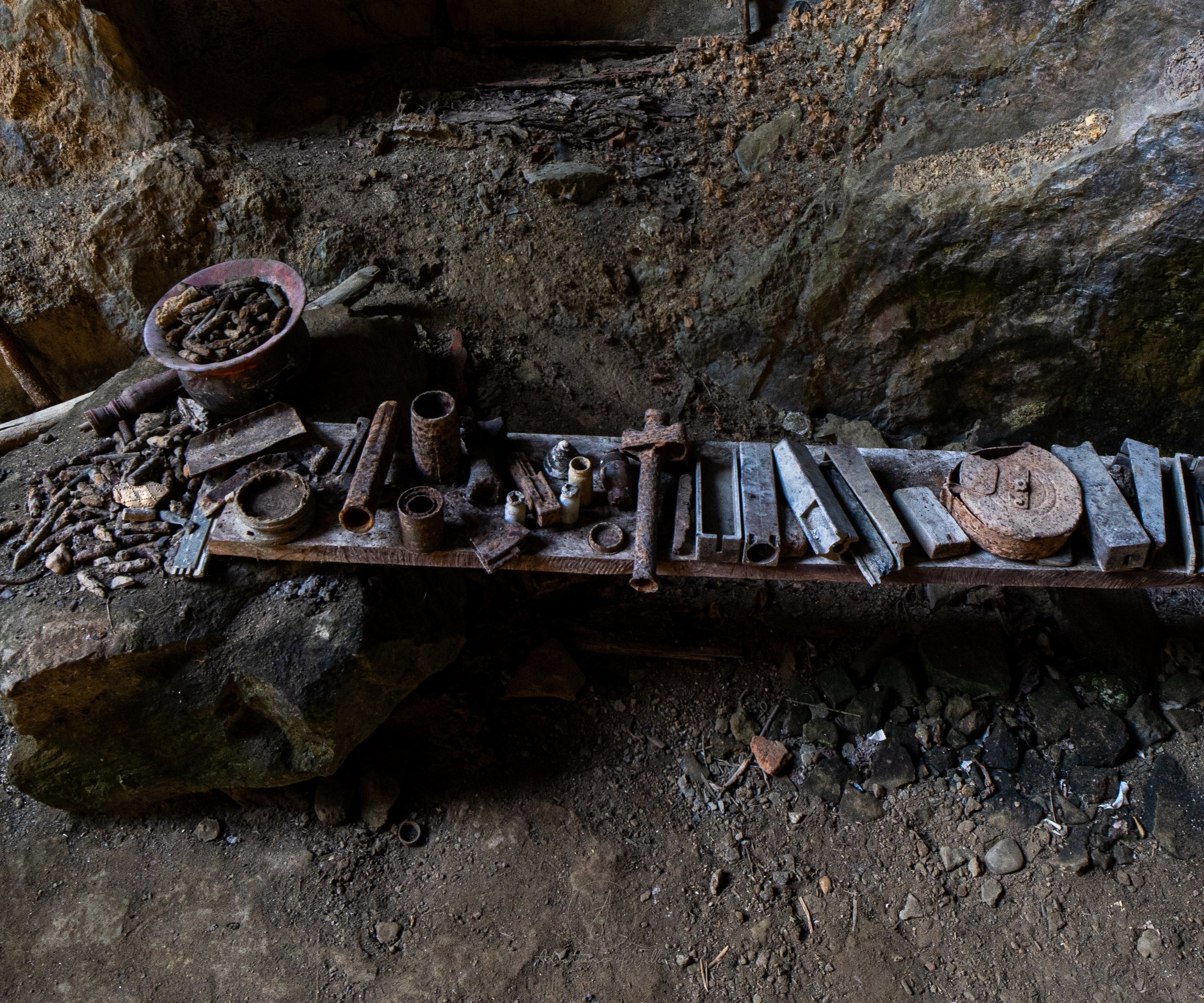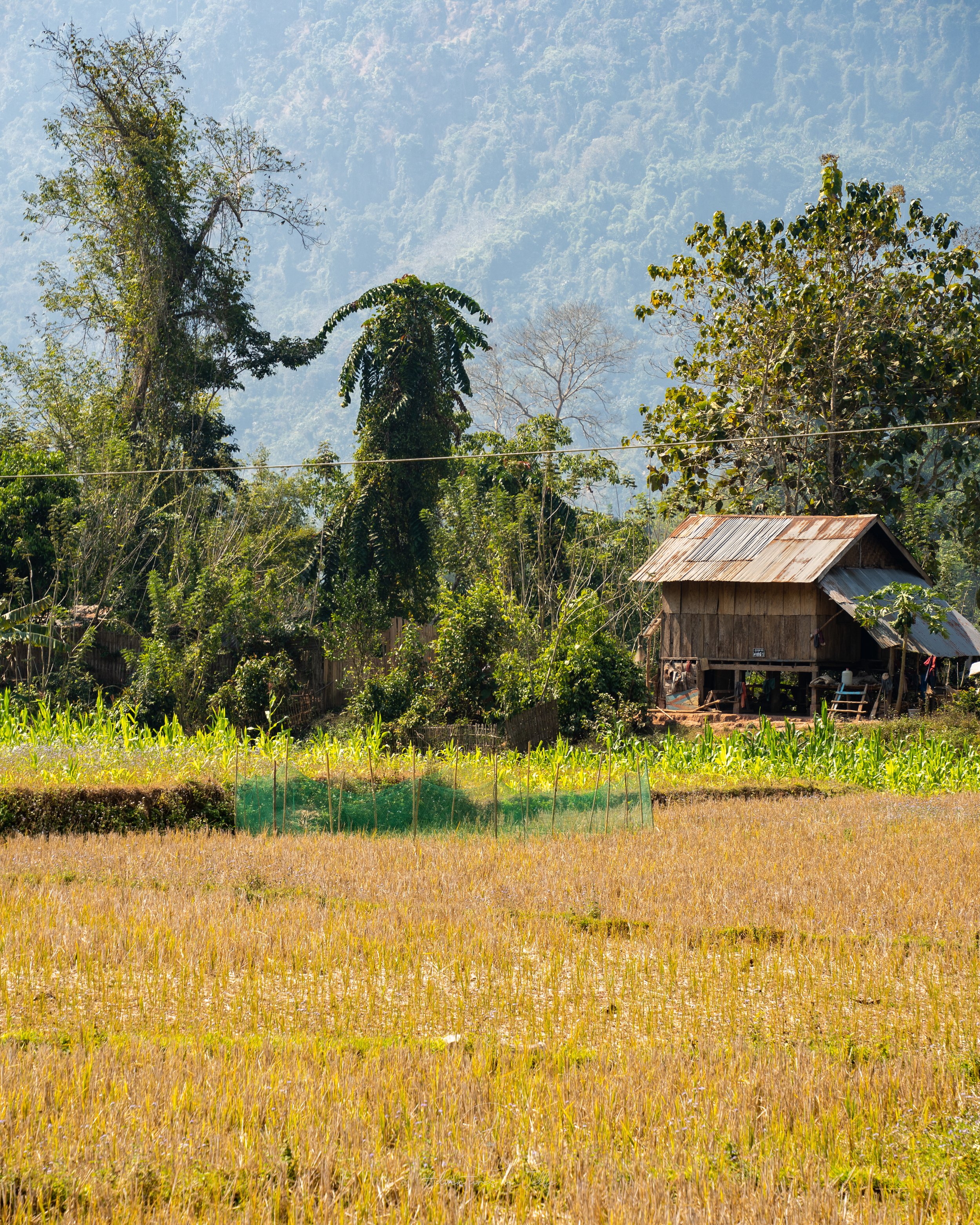Nong Khiaw to Sam Neua - A Road Less Travelled
If you are looking for a less travelled route through Northern Laos, you have come to the right place. Read our guide and story of the journey between the mountain backpacker town of Nong Khiaw and Sam Neua and finally the caves of Vieng Xai. The journey is not for the faint of heart!
The mountainous, river-laced region of northern Laos can sometimes be a bit of a headache for tourists to navigate. Transport between places frequently seems to require shuttling to and from the city of Luang Prabang. If you want to go to most places, the advice will be to travel through or via Luang Prabang. On our third trip to the beautiful country of Laos, we wanted to avoid doing the "Luang Prabang shuffle".
We were staying in Nong Khiaw, one of our favourite places on Planet Earth (read all about it here). We knew we wanted see more of the north before, eventually, heading down to Phonsavan and its mysterious Plain of Jars. The only issue was that there was no obvious route between Nong Khiaw and Phonsavan, we thought that we would need to go back to Luang Prabang and then catch an onwards bus.
As we have mentioned, we did not want to do the Luang Prabang Shuffle. We had just spent nearly a fortnight in the amazing Laotian cultural capital (read more about that here) and did not want to go straight back. So we broke open the maps (ok the Google map at least) and had a look at our options.
After checking with Google, the Nong Khiaw bus station and the minibus operators in town we quickly found that the only routes away from Nong Khiaw that did not involve Luang Prabang were:
North, taking a boat trip up to Muang Ngoi, Muang Khua and the border with Vietnam
West to Luang Namtha (or on further still to Huay Xay)
East towards Sam Neua and Vieng Xai. From Sam Neua we could see that there were buses down South to Phonsavan.
The choice for us was easy, we had already been to Luang Namtha and had spent three months in Vietnam (check out what we got up to!). We had found our route to Phonsavan, we could go from Nong Khiaw to Sam Neau, From Sam Neua stay in and visit the caves at Vieng Xai and then catch a bus to Phonsavan. We would take the road less travelled, we would head East.
If you want to know more about the beautiful town of Vieng Xai or the Mysterious Plain of Jars at Phonsavan, make sure you read our two articles on these towns:
Sam Neua is the hub town for the less visited north-eastern corner of Laos. The town itself has a large market and a few guest houses but it mainly acts as a gateway for visitors to access mountains, national parks and the beautiful, cave-riddled town of Vieng Xai.
Sam Neua also has bus links to Phonsavan and onwards further south, it sounded like the perfect cure for the Luang Prabang Shuffle. We decided that we would take the slow road, travel from Nong Khiaw to Sam Neua and then take the short hop on to Vieng Xai.
Disclosure: This article may contain affiliate links. We will earn a small commission from any purchases made through these links.
It is hard to leave Nong Khiaw, but eventually you will have to!
Nong Khiaw to Sam Neua - Getting to Vieng Xai
Decision made we had to buy our bus tickets. The first issue is that the Nong Khiaw to Sam Neua bus does not stop at the Nong Khiaw bus station. The bus departs from Luang Prabang and, if it is not completely full, will stop just after the bridge in Nong Khiaw to pick up more passengers. We had heard that this can be a little bit of a gamble, if the bus was busy there would be no space for us let alone our large, backpacking rucksacks! We (inventively or shamefully depending on your outlook) solved this issue with money. We, through an agent in Nong Khiaw (see the end of the article for all the practical tips and information) bought tickets from Luang Prabang to Sam Neua, with the driver being informed that we would actually get on the bus at Nong Khiaw. This would mean we were guaranteed actual seats on the bus and that there would be space for our bags. It really helped having local assistance with this, our agent phoned the driver and made sure what time he would arrive and that we would have proper seats. The seats were just as well due to issue number two...
We were warned that the road between Sam Neua and Nong Khiaw is atrocious, like completely awful. Imagine a mud crusted, crater-pocked landslide of a road, then constantly run massive haulage lorries across it and you get the idea. From Nong Khiaw to Sam Neua it is only around 320km but we had been warned that the journey could take around 16 hours. Oh and that it would be happening overnight so we would have the fun of a bone breaking, heart shaking ride in the dark!
We do love an adventure and were very determined not to retrace our steps to Luang Prabang so we paid up and booked on the bus to Sam Neua.
Crammed in the minibus and ready to go! - How little we knew….
The Journey - Nong Khiaw to Sam Neua
Our overnight journey started off well enough. The minivan pulled up exactly when our travel agent in Nong Khiaw said it would. We were not relegated to the beer crate seats but had normal car seats. The leg room was Laos-typical, as in there was some but not much, especially not if you have brought enough snacks and supplies for a 16 hour road trip! We folded ourselves into our seats and settled in for the long ride.
The scenery around Nong Khiaw is breath-taking, deep forest-shadowed valleys and soaring cliff edge roads. The initial ride was fantastic, with beautiful views and stunning scenes only occasionally interrupted by spine wrenching collisions with potholes.
Just as the shadows were lengthening and the light was turning gold we pulled into a small village. We hopped off the bus and stretched out. There was a small restaurant and a couple of stalls selling crisps and drinks. We had eaten just before leaving Nong Khiaw and were fully stocked with snacks and supplies. The shops out there in rural Laos were very different, there was the occasional recognisable brand but mostly it was brands we had never heard of, imported from China or Vietnam.
The minivan driver; a tiny man apparently made entirely of steel (he had lifted Ellie's bag in one hand whilst balancing on the minivan roof), had another motive for the village stop. Whilst we perused the shops he was with the local mechanic, checking and refilling the spare tyre, it was almost as if he knew what was ahead....
As the night drew in the road got worse and worse. Initially we had been on badly maintained roads but the tarmac had now all but disappeared. We were now on mud and gravel roads which were very much unsuitable to the heavy haulage running alongside us. Deep wheel troughs were gouged out of the muddy road surface and potholes the size of bomb craters littered the way. We bounced and crashed through these obstacles, being frequently flung out of chairs and crushed back by the seat belts. It was worse being sat near the back, you could never see what it was that caused the crash; you would just be dozing off and smash! We would be jolted into full panic wakefulness.
We did not get much sleep.
We had nearly no stops at all, after our short spare-tyre-check at the start of the ride we had only stopped once and that was for a five minute toilet break. We had been travelling for 9 hours but had nearly no breaks from the bone bouncing ride. Luckily our hard working drivers stamina finally gave out just before dawn and we pulled over for a nap. It was only an hour and a half of respite but it was like water in the desert, very very needed!
As the first light of dawn started to turn the black sky grey we were treated to a fantastic sight. Sam Neua is at a much higher altitude than Nong Khiaw (1200 metres v.s 400). We had climbed though the night and now had incredible views across the cloud filled valleys below. We were on a mountainous island in a sea of clouds. Other little hill tops punctured the ocean of clouds around us. It may have been the sleep deprivation but it seemed magical!
We pulled into the cold and misty bus stop at Sam Neua at around 5 in the morning, 12 hours after setting off from Nong Khiaw. Around us the breakfast barbecues of food stalls were just lighting their charcoal. We had been bounced, shaken and rattled but we had got there. We were feeling all adventurous and smug when we were brought swiftly down to earth; the lady who had just spent 12 hours wedged between the door and another passenger, whilst sat on a beer crate, cheerfully hopped on a waiting motorbike and sped off into the dawn. For us it was an adventure, for her it was Thursday.
It may not look like much, but this little warrior got us through the rough roads to Sam Neua!
Sam Neua to Vieng Xai - One last stretch
Of course we werent done yet! We had made it to the hub town of Sam Neua but not our final destination - the limestone cliffs and caves of Vieng Xai. From Sam Neua it was another 30-40 minutes to the east by bus before we would get dropped off near Vieng Xai.
To complicate matters further, the bus to Vieng Xai did not leave from the bus station we had arrived at in Sam Neua. Our bus station was a good hours walk from where we had been dropped off. We therefore did what we always do when unsure of our next move - Went to find food.
We had hung around the bus station for a little while and the fires of the stalls were now wafting the small of roasting meat at us. We resisted the urge to just stay put and gorge on grilled meats, hoisted our backpacks on and set off for the short walk into town.
After our Vieng Xai adventures we found ourselves back at the original Sam Neua bus stop for our connection to Phonsavan. On this second occasion we did get some sticky rice and grilled pork - It was delicious, filling and the perfect pre-bus meal!
15 minutes walk down the road and we found ourselves in the slowly waking town of Sam Neua. We headed first for some noodles at a busy early morning street side eatery. The noodles were just what we needed, warming and comforting after our long journey. On the wall of the noodle shop were a selection of phone numbers for local taxi firms, we jotted down some numbers for later, finished our bowls and headed back out into the morning light
Sam Neua, as we have said, is a lot higher up than Nong Khiaw and was positively chilly in the early morning. This unexpected cold was the perfect excuse to treat ourselves to some upmarket coffee! We had spotted the Yuni Coffee Co Cafe on Google maps during our research and our noodle stop had given it time to open (7am). The coffee, which was made from locally grown beans, was delicious and desperately needed.
The coffee at Yuni’s was desperately needed!
Not fancying a long walk with our backpacks we started casting about for a taxi. Dialling the numbers we had got from the noodle shop, we quickly heard back from one firm and booked our ride to the Nathong Bus Station.
From the bus station multiple buses go to (or rather past - see later), Vieng Xai. We bought two tickets (30,000 kip each), boarded a bus and waited for it to fill up with locals.
The bus set off in the glow of the morning and wound up and around incredible mountains, passes and gorges. After only about half an hour we came up to the turning for Vieng Xai, the bus rumbled to the side of the road and decanted two weary backpackers.
The bus dropped us on the main road where a smaller road forks off for Vieng Xai (around here), it was not a long walk (luckily!) into town from there. We trudged the final 10 minutes to our guest house and collapsed. After 12 hours on the worst roads we have experienced, 3 and a bit hours in Sam Neua and a final bus ride we had made it!
We had avoided the Luang Prabang Shuffle and now found ourselves somewhere completely new, unknown to us and exciting. This is what our kind of travel is all about!
The Practical Stuff
Why Go to Sam Neua?
Sam Neua Town is the gateway to Northeastern Laos. It is not on the normal "tourist trail" but is an amazing jumping off point for several hard-to-reach locations. From Sam Neua you can:
Explore the incredible Nam Et - Phou Louey National Park. This is now on our list of missed opportunities. We would love to explore the waterfalls, pools, jungles and amazing biodiversity of this National Park. It is best explored with a guide. Have a look at the tours (and unique accommodation) on their official site. It just didn't fit our plans or budget on this trip but looking back we are regretting not trying harder to accommodate it.
Technically part of the above; the Night Safari at Nam Nem is meant to be absolutely stunning. Travellers we met on the road told us it was one of the best things they did in Laos. Again a missed opportunity for us :(.
Phonsavan and the Plain of Jars. This is what made us look into the area around Sam Neua, if you are coming from Northern Laos - Nong Khiaw or Luang Namtha, then the only way to get to Phonsavan is to shuttle back to Luang Prabang and catch a long bus from there. Sam Neua provides another possible route, allowing you to skip going back to Luang Prabang. Of course this route only really makes sense to do if you then make the most of the area around Sam Neua, speaking of which...
Vieng Xai - This was what brought us to Sam Neua on that long and bumpy bus journey. Vieng Xai is a gorgeous little town surrounded by towering, dramatically shaped limestone mountains. You can find Vieng Xai on a map here. The area is the birthplace of the Lao Peoples Revolutionary party and the caves and mountains became homes, classrooms and cabinet offices for the party as it fought for independence from the French, then against the Americans in the "Secret War". The area is stunning, with amazing waterfalls, viewpoints, caves and history.
Sam Neua offers a route out of Northern Laos that not only saves you from traveling back and forth to Luang Prabang but also takes you to some 'off-the-beaten-path' destinations you might not have considered. It brings you out of the well-trodden places and let you see a little more of the country than the average traveller.
How to get to Sam Neua From Nong Khiaw
You need to ask at one of the tour offices in town. The bus stop does not sell the tickets as the bus does not technically stop in Nong Khiaw. We would recommend finding a tour office that does this regularly and knows the driver / company. After a couple of visits to different offices that did not fill us with confidence, we found this place. We are pretty sure that the google listing is for the wrong name but it is in the right place and you cannot miss it on the side of the road - just look for the sandwich boards offering tours and you will be in the right spot. The helpful man on the counter booked us seats right from Luang Prabang so we were guaranteed an actual seat (as opposed to a mid-aisle beer crate) on the long journey. He also had the drivers phone number and let us know exactly when the minivan would be arriving.
How much do tickets from Nong Khiaw to Sam Neua Cost?
Our tickets cost 225,000kip each. This was for guaranteed seats and space for our two sizable backpacks. This was worth paying for the peace of mind, we did not want to find ourselves balanced on beer crates for 16 hours whilst rocketing through potholes!
Can you catch the minivan without using a tour agent?
If you are feeling lucky and want to chance doing it by yourself, just wait at the bridge around 5-7pm (bus timings are seldom exact in Laos) and flag down the minivan as it passes. It would be worth making a sign with the Laotian for Sam Neua (sometimes called Xam Neua or Samneua) written on it. It will be cheaper than buying tickets through an agency but you run the risk of a beer crate seat!
How long is the bus ride from Nong Khiaw to Sam Neua?
Our journey took 12 hours including a couple of shorts stops and a mini-nap for the driver. We were warned the journey can, if the roads are especially bad or busy, take up to 17 hours.
Ellie and our bags - safely deposited at the Southern Bus Station in Sam Neua
Can I stay in Sam Neua - Is there accommodation
There are plenty of guesthouses and hotels in Sam Neua. Staying in Sam Neua would be a great idea if you need somewhere to recuperate from the long journey before moving on to the national parks or elsewhere. You can find your accommodation choices here.
Sam Neua has markets, temples and even a viewpoint to explore. It is a much more industrial feeling town than Nong Khiaw - much less picturesque. However, it is a true Laotian town full of great food, coffee and people. You could easily spend a night there
How to get from Sam Neua to Vieng Xai
If you are coming from Nong Khiaw You will arrive in Sam Neua at the Southern Bus Station (located here). This is not the station that the Vieng Xai bus leaves from! You need to get to the Nathong / Na Thong Bus Station - located here. From the Nathong bus station several buses a day leave that will take you past the turning to Vieng Xai. Bus tickets from Sam Neua to Vieng Xai cost 30,000 kip per person. We caught the 10:30am bus, but beware - the schedule changes frequently and the times are just a suggestion! We would advise to check with a local when you arrive.
Our bus to Vieng Xai, waiting in Nathong Bus Station.
You can take a taxi from Sam Neua to Vieng Xai. Taxi’s cost around 500,000 kip so the it is a much more expensive option. However, a taxi may be necessary for your return to Sam Neua as there was no information on flagging down a bus to get back to the larger town! We caught the bus from Sam Neua to Vieng Xai but took an early morning taxi from Vieng Xai to Sam Neua for our bus connection to Phonsavan.
Another option is to rent a scooter in Sam Neua and ride it to Vieng Xai. There was no where we could find to rent scooters in Vieng Xai so this might not be a bad idea. Just make sure you can carry your luggage safely on the bike and be careful on the mountain roads! Also be warned - the scooter prices are a lot higher in Sam Neua (250,000 - 350,000 kip per day) than elsewhere in Northern Laos.
Tips for Long Journeys in Laos
Eat beforehand, the bus does not stop often and, on our journey at least, did not stop for a meal.
Bring snacks and plenty of water / drinks. It is a long journey, have some snacks available. You have much more choices of bus snacks in Nong Khiaw than you will get at the few roadside stops the minivan makes.
Bring a charger, the ride is long and can be delayed significantly by road conditions - make sure you don't run out of battery.
Bring a jacket or a hoodie - you will be travelling high up in the mountains overnight and it will get chilly.
Headphones are a must. You won’t want to be reading from a screen as it will be liable to be catapulted out of your hand when the minivan hits another pothole! Stock up on downloaded music and podcasts for the journey.
If you suffer from motion sickness then bring and take your meds! The roads are forever winding up or down the mountains of Laos.
Go with a sense of adventure - you will need it! All joking aside this is not a restful or "pleasant" bus ride it is a real adventure!
The road may be rough but the destinations are worth it. Happy trails!
Thanks for reading.
John & Ellie xxx
#adventuresofJellie
If you’ve enjoyed reading this article, why not save the pin below?
If you’re found this blog helpful, entertaining or you just fancy supporting us, please click the button below!
Muang Ngoi - A Hidden Riverside Treasure In Northern Laos
Sitting on the banks of the Nam Ou River, Muang Ngoi is a perfect riverside escape in Northern Laos! Read our ultimate travel guide for everything you need to know about visiting from how to get there, what guesthouse to stay at and what to do.
Hidden on the banks of the Nam Ou River and bordered by towering limestone peaks, rice paddies and traditional villages, is the beautiful town of Muang Ngoi, a secluded riverside escape.
One of the hidden gems of Northern Laos, Muang Ngoi lets travellers experience the beauty and serenity of riverside life without sacrificing too many home comforts. Surrounded by stunning nature and full of things to do, Muang Ngoi is a fantastic addition to any Laos backpacking itinerary.
Many travellers will visit Muang Ngoi as part of a day trip or have a single overnight stay in this laid-back riverside town. We recommend staying longer and exploring further. There is so much to see and the serene, relaxed vibes will draw you in and make it hard to leave. We wound up staying 4 nights here, chilling on the banks of the river, exploring the local villages, hiking the viewpoints and generally just enjoying this sublime slice of traditional Laos.
Just as a side note - Muang Ngoi is also known as Muang Ngoi Neua and sometimes spelt Muang Ngoy. We will stick with Muang Ngoi in this article.
In this Muang Ngoi travel guide:
Disclosure: This article may contain affiliate links. We will earn a small commission from any purchases made through these links.
Where is Muang Ngoi?
Muang Ngoi sits on the banks of the Nam Ou River deep in the mountains of Northern Laos. The town is tiny and resides within the Luang Prabang Province.
The nearest larger towns are Nong Khiaw in the south and Muang Khua to the north.
You can find Muang Ngoi on a map here.
How to get to Muang Ngoi?
The town of Muang Ngoi is only really accessible by catching a boat either up or downstream on the Nam Ou River. This extra effort protects the town from being overrun by visitors and helps keep its laid-back, secluded vibes.
Muang Ngoi from Luang Prabang / Nong Khiaw
Most travellers heading to Muang Ngoi will either be starting their journey in the UNESCO World Heritage City of Luang Prabang or the mountainous backpacker haven of Nong Khiaw.
If you are starting from Luang Prabang, your first step will be to get to Nong Khiaw. Buses depart multiple times a day and the journey will take between 2 and 3 hours between Luang Prabang and Nong Khiaw. Click here to see your bus ticket options.
From Nong Khiaw you will need to take a boat upstream. There are two public boats departing from Nong Khiaw’s small pier everyday - you can find the pier here.
Boat tickets from Nong Khiaw to Muang Ngoi are sold on the day of departure and cost 70,000 kip per person. The first boat to Muang Ngoi leaves at 11.30AM and the second leaves at 2:30PM.
The journey to Muang Ngoi will take around 1.5 to 2 hours. The boat will stop at a few villages along the way.
When you’re looking to leave Muang Ngoi the same boat will set off from Muang Ngoi pier at 9AM.
If you miss the public boats, you can always charter a private boat upriver. This should cost you around 500,000 to 700,000 kip.
The boats from Nong Khiaw fill up quickly so our advice is to buy your tickets as soon as the ticket counter opens around 9AM. If you’re travelling with large luggage you can store your bags at the front of the boat. You can of-course book tickets through any of the tour agencies in town but they will add their own commission to the cost.
The boat trip from Nong Khiaw up to Muang Ngoi is very picturesque!
Muang Ngoi from Muang Khua / Dien Bien Phu, Vietnam
If you’re entering Laos from the Dien Bien Phu Border Crossing in Vietnam you can transfer by bus (around 6 hours) to the northern riverside town of Muang Khua in Laos.
From Muang Khua you can take a boat all the way down to Muang Ngoi. Public boats depart Muang Khua daily around 10AM and will cost 300,000 kip. The journey from Muang Khua downstream to Muang Ngoi will take around 4 to 6 hours.
What is there to do in Muang Ngoi?
Soak up the chilled village vibes
Muang Ngoi is simply gorgeous. A small town focussed along one main high street with traditional wooden houses and shops on either side of the road. As soon as you step off the boat you can feel the pace of life slow down and relax. The town is a great place just to wander and chill. Muang Ngoi is packed full of cafes, restaurants and guesthouses and you can spend a great afternoon just sitting down and watching the world go by.
It’s hard to explain but Muang Ngoi feels real and genuine. Despite the restaurants and guesthouses it doesn’t feel like a show for tourists. Chicken and ducks roam free about the high street whilst children chase each other and play cards on the floor. There are very few cars in Muang Ngoi, the 4 wheeled transport usually takes the form of a tractor so it's a very relaxed place!
There are several craft stores and weaving huts in the village and you can always catch one of the little old ladies hard at work on one of their intricate looms out in front of the houses. Several of the villagers will offer weaving lessons or sell you traditional handicrafts.
Come nightfall the charm really ratchets up. All of the houses lining the main road bring their dining tables out, stoke their barbecues and enjoy al-fresco village dining. The main road is full of people eating, delicious charcoal smoke and children running amok under the glow of the street lights.
Muang Ngoi really is a special place.
Even in Muang Ngoi, teenagers are still the same!
Watch the sunset from the banks of the Nam Ou river
Muang Ngoi sits in the privileged position on the eastern bank of the Nam Ou River. The sun sets behind the dramatic peaks that line the opposite, western bank. This means that you get some truly spectacular sunsets!
The river and its banks are always a hub of activity with fishermen, boats, buffalo and children playing. It’s always a great view watching the river at Muang Ngoi but sunset makes it extra special.
You can watch the sun go down from many of the cafes and restaurants that line the river or for a more backpacking, budget friendly alternative you can just sit on the banks of the river and watch the fiery display.
We’d recommend grabbing a pew on the steps down to the pier or on the pier itself for a prime sunset spot.
Hiking up the viewpoints - Muang Ngoi from above
If you have read any of our Nong Khiaw guides you will know we love trekking up for a good view! Luckily Muang Ngoi has several great viewpoints to hike up to.
There are two viewpoints right outside of the town that, unfortunately, have the same name - Phanoi / Phanoy / Pha Noi, Laotian sometimes can be a bit laissez-faire with spelling. Just to add to the confusion, they are both on the same road and very near to each other. Just for one more layer of complication - there is another Pha Noi viewpoint in Nong Khiaw! The way to tell the two viewpoints in Muang Ngoi apart is: one is called “Phanoi Viewpoint” and the other is “Phanoi Viewpoint and Caves”
Before heading to Muang Ngoi we would highly recommend getting Maps.me and downloading an offline copy of the Muang Ngoi area. Google Maps is not detailed enough and didn't have half of what Maps.me showed. These viewpoints are clearly separated and marked on Maps.me but are hard to tell apart on Google.
Phanoi Viewpoint
(GPS location - 20.712325, 102.677318) We have included GPS coordinates as the Google Map location isn't particularly helpful. Again you will have an easier time if you get Maps.Me!
This viewpoint is a very short walk to the right of the northern village temple, near the Bamboo Garden Restaurant. To get to the ticket counter you will need to clamber over a small stile and walk through a rubber plantation.
Tickets for the viewpoint cost 30,000 kip per person.
Once we had bought our tickets, we headed off through the small farmstead, dodging around chickens, puppies and even a peacock! There are two routes to climb up the viewpoint:
A short sharp 500m scramble up rocks
or
A longer 700m, more gentle climb
Being at the peak of physical perfection (sorry had to stop writing as we fell over laughing), we chose the easier, longer option.
We have since heard that the 500m option is in a state of disrepair, not impassable but certainly more of a challenge. It is not recommended to attempt this for sunset as the way becomes dangerous with lower light levels.
The 700m route started off rocky and steep with tall steps winding their way up through the jungle. As we climbed through the foliage, the route got easier and less vertical. The steep rocky terrain, giving way to a smoother staircase carved into the forest floor. As we neared the top of the viewpoint there was another brief scramble and a couple of precarious wooden ladders to climb.
The whole climb only took about 20-25 minutes but the view from the top was spectacular. The river frames the town and the valley perfectly!
Tickets: 30,000 kip per person
Climbing time: 20-25 minutes up and less back down (easily doable in an hour)
Difficulty: Easy
Phanoi Viewpoint and Cave
(GPS location - 20.715217, 102.675011)
To reach the Phanoi Viewpoint and Cave take the same route as the previous viewpoint but continue on down the road. There will be a small turning to your right (at the back of the temple) - the way is clearly marked. Take this road and head down the dirt track
Tickets for the viewpoint and cave are bought from a riverside cafe selling snacks and drinks. Tickets for the viewpoint cost 30,000 kip per person.
Once we had bought our tickets we set off up the steps that wind up the limestone cliff. We found this viewpoint much easier and very quickly we reached the entrance to the cave.
The entrance to the Phanoi Cave is full of lightwells but as you go deeper, it gets a lot darker!
The cave didn’t look like much from the outside, just a small opening in the rock, however after walking for 5 minutes inside we realised the scale and length of the cavern. It just kept going deeper and deeper into the mountainside. We lit our way with phone torches which illuminated amazing rock formations as well as old fire pits and remnants from the ‘Secret War’. It was a linear path and once we had reached the cave's deepest point - marked with a small Buddhist shrine - we headed back towards the light.
The viewpoint itself is up a few sets of wooden ladders all in various states of repair and decay. It never felt unsafe but at the same time, you should definitely watch your footing!
At the top there are two platforms with incredible 360 degree views over the town, river, surrounding countryside and mountains.
The viewpoint is not as high as the other Phanoi trek but the view is still fantastic. This hike, cave and viewpoint also features on many day-trip itineraries so it can get a lot busier. If you can, aim to hike early in the morning or later in the afternoon to avoid sharing the mountain with too many day-trippers.
Tickets: 30,000 kip per person
Climbing time: 45 minutes to an hour including a lengthy cave visit and photos at the top
Difficulty: Easy
Pha Boom Viewpoint
Honesty time, we did not climb this viewpoint. We visited Muang Ngoi right at the end of the rainy season and the way to the viewpoint has been completely cut off by the river. Normally, you would come out the south end of town, following the signs, cross a small bridge before making your way to the ticket counter.
When we visited, the bridge was long gone and the water far too high to wade. It also looks like there has been a significant landslide on the mountain which may have affected the way up. If the viewpoint is open it is meant to be a considerably more challenging climb than the other 2 viewpoints in town. This being said, the photos from the top look amazing!
Let us know in the comments if the way reopens and you climb to the top of Pha Boom viewpoint.
You can see the landslide wasn’t exactly small!
Explore the countryside - Walk to Ban Na Village and Houay Bo
This was our favourite “activity” we did during our stay in Muang Ngoi. The countryside surrounding the riverside town is simply beautiful with rice paddy fields creating a patchwork of green and gold between the towering peaks.
From Muang Ngoi you can walk around the area, visit the local villages and generally just enjoy the beauty of rural Laos. The village of Ban Na (location) is not far away and, if you're willing to go a little further you can wander all the way to Houay Bo village (location).
Did we mention that the Laotian countryside is stunning!
The road away from Muang Ngoi mainly follows the river and there are several paths you can take. We are going to share with you the route we took from Muang Ngoi to Ban Na and then on to Houay Bo. Our route involved a little bit of getting lost and fording a couple of streams.
We started our day by picking up some grilled sticky rice pancakes in town (see the food section later for more about these tasty morsels), before heading out along a dusty, rutted country road (here on a map). The road wound away from the riverside village and out into the countryside. We passed the gorgeous cave and pools at Tham Kang, avoided the man asking for money (see later) and made our way out into the Laotian countryside.
We really cannot overstate how pretty rural Laos is, especially if you are visiting at the end of the wet season. The rice was just ripening and the paddy fields were emerald green, shading to gold.
Google Maps does not do a good job of showing this route. The road on Google goes straight through the paddy field whereas the road in real life runs a little higher than the fields. Again, we very much recommend Maps.me for navigating rural Laos, Google Maps was frustrating at best and completely wrong a lot of the time.
If you are stuck with Google Maps our advice is to switch it to satellite mode. You can clearly see the correct paths on the satellite images and it helps you avoid the “roads” which Google thinks are there but do not in fact, exist.
Ban Na Village
Our dirt road wound around and down towards the small village of Ban Na.
At one point in the valley approaching the village we had to take off our shoes and ford a fast flowing (but thankfully shallow) brook.
It was a scorching day so the clean cold water was a welcome respite and, socks over our shoulders, we dried nearly instantly under the Laotian sun.
Ban Na is a quiet village full of wooden buildings, sleeping puppies and wandering ducks. There are a couple of guesthouses for those looking for an even more secluded escape. A few places sell drinks, snacks and food. There are also a couple of restaurants in town.
The town is surrounded by mountains and rice paddies, it is truly idyllic. A slice of Laos that, other than a few tv aerials, scooters and mobile phones, would look the same as it did 100 years ago.
We walked up to the Thong Restaurant (location), which had incredible views out over the paddy fields. We had meant to explore the nearby Peung History Caves but a fellow traveller advised us that they had been unable to find them and they didn't think they had reopened from the wet season.
Houay Bo Village
From Ban Na village we followed signs for Konsavan Restaurant and Guest House (location) in Houay Bo village. For some reason (possibly something to do with John's amazing sense of geography), we thought that Houay Bo was closer to Muang Ngoi and would be a perfect circular route…. Spoiler alert, it wasn't. Houay Bo is a good deal further south than Ban Na.
The road to Houay Bo was, again, beautiful. We started out by having to ford another, this time much wider, stream just outside of Ban Na. After drying off on the grassy banks we wandered through narrow country paths, over small hills and alongside farms and fields.
This far down the valley, the rice had already ripened and as we walked the narrow lanes towards Houay Bo we could see the locals harvesting, drying and threshing the golden crop. As we neared the village, our way was blocked by a small family of friendly buffalo.
We arrived at Houay Bo in time for a late lunch in the small wooden restaurant we had seen advertised. The menu was simple and all the meals were cooked over a charcoal fire behind the dining room. It was proper village cooking, simple but yummy.
You can actually stay in Houay Bo. The restaurant also has a guesthouse attached. The lovely owner came and talked with us when we were ordering. You can stay out with him and his family in the tiny village and learn about local life and crafts. He would pick you up at Muang Ngoi pier and drive you out in his tractor.
Speaking of tractors, you can actually get a lift with the lovely owner back to Muang Ngoi if you do not feel like the long wander home. You can also hire a scooter driver from Ban Na to ferry you back as well if you didn't get all the way to Houay Bo. We would definitely not recommend renting your own scooter and driving unless you are an expert at off road motorcycling. The road is only suitable for local experts and tractors.
The way back to Muang Ngoi
Not wanting to retrace the route we had already walked, we decided to take the backlanes back to Muang Ngoi. Maps.me and Google showed another easy route home that would take us up through the paddy fields and then rejoin the road near the Tham Kang Cave.
This was a lovely route, with only one more river fording (which resulted in a very soaked sock for one of us).
A cute addition to Team Jellie - meet out four pawed navigator!
Paddy fields, it turns out, are deceptively hard to navigate. We wove and wiggled through the small paddy-side paths without ever getting nearer our destination. We accidentally joined a harvest crew and wandered into another farmers lunch spot. We backtracked, got lost again and nearly just gave up. Then we finally spotted the way out. Socks squelching, we finally left the rice labyrinth. We probably made this a lot harder on ourselves, we tried to go straight back to the road when we should have stuck to the bottom of the fields and exited around here. It was a very pretty place to be lost though…
After leaving the fields behind us we found ourselves back on the “main” road to Muang Ngoi and a short walk from Tham Kang Cave.
The whole walk had taken us most of the day, including stopping to admire the scenery, our village lunch, chilling in the streams and getting lost in the paddy fields. It was a stunning walk and just what we hoped to find off the beaten path in rural Laos.
We keep saying “off the beaten path” and rural Laos but Muang Ngoi is far from being “undiscovered”. It seems to feature on quite a few tours so you will see plenty of other groups of travellers exploring the area. We like to keep it real on this blog and don’t want you thinking you’re going to be some kind of intrepid explorer hacking your way through the Laotian jungle!
That all being said, Nong Khiaw and Muang Ngoi and the areas of Northern Laos are much less travelled than the cultural capital of Luang Prabang or the backpacker haven of Vang Vieng.
We’d recommend packing swimwear as a dip in the Tham Kang Cave or one of the many nearby streams would make a fantastic end to a day's exploration. Speaking of which…
Tham Kang Cave
(location)
Set around 2.5km outside of Muang Ngoi, the Tham Kang Cave is an easy walk from town. We paired a visit to Tham Kang Cave with our exploration of Ban Na and Houay Bo villages (see above).
Tham Kang Cave has mixed Google reviews but this is just due to the overly enthusiastic ticket counter man who attempts to persuade gullible tourists to pay him for the privilege of just walking past the caves. If you’re just passing the caves on your way to Ban Na, don’t mind him, just agree not to take photos of the caves unless you want to pay the fee.
To explore the caves, the entrance fee is only 20,000 kip per person and is well worth this small expenditure.
The cave comes at a dip in the valley, with pure, bright blue waters flowing out from inside the mountain. The caves were used as shelter during the “Secret War” and there are signs outside showing rocks that were blown from the top of the mountain as well as what is meant to be the only surviving tree from the time.
There are two parts to the cave, one up a small set of stairs that leads into a really deep cave system that seems to completely disappear into the heart of the mountain. Watch your footing and bring a torch as it is pitch black with large drops deeper in the cave. We only had our phone torches with us which were completely useless in the deep dark of the cave so we didn’t venture too far in.
Outside above the turquoise water there is a smaller cave with a hidden swimming cove. The water is diamond clear and very inviting, so make sure you pack your swimwear as you can swim in this pool, the secret pool just inside the cave or in the river on the other side of the road!
If you’re hungry / thirsty there is a small restaurant called Sabaibeer (brilliant name) a short walk back towards town.
Swimming in the Nam Ou River
In the afternoon, when most of the boats had gone and the day-trippers had left, the pier at Muang Ngoi became the unofficial diving board for children, locals, backpackers and anyone else who fancied a dip.
It’s a great place to swim, with shallow banks on either side of the pier. Just make sure you get out of the way of any boats!
It is the same pier you will get off the boat when you arrive at Muang Ngoy, you can find it here on a map.
Muang Ngoi Pier is not exactly high-tech!
Kayaking on the Nam Ou River
You can rent kayaks from near to the pier, either as part of a kayaking trip or just for a few hours of fun splashing around on the water. We wished we’d done this for a sunset view as we had a brilliant time doing just that in Nong Khiaw!
Tad Mok Waterfalls
(location)
A short boat trip downstream will bring you to the village of Sop Keng and the short trek to the incredible Tad Mok Waterfalls.
Make sure you check out our guide to these unmissable falls below:
Take a boat to the weaving village of Sop Chem
(location)
If you’re into your arts and crafts, we heard great things about the nearby weaving village of Sop Chem.
In town you can arrange a day trip there or even stay overnight in the small village. If you want to visit Sop Chem independently just head to the pier and negotiate for a ride upstream. The boats leaving for Muang Khua may well stop here if you request it.
If you can’t make it to Sop Chem there are plenty of places in Muang Ngoi to try your hand at some traditional Laotian weaving!
Head downstream to Nong Khiaw
The backpacking haven of Nong Khiaw is ringed with incredible viewpoints, historic caves and amazing activities. Most travellers would head from Nong Khiaw to Muang Ngoi for a short trip but you could do this the other way round if you’re strapped for time and want to focus your stay in Muang Ngoi.
If you’re planning a trip to Nong Khiaw, check out our massive, ultimate guide to the town. It’s one of our favourite places on the planet and we’ve spent nearly a month there. Read more below:
Where to eat in Muang Ngoi
The sticky rice pancake lady
(location) - approximate, she moves around!
Setting up shop on the roadside a little way up the street from the Gecko’s restaurant we encountered one of favourite breakfast stalls we’ve found on our travels so far.
The pancake lady of Muang Ngoi has a very simple setup. A little steel pan was balanced on top of hot coals, whilst next to her sat, a pile of sticky rice patties and a bowl of coconut milk. In some kind of Laotian wizardry, the discs of sticky rice were quickly dunked in the coconut milk before being fried in the oil for just a couple of minutes on each side. For just two ingredients, what the lady produced was phenomenal!
It may not look much but it was soooo tasty!
Nutty, chewy and yet crispy, these steaming pillows of rice soaked up the sweet coconut milk and became a hearty, filling, super cheap and utterly delicious portable breakfast. If you’re in Muang Ngoi, make sure you head down the highstreet to find her, trust us you won’t be disappointed.
If you’re greedy like us, we’d recommend splashing the cash and ordering 2 pancakes each which will keep you full for hours.
Each pancake cost us 10,000 kip - a complete backpacking bargain!
Barbecued meats, stuff on a stick and deep fried goodies
Up and down Muang Ngoi’s main ‘high street’, shops and stalls will sell a variety of snacks to go. In the morning the shops will deep fry various crispy treats both sweet and savoury and when the sun goes down the barbecues fire up and small stalls selling skewers of vegetables, tofu and meat spring up on the roadside.
We highly recommend buying some grilled Laotian sausages, deep fried, sweet sesame balls and maybe even some of the barbequed mushrooms. It’s super cheap with sticks coming in at around 10,000 kip each.
The sticks also make a perfect accompaniment for sunset beers on the river!
Gecko Restaurant
(location)
Gecko’s was probably our favourite place to treat ourselves during our stay in Muang Ngoi. Set in a stylish, renovated shophouse complete with a reclaimed 7-11 sign, Gecko’s serves excellent coffee, delicious homemade cookies and lots of fantastic food.
Sometimes even us long-term travellers crave a bit of home comfort and Gecko’s could happily supply. We enjoyed a delicious ham and cheese sandwich served on freshly baked, proper baguette bread and one evening we treated ourselves to a fantastic pizza. Again, the bread base nearly stole the show. We don’t know what’s in the water in Muang Ngoi, but they bake fantastic bread up there!
All the food was made with imported or home grown ingredients and you could really taste the quality. It is more expensive than eating street food or the traditional Laotian food on offer in town, but sometimes you do need to treat yourself!
Penny’s Place
(location)
Probably the most popular restaurant in town, Penny’s sits at the main crossroads between the town and pier. Penny’s is run by a lovely friendly lady (Penny we presume) and serves a full menu of backpacker favourites, Laotian classics as well as pizza and sandwiches - all baked fresh in-house!
We enjoyed a delicious “suzy”, a Muang Ngoi specialty curry made with coconut milk, root vegetables and spices. It was sweet yet savoury, creamy yet light and very moreish. If you’re in Muang Ngoi, seek out some suzy, it’s available everywhere or be like us and head to Penny’s Place for a great one.
Veranda
(location)
As budget backpackers you can’t go wrong with some fried rice and the Veranda restaurant serves up a brilliant plate! Slightly charred from the wok and stuffed full of pork, egg and green vegetables, it was exactly what we needed to fill us up after a day of hiking. We’d always recommend adding some of the chilli for extra punch, if it's not on the table just ask for it.
Veranda is located almost in the middle of the main high street and was always busy when we passed by.
Vita Restaurant
(location)
Located opposite Gecko Restaurant with seating on an open wooden veranda, Vita Restaurant serves up excellent Laotian food. We ordered a plate of chicken larb (or laab), a pumpkin curry and some sticky rice all of which were brilliant.
Unlike the larbs we’ve eaten before, the chicken larb came out piping hot and laced with fresh herbs and zingy citrusy goodness. The pumpkin curry was pure comfort in a bowl. Sweet, luxurious and delicately spiced, it was the perfect counterpoint to the fresh larb.
If you haven’t tried pumpkin curry in Laos make sure you seek it out, it’s super moreish!
Where to stay, accommodation in Muang Ngoi
Muang Ngoi has plenty of guesthouses both on the riverside and set further back in town. Most of the accommodation is geared towards 1 night visitors so if you’re staying a little longer you can usually negotiate a better price.
In the high season Muang Ngoi can get busy so you may want to book in advance. You can have a look at the online booking options here or check out our handy booking map below:
We were travelling in the quiet period at the end of the rainy season and rolled the dice at finding our accommodation when we arrived. This worked out really well for us as we got a prime air-conditioned room overlooking the river with a private balcony and en-suite for under £10 per night (275,000 kip) at the Say Lom Guesthouse. We found that there were a lot more places to stay in Muang Ngoi than showed up online.
Our balcony riverside view from our room at the Say Lom Guesthouse!
If you haven’t booked accommodation there will be people from the guesthouses waiting on the pier ready to offer you a room.
As we mentioned you can also stay in Ban Na and Houay Bo villages. You can either book to stay with these as part of a tour or directly with the guesthouses themselves.
What to pack for Muang Ngoi?
Pack comfy clothes you can hike in, swimwear and lots of sunscreen and mosquito repellent!
If you have been staying in Nong Khiaw and are going to return there after your Muang Ngoi trip you can try asking your Nong Khiaw guesthouse to look after your larger luggage and pack a lighter bag for Muang Ngoi. This will make it much easier getting on and off the public boat. We were staying (as we always do in Nong Khiaw) at the Meexai Guesthouse. We left our large 50ltr backpacks with them and just packed our day bags with everything we would need. this worked out fine, even when we extended our stay in Muang Ngoi!
Where to go after Muang Ngoi
From Muang Ngoi you realistically have 2 choices.
North to Muang Khua where you can reach the Vietnamese border or head deeper into the true north of Laos.
Or you can go downstream south to Nong Khiaw which has links to Luang Prabang, Luang Namtha or, for the more adventurous, Sam Neua and Vieng Xai.
The boat ticket office in Muang Ngoi opens at 7.30 AM. Boats leave for Nong Khiaw from Muang Ngoi pier everyday at 9 AM. Tickets cost 70,000 kip per person. If you’re planning on heading north to Muang Khua, the boat departs from the pier at 1 PM and tickets cost 300,000 kip per person.
You can book onward bus tickets to Luang Prabang or Luang Namtha at the bus station in Nong Khiaw, via a travel agent in town or online via 12Go.
Is Muang Ngoi worth the trip?
Um… obviously yes! Muang Ngoi is wonderful. A laid back, tranquil, slice of rural Laos. There are no cars, no resorts (yet) and the whole town has a rustic realism to it. There are creature comforts here but for the most part it's just you, the river and the beautiful scenery.
The town has plenty to do to keep you occupied when you’re not relaxing on the riverside. As backpackers it was a fantastic destination as we could go anywhere and see everything either for free or for a super cheap price. If you have planned a trip or are enjoying Nong Khiaw it is 100% worth your time to add a stay upstream to Muang Ngoi to your itinerary. Whether you’re travelling solo, a backpacker couple looking to unwind, or you're travelling with a group of friends and want to really explore Laos, Muang Ngoi is a great addition to any Laotian backpacking itinerary.
We planned to stay just 2 nights in Muang Ngoi, but within 2 hours of arriving we doubled this and stayed for 4. It is a really special place, where you can just unwind and appreciate the beauty of Laos.
Thanks for reading,
John & Ellie x
#adventuresofjellie
Check out all our Laos guides below:
If you’ve enjoyed reading this article, why not save the pin below?
If you’re found this blog helpful, entertaining or you just fancy supporting us, please click the button below!
Tad Mok Falls - Waterfall Hunting in Northern Laos
The Tad Mok Waterfalls are a perfect day trip from Nong Khiaw or Muang Ngoy. Accessible via a short boat journey and a hike across beautiful paddy fields, the Tad Mok Waterfalls make for an adventure filled expedition! Read our guide for all the information you need for visiting these incredible falls, from how to get there, ticket prices and what to wear.
Located upstream from the backpacking haven of Nong Khiaw, lies the beautiful Tad Mok Waterfall. These cascading falls tumble down through dense jungle, over limestone rocks and across shelves of stone to form small pools and rapids. Accessible via a short boat trip on the Nam Ou River followed by a hike through a stilted village and across picturesque paddy fields; the Tad Mok Waterfalls are a true natural hidden gem of Northern Laos.
Read on to hear about our day visiting the falls and find out all the information you’ll need to have your own day Tad Mok Waterfall hunting!
Disclosure: This article may contain affiliate links. We will earn a small commission from any purchases made through these links.
Our Day Exploring Tad Mok Waterfall
The morning started, as most of our mornings do in Nong Khiaw, with a lazy brew in Home Coffee. After a fantastic day climbing up the 100 Waterfalls Trek (read more about our day trip here), we were eager to escape town and find our own waterfall adventure.
The Tad Mok Waterfall is advertised all over the tour agencies in Nong Khiaw as part of a longer, multi stage trip. We fancied making our own adventure. Unlike the 100 Waterfalls Trek, the Tad Mok falls looked easily accessible from the river's edge. All we needed to do was get a boat there!
Caffeinated, picnic acquired and swimwear packed, it was time to head to Nong Khiaw’s main boat pier to find transport upriver.
At the pier, we were offered a large private boat for 600,000 kip which then, after some moderately unsuccessful negotiation, went down to 500,000 kip for a smaller boat. Being the budget backpackers that we are, we knew we could get the price down lower. So we decided to hang around the banks of the pier in the hopes that a cheaper boat driver would come to our aid.
Sure enough, within a couple of minutes, a man appeared. After some quick negotiation on prices and a few phone calls from our new local friend, the sound of an engine quickly appeared and we had our boat for 400,000 kip!
Our colourful boat all ready to depart!
We hopped in and the small boat roared to life and drove out under Nong Khiaw’s main bridge. The journey to the falls was beautiful. As soon as we had left the houses of Nong Khiaw behind, it was just us, the river and rural Laos.
We passed by stilted villages, riverside vegetable gardens and herds of buffalo. On the banks of the river, the sounds of laughter and splashing rang out as children played in the water.
After around 45 minutes, the boat pulled alongside a steep, muddy riverbank. The only indicator that this was our stop was a small floating log that marked the pier and entrance to Sop Kong village. We hopped out, precariously balancing on the small (now moving) log and headed up the mud steps to the village.
Just like this pig - Sop Kong is a very sleepy Laotian village!
We followed the main road through the stilted wooden houses, past chickens pecking, dogs sleeping and women washing at the communal village tap. It was a world away from the backpackers, bars and restaurants of Nong Khiaw downstream.
We wandered through the sleepy village and turned left towards the Tad Mok ticket booth. Tickets purchased (20,000 kip each), we followed the dusty path out of the village towards the vibrant green rice paddy fields.
The short hike to the Tad Mok Waterfall can only be described as beautiful, in fact it’s probably the most picturesque hike we’ve had to find a waterfall. Following a small raised path, the trail to the waterfall wound its way through paddy fields, across small streams and past cows, chickens and buffalo. We were visiting at the end of the wet season and the rice was ready for harvesting. On all sides, a thick blanket of green and gold spread out in front of us.
A minor blockage on the path to Tad Mok Waterfall!
We continued through the fields until we saw a line of locals all bent over the golden grains. The rice harvest had begun! We stopped in the shade of the tree and watched as the locals worked in unison to cut, harvest and thrash the rice.
After 40 minutes we reached the paths to the falls. We took the left hand path (read on to find out which route you should take) and climbed a small hill. At the top we could hear the thundering roar of water. We followed a right hand fork in the path that took us to a steep set of steps down, the trail disappearing into the thick jungle. We clambered down and were greeted by a huge sheet of white. We had arrived at the Tad Mok Waterfall.
The beautiful Tad Mok Waterfall!
The curtain of white, churned down over smooth and jagged rock into a turquoise pool surrounded by mossy green boulders with the dense jungle on either side. It looked like the perfect spot for a swim!
The water was amazing. Shockingly cold at first (one of those places where it’s worse to go in slowly) but once you’re fully in, super energising. It felt so nice to wash the sweat off of us and cool down under the ferocious water. We had arrived just as a tour group was leaving, so it was just us and the waterfall. It was perfect. We spent the next hour floating around in the cool water, sitting on rocks and photographing the mighty falls.
After our refreshing dip, it was time to change, head back up the hill and across the rice paddies. As it was mid afternoon, the once hive of activity in the fields had now come to a halt and the paddies were empty. Instead, the smell of meat cooking on charcoal wafted through the air and the sounds of beer bottles and singing could be heard from the small houses lining the fields. From the sound of it, we guessed it had been a successful day's harvest!
We wound our way back across the raised paths, jumped over the streams and arrived at the colourful gates of the Yensabai Organic Farm (location), it was time for some quick refreshment!
Following the bamboo path we entered the garden of the farm. On all sides were trees laden with colourful fruits and vegetable patches covered in a thick carpet of green leaves.
We ordered two mango smoothies that hit the spot perfectly. The mangoes for our two smoothies were harvested straight from the trees behind us.
The Yensabai Organic Farm is open Monday to Friday from 8AM until 6PM and has a small menu of fresh fruit smoothies, tea and coffee, sweet treats as well as fried rice and noodles. The farm also offers basic lodgings as well as volunteering opportunities on the farm.
Refreshed, it was time to leave the peaceful farm and head back to the village to find our boat driver.
Back on the boat, our driver let the boat float back to Nong Khiaw with the current. Above us, the mid-afternoon sun was at its fullest, beaming rays down across the jagged limestone mountains. The light rays interlaced with the shadows of the rock, creating a tableau of shadow and highlight where the mountains rose and fell.
We continued floating downstream, whilst rural Laotian life passed us by. Herds of buffalo were sunbathing in the shallow waters, whilst local fishermen wrangled with huge silver nets. We bobbed along with the current, passing golden spires of hidden temples, children swimming in the river and women folding up colourful pieces of laundry. It was one of those journeys where we sat in silence and appreciated the world as it flowed past us.
The silence was eventually broken as we rounded the corner and started to see signs of modern life - we were approaching Nong Khiaw. The dense bushes on the riverside gave way to wooden guesthouses and other travellers could be seen paddling their way upstream in kayaks.
As we pulled back up to the pier, the fiery sun created a golden glow, bathing everything in the warm light. Disembarking, we both looked at each other and smiled. It had been a successful day waterfall hunting!
Tad Mok Waterfall, Laos - Essential Information for Visiting
Where is the Tad Mok Waterfall?
The Tad Mok Waterfall can be found on a map here.
You will be dropped off at the banks to Sop Kong Village (also known as Sop Keng). From the village head to the ticket counter and then it is short hike through the Laotian countryside to reach the falls.
We’d recommend downloading Maps.me beforehand so you can have an offline copy of the walking trail.
How to get to the Tad Mok Waterfall
To reach the Tad Mok Waterfall you’ll need to catch a boat upstream from Nong Khiaw or downstream from Muang Ngoy (also known as Muang Ngoi). From either place, just ask for a boat to Sop Kong.
From Nong Khiaw the boat ride will take around 45 minutes to reach Sop Kong. From Muang Ngoi it will be a lot quicker!
Once you’ve disembarked from the boat, head through the village until you reach the temple. At the temple take the path to the left to reach the ticket booth. Once you’ve bought your tickets, it’s a 2 km walk (around 45 minutes) through paddy fields to reach the waterfalls. You can’t get lost, the path is linear and there are signs showing you the way.
Tad Mok Waterfall - Which Path to Take?
Near to the base of the waterfall, there are two paths. Both paths will take you to the Tad Mok Waterfall.
The first route (the path to the right) will take you through up through the river and will involve some clambering. This route follows the river upstream and you will need to haul yourself up and over the rocks to reach the waterfall. This route is the wet option!
To avoid getting wet, at least until you swim in the waterfall, take the left hand path which winds up the hill. As you reach the top, you’ll hear the water tumbling and see a right hand fork in the path. The right hand fork is not at the top of the hill but on your way up, just keep an eye out! Take this route and head down where you will find a small hut. To the right of this hut there is a steep staircase that leads down through the jungle to the waterfall and swimming pool.
We were warned by a local guide that the right hand route should only be used to reach the waterfalls. This route gets extremely slippery and can be dangerous to walk down. His advice was to take the staircase (left hand path from the bottom) when leaving the falls.
Our advice would be to do a circular route - take the right hand path and climb up over the waterfalls and then, when you’re ready to leave, take the steep staircase up which links you to the left hand pathway.
If you’re heading to the falls during the wet season or during rainy weather, consider taking the left hand route to get to and from the waterfalls.
The two different paths that lead to Tad Mok Waterfall!
Entrance Fee - Tad Mok Waterfall
Tickets to the Tad Mok Waterfall cost 20,000 kip per person.
On top of this cost you will need to arrange a boat ride. We paid 200,000 kip per person to take us to Sop Kong. The price included our boat driver waiting for us and driving us back to Nong Khiaw. The 400,000 kip price was for a small boat that could have easily fit 2 more people. This would bring the cost down. The larger boats we were offered could fit more people still so might actually be cheaper if you have a larger group.
If you’re extremely energetic, you could kayak to Tad Mok but just beware that it is not the most obvious landing site and you may be risking your canoe. Also if you’re coming from Nong Khiaw you’ll be heading a couple of hours upstream by kayak so it will definitely be a workout!
Opening Times
There are no official opening times. Unless you’re volunteering at Yensabai Organic Farm you’ll need to arrange a boat from wherever you are staying to get to the village of Sop Kong, therefore you won’t be arriving until mid-morning.
We’d recommend planning a full day out to the waterfall - have a lazy brunch and head upstream around midday / early afternoon, so that you can be back in time in Nong Khiaw for sunset.
What to Pack / Wear
Swimwear is a must, but other than that it’s completely up to you. We’d recommend something comfy / breathable and shoes to hike in.
Make sure to put lots of suncream on and douse yourself in mosquito repellent. At the falls there are lots of ants, mosquitoes and a number of other flying critters that’ll be eager to make you their lunch!
We wore quick drying athletic-wear and trainers that were perfect for the short hike to the waterfalls. At the waterfall we changed into our swimwear and dove in.
There are a couple of streams and water channels to cross on the trek but these all had some form of stepping stones. If you’re planning to climb up the waterfalls (see routes above) the rocks will be slippery and your feet will get wet so make sure you plan accordingly!
How Long to Spend at the Falls
It should take you around 45 minutes to reach the waterfalls from Sop Kong village. The trail is just over 2 km in length.
Once there, it all depends on how much of an aquaphilic you are. We spent around 45 minutes there having a swim, taking photos and drying off after our dip.
If you’re visiting the Tad Mok Waterfall independently, confirm with your boat driver what time they will be picking you up from Sop Kong pier. Our driver requested we were back at the pier by 3.30pm to 4pm to get back to Nong Khiaw before sunset.
Facilities at the Falls
As you can imagine, the Tad Mok Falls aren’t Niagara and are located in the middle of the Laotian jungle so facilities are at a minimum!
There is a small wooden hut for changing in and a couple of benches to sit / store your things on near the waterfall pool.
If you need the toilet, your best bet is to make a stop at the Yensabai Organic Farm either before or after your waterfall visit.
There are a few shops in Sop Kong Village selling soft drinks, water, and snacks.
Where to Stay in Nong Khiaw or Muang Ngoy
We visited the falls from Nong Khiaw which is full to the brim with small guesthouses. We can highly recommend staying at Meexai Guesthouse - perfect for budget backpackers. Comfy, en-suite rooms with a small outdoor seating, it had everything we needed.
To book a stay at Meexai Guesthouse or to take a look at all the other accommodation available in Nong Khiaw, click here.
If you’re heading to the falls from Muang Ngoy, there’s plenty of riverside accommodation. To book your accommodation in Muang Ngoy check out what's on offer here.
Other Things to do in Nong Khiaw
If you’re an outdoor enthusiast, Nong Khiaw is the perfect place to base yourself for some outdoor adventuring. With plenty of viewpoints to hike to as well as kayaking and plenty of water based activities there’s lots to keep you occupied. We’ve spent nearly a month in the town and absolutely love it there.
Click below to read our ultimate guide to Nong Khiaw!
Thanks for reading,
John & Ellie x
#adventuresofjellie
Read all our Laos travel guides below:
If you’ve enjoyed reading this article, why not save the pin below?
If you’re found this blog helpful, entertaining or you just fancy supporting us, please click the button below!
The 100 Waterfalls Trek - A Day Out Hiking From Nong Khiaw
The 100 Waterfalls Trek is an easy one day hike from the Northern Laotian town of Nong Khiaw. Follow our day as we trek up the waterfalls (was there 100 of them?) and find out all the essential information for trekking to the falls. From the costs to whether you should go alone, our blog covers everything.
The 100 Waterfalls trek takes you from the northern Laotian town of Nong Khiaw, down the Nam Ou river, through villages and farms untouched by time and into a hidden jungle wonderland of falling water. The walk takes you deep into the Laotian forests and follows a winding jungle river as it cascades down from the surrounding limestone mountains. The One Hundred Waterfalls is one of the best one day options for trekking in Nong Khiaw. Read on to find out why!
All over the northern Laotian town of Nong Khiaw are signs and sandwich boards offering treks, camping and expeditions. Written across many of these chalked billboards was the intriguing “100 Waterfalls Trek”. The trek had grabbed our attention on our first visit to Nong Khiaw in January but, as it was the heart of the dry season we had been advised the waterfalls would not be at their best. This time we were visiting in October, at the tail end of the rainy season.
It was time for us to see some waterfalls, maybe even 100 of them.
Disclosure: This article may contain affiliate links. We will earn a small commission from any purchases made through these links.
The rivers of Laos are endlessly pretty!
The 100 Waterfall Tour - Our Experience
The tour started in the way many do in Laos: a tour agency, followed by a scooter ride followed by another tour agency. Most of the agencies in Nong Khiaw offer the same “menu” of treks and tours. When you book onto a trek, you will be ferried around town to the people that actually provide the tour.
Our group was small for the 100 Waterfall trek, just us and one other British couple. After introductions and a brief description of the day ahead we walked down to the Nong Khiaw dock.
Dock is a grandiose word, Nong Khiaw doesn't have a dock, it barely has a pier. Nong Khiaw has a small 2x4 metre floating blue plastic pier that doesn't quite line up to the steps down from the riverbank. After a precarious boarding, we pushed off from the riverbank, revved up the engine and set off. Our transport downriver was a compact, flat-roofed boat with wooden planks as seats. Like lots of things in Laos, it was simple, practical and did the job!
There is something magical about river transport in Laos. Even with a modern engine growling and sputtering in the background, the journey feels timeless. On the river’s banks herds of buffalo wallowed in the mud and shallows with birds and insects flitting overhead. Farms with bamboo and wooden houses appeared, seemingly at random, from the dense jungle clad banks. Other river users cruised past our boat, their craft laden with supplies from the markets in Nong Khiaw. We love travelling by river in Laos, it is such a great way to get out and really see the country. If you haven't already, make sure you check out our article on the slow boat journey between Luang Prabang and the Thailand border at Houayxay.
After around 45 minutes down the Nam Ou river, our boat pulled up to a set of stairs leading down from a temple. We (gracelessly in John's case) disembarked, climbed the stairs and entered the small village of Don Khoun.
The village had no cell reception and, our guide explained, most of the power came from a few solar panels that were fitted on a some of the houses. If the town needed something it didn't grow or farm itself, it had to go upriver to the market at Nong Khiaw. The houses were a mix of breezeblock, woven bamboo and corrugated iron and the roads were packed earth. Chickens clucked whilst their chicks panicked and ran about everywhere, in the shade next to the houses dogs lazed and lounged. It was the middle of the day so there were not many people around. Our guide told us that everyone would be out working the fields. It was nearing harvest time for the rice, a busy time for any Laotian farming community.
The village was, for better or for worse depending on your perspective, what we had imagined a Laotian forest village to look like, humble but proud at the same time, a traditional village on the slow but inexorable transition into modernity. Our mobile phones had no signal but the reed walled houses were slowly sprouting satellite dishes.
We walked through the town and quickly came out onto the rice paddy farms surrounding Don Khoun - beautiful would be an understatement. Rice paddies, like the tea gardens of India or Sri Lanka, are just a ridiculously good looking form of farming. Now, at the end of the wet season, the rice was bright emerald green with some of the grains just starting to turn amber gold.
Some of the fields were just ripening.
Some of the rice had already turned gold!
We walked along narrow paths around and between the rice terraces, the sheaths of rice tickling us as we passed. We had a water break under the stilts of a farmers house. Under the raised floor was a small anvil and forge as well as a fishing pond, vegetable garden and chicken coop. Our guide explained that the farmers were mostly self-sufficient, not requiring much from town throughout the year. We sipped our water next to a swelling patch of squash.
We continued on and soon left the farmland behind and entered the forest. It was a gloriously hot and sunny day and the shift from baking, blazing sun to the dappled light of the forest was very welcome. We could soon hear the sound of running water. This is where the 100 Waterfalls began in earnest; we had reached the jungle river.
At first we hopped across stepping stones and jumped from bank to bank but soon it became clear that there was no escaping getting our shoes wet. The 100 Waterfall Trek is a hike up river - literally up a river! We were to walk, climb and wade through the 100 waterfalls winding up through the gorgeous Laotian Jungle.
We clambered through the rushing clear water of the stream, up old wooden ladders and across moss covered rocks. It was beautiful. The forest all around was filled with the mysterious chirps, whines and buzzes of insects. We spotted massive millipedes on the path and our guide pointed out (and sometimes removed) colourful spiders.
The trail on the 100 Waterfall trek is not so much a path as a river!
As silly as it sounds, on a tour from a tourist friendly town like Nong Khiaw, the trek made us feel like explorers. At least it made us feel like what we wanted explorers to feel like when we were kids. We were deep in a beautiful jungle, wading through rushing clear water, out on an adventure!
An adventure cannot be an adventure without a little peril or discomfort. On the 100 Waterfalls Trek the “peril” (not really a peril at all) was provided by the leeches. These tiny wiggling bloodsuckers could be found slinkying their way across our shoes and attempting to gain access to our ankles. Our guide was great and somehow managed to spot most of the ‘orrible little critters, even when they were on John’s black shoes!
Leeches are ugly and unpleasant but, realistically, much better than mosquitoes. They may turn your stomach but their bites are painless, they don't carry the diseases mosquitoes do and, when they are done feeding, the bites itch half as much!
We reached the pinnacle of the trek about an hour or so after leaving the farmland behind. At the top of a set of wooden ladders, their predecessors still visible, mouldering away underneath, lay the final waterfall of the trek.
It was hard to take close up photo’s, the waterfall kept soaking the Go-pro!
Falling from above in a ribbon of frothing white, the fall cascaded down into a plunge pool before coiling around fallen rocks and dropping again downwards on to the trail that we had just climbed. It was a stunning spot. The forest around opened up and gave a phenomenal view over the jungle we had been walking through. We stripped off and soaked in the waterfall spray.
The waterfall and viewpoint was also our lunch stop. A bench table had been fashioned out of bamboo and wood. Our guide cut some long green leaves for a tablecloth and we unwrapped our meals. It was simple and delicious; rice noodles in a sesame / lime sauce with eggs and vegetables, followed by a sweet banana. Just what was needed after a hot jungle walk! The table was set up in the perfect aspect - looking out at the view and across the green carpet of trees that made up the forest.
Lunch with a view!
It was one of those meals where you have to, every so often, put down your chopsticks and look at where you are dining!
After lunch we looped back down a different and slightly quicker path to the farmland and back to Don Khoun. We re-boarded our boat and chugged a short way back upstream to another small hamlet. We walked through this village dodging flocks of ducks and the occasional excited puppy. All the while our guide was pointing out important village practices and interesting facts.
It was the day before schools began again and there was a ruckus coming from the local schoolhouse. It honestly sounded like a loudspeaker was playing the sounds of an orchestra tuning up very very badly. What it was, in fact, was the sound of a large group of 8-10 year old boys attempting to rearrange and clean a classroom. If you ever need a lot of noise made (and not much cleaning achieved), 8-10 years old is the demographic to ask!
From this final village we jumped back on our boat and put-putted our way back upstream to the pier at Nong Khiaw.
It had been a brilliant day. We usually avoid doing organised tours but, on this occasion, it had been well worth the money and time. We don't know if there were 100 waterfalls that we climbed that day but it was one of the most beautiful jungle hikes we have ever done. The scenery; from the villages to the rice terraces, the jungle streams and the waterfalls was like something out of a children's book. We are always worried that we romanticise what we see but, honestly, it was like the exploration of our imaginations. We had waded through amazing jungle rivers, up crumbling ladders and had lunch at an overgrown, waterfall flanked viewpoint - it had been fantastic.
The 100 Waterfall Trek - Tips, Tricks and Practical Information
How long is the 100 Waterfall trek?
The walk itself is around 3.5 to 4 hours. The tour takes most of the day - We met up at 9:00 and got back to Nong Khiaw around 15:00. This includes the boat rides there and back, the village visits and having lunch.
How difficult is the 100 waterfalls trek?
The trail is not difficult at all. It is slightly uphill for a large portion of the walk. You will need to balance on rocks and pick your way through running water but the guides are great and will help out at any slippery points. There are a few wooden ladders to climb but they are not very high and there are only a couple of them. The heat is the only real challenge with this trek, and this can be countered by drinking lots of water and wearing light clothing. We are not any sort of athletes and found this to be an easy but rewarding trek.
What should you wear on the trek, what should you bring?
Dress for a day of outdoor activity! Light, breathable, quick drying clothes are great. Ellie wore active leggings and a running top and John was in running shorts and an athletics top.
As to footwear, it is a little more difficult. You need good grip so do not attempt the trek in flip flops! Do be aware though that whatever is on your feet is going to get soaked in river water - there is no avoiding it. Sections of the trail are in knee-deep running water so no matter how “waterproof” your shoes are, your feet are getting wet.
Drying your shoes in Nong Khiaw
We both have waterproof hiking shoes, but all this means is they take much longer to dry when you do inevitably go beyond ankle-deep! Make sure you factor in drying out wet shoes to your travel plans after doing the waterfall. In Nong Khiaw there are several guesthouses and laundry services that will clean and dry shoes for you so check one of them out if you are short on time.
If you have hiking sandals they would get you around the “soaked shoe” problem but expose you to another issue: leeches. Our shoes delayed or stopped either of us getting leeched but, if you have your toes wiggling and free you will not be so lucky! If you are worried about the leeches use insect repellent that has DEET in it.
On the subject of DEET: Do make sure you have mosquito repellent on as well as sunscreen. Take sunscreen with you so you can reapply after wading in the waterfalls
If you are on a tour they will supply you with drinking water but you will need to carry it yourself so bring a rucksack.
For food, you will have lunch provided on the tour (bring your own if you are doing a DIY adventure), but you may want some snacks in case you get peckish! We recommend the deep fried banana chips you can find at any stall in Nong Khiaw.
You can bring a camera but we would keep it in a dry bag whilst walking. A GoPro is great idea as you can have it out on the trek itself.
Dressed to impress!
Can I do the Trek without a tour or a guide?
This is a controversial question and we honestly do not know who is in the right.
You can definitely get a private boat to Don Khoun village and pay a local to take you to the falls. It would be much cheaper than the cost of a tour from town. Our tour guide said that they actively discourage people from doing this as the money that goes back into the town is less and it is not regulated as to where the money goes. We met a couple of other travellers who were doing the trek independently and had paid two young village kids to take them up the trail. Our guide told us that the treks arranged by the Nong Khiaw agencies were regulated and the trail/tour had been made to bring money into the local communities. Going around the tours, he said, was taking the benefits of the community's work but depriving them of the full money.
Conversely however, the Google reviews for the 100 Waterfall Trek, tell the opposite story. The reviewers on Google state that the agencies in Nong Khiaw are taking all of the money and are exploiting the local villages. We are not experts but we really did not feel that this is what was happening; the villagers all seemed to like our guide, he knew everyone by name and was from a neighbouring village. We stopped at village shops and were encouraged to buy snacks or beers from them. Our guide spoke perfect English and was extremely knowledgeable about the local customs, plants and animals. We do not regret spending the extra money and taking the tour.
We do not know enough to say who is right in this debate and our knowledge is biased (we took the tour) and anecdotal. We had a brilliantly organised day out with a local guide, who spoke English and was from the area. The travellers we ran into paid a man in the village for a guide and were given two ten-year olds to show them to the top…
Doing the trail alone - No guide or tour.
We would not recommend trying the trail without a guide. The way is not always clear and the trail is not marked or mapped. Also, this is Laos and you should not go off piste in the forest. There is always the risk of unexploded ordinance from the ‘Secret War’. Locals and guides will be confident in the area and know where to avoid.
The countryside of Laos is beautiful but not one to explore without a local!
How much does the 100 Waterfalls Tour cost?
The 100 Waterfalls Trek costs $30.00 (around 660,000 kip) per person from any of the agencies in Nong Khiaw. If you have a large group you will be able to negotiate a lower per person price. The cost includes all transport, drinking water, lunch and an English speaking guide.
If you do want to do the tour independently then expect to pay 300,000 - 500,000 kip for the boat to and from Don Khoun and another 100,000 - 200,000 kip per person for a guide (who may be a child and will almost certainly not speak much English) for the trail.
What season should you do the 100 Waterfalls Trek?
The dry season in Laos runs from November to April. In the peak of the dry season the 100 Waterfalls will be nearly nonexistent. We visited once in January and were advised the tour was not running as the falls were dry. If you come at the start or end of the dry season you may be able to do the tour, just check with the tour agencies, google reviews and other travellers before booking.
In the wet season (May - October) the falls will be in full swell and the trek will be at its most impressive. We visited at the start of October, at the tail end of the wet season, and the trek was fantastic with full falls and clear skies. Just keep an eye on the forecast, it would not have been so much fun in the rain!
Is the 100 Waterfalls Trek worth it?
Absolutely, 100%, no doubt whatsoever! The trek is great fun and takes you through some unbelievable scenery. From the villages to the rice terraces, shady forests and fast flowing streams, to clambering up waterfalls and dining on the viewpoint, the trek is a series of unforgettable moments. Nong Khiaw is an amazing place full of opportunities for adventure and the 100 Waterfall trek is one of the highlights of the area for us.
Other things to do in Nong Khiaw
If you are staying in Nong Khiaw make sure you have read our complete guide to the town. We have been to Nong Khiaw multiple times now and it is one of our favourite places on planet earth. Our guide covers everything about the town, from what to do and where to stay to where to find the best food and a good night out.
Thanks for reading,
John & Ellie x
#adventuresofjellie
Make sure you check out all of our other Laos Guides:
If you’ve enjoyed reading this article, why not save the pin below?
If you’re found this blog helpful, entertaining or you just fancy supporting us, please click the button below!
Nong Khiaw - The Complete Guide
Nong Khiaw in northern Laos is a backpacker haven full of beautiful hiking trails, amazing viewpoints and great kayaking on the Nam Ou river. Read our complete guide to this incredible town. Find out: What to do, where to eat and where to have some fun drinks!
Nong Khiaw is special, in our adventures we have been lucky enough to go to so many wonderful places, from off the beaten path to tourist hubs, we’ve had some fantastic experiences, however Nong Khiaw was easily one of the best. Nestled within tall limestone mountains, with the Nam Ou river snaking through the centre of town, Nong Khiaw is a beautiful backpacker haven in the north of Laos. This small town boasts great restaurants, bars, accommodation choices and jaw dropping scenery and activities. In this blog we’re going to run you through our recommendations for what to do, what to eat and where to drink in this incredible Laotian mountain town.
Contents:
Nong Khiaw town viewed from the Pha Noi viewpoint, it’s a lovely little town!
Disclosure: This article contains affiliate links. We will earn a small commission from any purchases made through these links.
How to get to and from Nong Khiaw?
Being a backpacker hub, Nong Khiaw is pretty well connected. With buses running regularly to towns and cities all around. The cities of Luang Prabang and Oudomxay (also known as Muang Xai or Oudomxai) are only about three hours away by bus.
For better or worse (we think for the better) Nong Khiaw is not on the new high speed railway line, so if you are travelling by train from Vientiane or Vang Vieng, you will need to travel to either Luang Prabang or Oudomxay and book onward travel by bus or taxi.
We travelled to Nong Khiaw from Luang Namtha in the north. We hope your journey is easier than ours, as ours was a bumpy seven hour ride punctuated by having to change the two front tyres on the minibus.
It could have been worse though, the people in front of us were all sitting on beer crates rather than seats… it's the gamble you take when travelling in Laos!
Tip: Get to the bus station early with a ticket already purchased to make sure you get an actual seat on the bus!
Tickets for the minibuses can usually be booked in advance through your accommodation or online. For online booking, we’d recommend using 12Go.
We booked our tickets both to and from Nong Khiaw via our accommodation. One ticket from Luang Namtha to Nong Khiaw cost 230,000 kip each (£11.39 or $13.70) this included a tuk tuk taxi from our accommodation in the centre of Luang Namtha to the bus station. One ticket from Nong Khiaw to Luang Prabang cost 100,000 kip each (£4.95 or $5.95) this also included a tuk tuk taxi from our accommodation in Nong Khiaw to the bus station.
Tip: In lots of the places in Laos, you will find the bus station isn’t anywhere near the centre of town. In Nong Khiaw this isn’t too bad as the distance is still walkable. When we arrived, it took us about 15 minutes to walk into town with our backpacks. In both Luang Namtha and Luang Prabang, the bus stations are well outside the main towns and accommodation areas, therefore you will need to factor in the price of a tuk tuk to your total ticket price. This is often quite high as the tuk tuk drivers know that you don’t really have a choice. Our tip would be to unite with your fellow bus travellers and increase your negotiation power as a group.
When Should You Visit Nong Khiaw?
We visited Nong Khiaw in late January and it was perfect. Hot, clear, sunny days but with much cooler nights. When we visited there was an unusual cold snap at night and temperatures did drop to around 6 degrees celsius, but by this point we would usually be huddled cosily in a bar, so we didn’t mind.
The best time to visit would be between October to early March as the weather is warm and dry, which is perfect for hiking.
Check before you go about the “smokey season”. Smokey season generally runs from March to April, where farmers burn their fields and the air is full of smoke. We have heard it's quite unpleasant and visibility drops considerably which is not what you want when exploring mountainous hiking trails. The views just wouldn’t be the same.
April to June sees a climb in temperature and humidity, in the run up to the monsoon season from July onwards.
How Long Should I Stay in Nong Khiaw?
How long is a piece of string? How long you stay in Nong Khiaw depends on how many activities you want to do whilst there. Being only 4 hours away from Luang Prabang, you can get to and from Nong Khiaw easily, so you could come just for a couple of days and do a viewpoint and a kayaking trip.
If you have some more time to spare, you can spend a lot longer here. We spent around a fortnight in Nong Khiaw and there were others around us that stayed even longer. This may be a little long for some, but if you wanted to do all the viewpoints, the caves and a few multi day trips as well as boating to other villages, then you would need over a week.
If you just want to do day activities and your not worried about tiring yourself out you could probably fit a good whack into three or four days (not including coming or going).
Honestly, this was one of our favourite places, and if your lucky with the weather and find a good group of friends, then its worth slowing down and savouring the place!
Accommodation - Where to Stay in Nong Khiaw?
Nong Khiaw has a plethora of accommodation to choose from, stretching along both banks of the Nam Ou river, there are lots of guesthouses, homestay’s, hostels and hotels. Before we came to Nong Khiaw we were slightly concerned about finding accommodation as both booking.com and Agoda were not showing that many choices. This worry was completely unfounded. As soon as we entered the town, there were so many options to choose from. Whatever your budget, there will be something for you.
We spent a long time in Nong Khiaw and there were definitely busy days, and so much so that our guesthouse did turn away some walk-in travellers, but there was never a time where the whole town was booked out.
The garden of Meexai guesthouse
We stayed at the Meexai guesthouse (book your stay here) on the southern side of the river. This no frills guesthouse with a private bathroom and a little terrace outside our room was perfect for us. One night's stay at this guest house cost us 200,000 kip (£9.91 or $11.91).
Breakfast was available to buy from the guesthouse, as well as a selection of soft drinks and beer. The guesthouse can also help to arrange activities in and around Nong Khiaw and also onward travel.
Activities and Attractions - Things to Do in Nong Khiaw
Nong Khiaw is an outdoor lover’s dream. Surrounded by tall, limestone mountains and with the Nam Ou river flowing through the middle, this small town in northern Laos is perfect for anyone who is eager to stretch their legs and enjoy the incredible Laotian landscapes. With hiking, kayaking, cycling and caving all available, Nong Khiaw is an amazing place to get out and about in the fresh air.
The Viewpoints
You’ve probably seen the pictures on Instagram, we certainly posted enough of them, so let’s face it, the viewpoints are probably the reason why you came to Nong Khiaw. The town is encircled by towering peaks, with each one giving a fantastic view over the surrounding countryside. There are four main viewpoints that can be climbed from the town of Nong Khiaw. Each varies in length, height and difficulty. Here is our guide to the viewpoints of Nong Khiaw.
Som Nang Viewpoint - Map Link
This viewpoint is the shortest and easiest of the viewpoints on offer in Nong Khiaw. This is also the most easily accessible viewpoint from the town, with its entrance located near the southern end of the bridge. After purchasing tickets, one ticket costs 20,000 kip (£0.96 or $1.18), the walk starts with a steep hike up a natural staircase cut into the earth. As you walk up you’ll be treated to a sneak peak of what's to come with a small viewpoint and benches looking out over the Nong Khiaw bridge.
As you continue upwards, the halfway point is marked by swings, hammocks and picnic benches. After this, the route winds up the mountainside until it reaches the main viewing platforms. These are easily the best maintained and most developed of Nong Khiaw’s viewpoints (presumably as they are the easiest to get to) and consequently the most popular. A large area is cut into the side of the mountain with multiple platforms and benches. There is a small shop and toilets available.
This viewpoint gives brilliant views over the town of Nong Khiaw and down the river valley. As the trek only takes about half an hour to get to the top, this is a brilliant spot to watch the sun set.
For those feeling brave, there is another path behind the shop that leads to another slightly higher viewing platform. This one is much less maintained and sways a little when you walk on it! But if the platforms below are busy, this one is usually quieter. There are also rocks you can climb onto to the right if you’re feeling like a daring selfie! But please be careful.
Entry cost: 20,000 kip per ticket (£0.96 or $1.18)
Difficulty: An easy uphill walk. Walking sticks are provided at the bottom but not really necessary. The steps are steep in places but as the overall walk is so short this shouldn’t be an issue.
How long does the walk take: 20 to 40 minutes each way depending on your speed and if you go all the way up to the hut.
Tips: Set off about an hour before the sun starts to set as it will get busier and busier. It really is the perfect place to watch the sun set, but this isn’t exactly a secret so it gets quite busy.
Remember to pack a sunset beer, if you’re lucky you can buy one from the shop but the range was more limited/more expensive than the town below!
If you are heading up for sunset, make sure you bring a torch or have your phone charged for light on the way down. It’s an easy hike in the twilight but you will still want to watch your footing.
Nang None Viewpoint Trail, also known as the Sleeping Lady Viewpoint - Map Link
Set a short fifteen minute walk outside of the main town on the northern side of the river, the entrance to the Sleeping Lady viewpoint is located just past the Hive Bar (read more about this bar below).
There is a small ticket booth and a register to sign to access the trail. Tickets were 15,000 kip each (£0.72 or $0.89).
Believe it or not, this is the path!
After the entrance, there is a small stone staircase, before you’re immediately thrown into bouldering mode as you navigate yourself up, over and around large rocks and tree roots. There are ropes to help you up some of these segments, but beware you’re often sharing these ropes with large angry ants.
On the subject of being careful, always check before grabbing a tree on this route as some of the trees are covered in extremely large spikes. There are also other hazards but we will come to those in due course. About a quarter of the way up the trail, the path splits in two, with the right hand fork leading you to viewpoint number one and the left continuing upwards to viewpoint two. We’d recommend heading off right at this point and going to viewpoint one before continuing on to the final, much higher, viewpoint two.
Viewpoint one is fantastic with three wooden platforms set across the rocks and a great view over the town of Nong Khiaw. This is a great place to have a drink of water and catch your breath. However, if you look up, a long way up, you will realise you still have quite a way to go!
Leaving viewpoint one behind you, you’ll come back to the fork in the road and continue on up. The trail climbs very steeply over a long time (around an hour for us) until the trail flattens out, and the trees are replaced by thick stands of bamboo. The way then winds around the mountain, via a small stone path, between rocks, clinging to the cliff edge. Before long, all sides drop away and you’re rewarded with the peak.
There are two platforms to the viewpoint, one is under renovation but still a great place to sit down and catch your breath after a hard climb (this is the one with the roof). The second viewpoint is up a rickety wooden staircase, leading to a small platform and a Laotian flag crowning the summit. The views from this viewpoint make the walk worthwhile! You can see across both sides of the town, over the bend in the river, and the massive peaks that lie beyond. It's a hard climb, but thoroughly worth it!
On a personal note, and remember this is anecdotal so we can’t guarantee that this happens to everyone… Remember to check your walking sticks! We had both picked up fallen bamboo to use as hiking poles. But, unbeknownst to Ellie, her hiking pole was also resident to a certain hairy tarantula. We don’t know at what point our eight legged friend joined us on the trail, or if he had been living there all along but a short way down from the viewpoint he decided to come and say hello. Some flailing and yelling later, and Mr Spider was persuaded to leave Ellie’s person and we learnt a valuable lesson of checking our equipment.
The above was John’s version of events. What really happened was this… as I walked down the steep hill, something big, black and hairy caught my eye. Emerging out of the top of my bamboo pole was not one, but eight thick legs. About the size of my hand in width, this big spider slid down my pole and landed on my left forearm. Unfortunately for him, I am not keen on spiders, especially not big tarantulas and so Mr Spider ended up flying through the air and landed on the step in front of me. After yelling at my wonderful fiancé (who was 15 metres down the steps in front of me and totally oblivious to my struggles), I eventually hopped over Mr Hairy Feet and proceeded to run, Spirited Away style down the steps and away from my new tarantula friend. I may or may not have been screaming at the time!
Tarantulas aside, this is a phenomenal trail. It is a hard climb full of varied terrain but with great pay offs at both viewpoints.
Entry cost: One ticket cost 15,000 kip (£0.72 or $.0.89).
Difficulty: Medium, some small amount of rock scrambling at the start and a lengthy hour and half of steep climbing to the top viewpoint. Totally doable, even if the most exercise you’ve done for the past few months is picking up a bottle of beer!
How long does the walk take: Around an hour and a half to get to the top viewpoint including stopping at the first viewpoint and plenty of breaks for water, photos and snacks! We did the whole trek up and down in just under three hours. This included a lot of time chilling out at the top and a little time recovering from tarantula triggered terror.
After trails and tarantulas we made it down!
Tips: Bring lots of water with you, both viewpoints are worth a visit. If you’re climbing the mountain after it's been very dry, the path is covered in fine dust and grit which can be quite slidey underfoot. Wear proper shoes and pick up a bamboo pole from around the path, just make sure there aren’t any unwanted passengers!
This path would not have been pleasant if it was wet under foot or after rain. Where there are steps it's just cut into the soil of the mountain, and most of the footpath is on rocks or dirt so it would be very treacherous when wet.
Keep an eye on the time as parts of this path would have been a nightmare to come down in the dark.
Nong Khiaw Viewpoint and Trail - Pha Daeng Peak - Map Link
Always stick to the path in Laos!
From the Nong Khiaw Bridge, if you look up to the Som Nang Viewpoint, you may notice far, far above this, is a fluttering Laotian flag. This flag marks the summit of Pha Daeng Peak and the top of the Nong Khiaw Viewpoint and Trail. The entrance to the trail is just past Home Coffee on the south side of the river. Tickets for this trail cost 20,000 kip each (£0.96 or $1.18). The ticket booth is marked with bright blue signage reminding you to stick to the path with the ever present large cluster bomb serving as the ticket counter.
The trail starts up from the town between local houses, before steeply ascending into the hillside jungle. The landscape changes as you ascend, starting out in farmers fields in the beating sunshine, before getting more forested and shady before eventually thinning out into bamboo as you near the summit. There are parts of this climb where you will need to scramble across or through boulders, but there are always ropes and clear markings where to go.
When you reach the summit you are treated to an incredible view over the valley. If you look down (a long way down) you can see the Som Nang viewpoint below. This harder and longer climb is definitely rewarded by the loftier vantage point you get. On a clear day, the views go on for absolute miles, stretching away in both directions of the mountain lined Nam Ou river.
Following the Nam Ou river upstream, the mountains fall away and the river banks are covered in paddy fields.
When we visited, the pavilion at the top was under construction, but there were plenty of places to sit down, take a load off and take in the magnificent surroundings. Also for the more daring, there were an abundance of great selfie spots to clamber on to.
Entry cost: One ticket cost 20,000 kip (£0.96 or $1.18)
Difficulty: Medium. The walk is steep in places, but not overly long or extreme in any way. Along the trail there are benches, swings and places to rest, and in the areas where there is a need to scramble, there are always ropes to help you.
How long does the walk take: The walk took us about an hour and half to climb to the top. This included a lot of stops for photos. The way down was much shorter, taking only about 45 minutes.
Tips: Similar to the other viewpoints, beware of the weather. You wouldn’t want to do this viewpoint after heavy rain.
When at the top, be very careful as the viewpoint platform is still under construction and, as with much of Laos, there are very few safety features e.g. rails etc.
We’ve said it before, and we’ll say it again, bring lots of water!
Pha Noi and Pha Kao Trail and Viewpoint - Map Link
(approximate location of entrance to ticket office as no Google listing)
Okay this is it, this is the big one. The Pha Noi and Pha Kao Trail and Viewpoint was the hardest and longest hike we did in Nong Khiaw. Don’t believe the Google reviews saying they go up there in an hour. As far as we could tell, this would only be possible with rocket powered shoes or by sprinting up a mountain!
The entrance to the trail is off of the right hand side of the main road, on the southern side of the bridge. A large sign shepherds you in, as you head down between the houses. Tickets are brought from an old lady in a small wooden hut, these again cost 20,000 kip per ticket (£0.96 or $1.18).
Once tickets are brought, you head off across a bamboo bridge, through a small farm and into a beautiful forest. The trail starts off deceptively flat, as you follow the path through the woodland. This did not last.
The path quickly becomes steeper with steps cut into the mud or precarious staircases made out of branches and sticks. Not long into the forest you will come to a fork in the road with a sign.
The sign says 200m to Pha Noi Viewpoint to your left, and to the right 2km to the Pha Kao Viewpoint. We can only assume these figures refer to the elevation you needed to gain, as we certainly felt that they were nothing to do with the distance you needed to walk.
We decided to take the shorter route before tackling the longer climb, so we set off to the left. The trail was definitely longer than 200m and wound sharply up through the wooded mountain side. The path snaked up and over ladders, through crevices and around cliff edges before eventually opening out into a spectacular view. From the viewpoint you could see right over Nong Khiaw town, the bend of the Nam Ou river and the surrounding mountains.
There are two platforms at this viewpoint, one has a series of sun loungers (lets spare a thought for those who had to haul these up here) and the other is a rickety, bamboo floored hut that juts out over the cliff edge. The view from here was worth the ticket price alone, but looking backwards and up the mountain, we could see our final destination was a long way off. Photos snapped, it was time to retrace our steps back to the fork in the path and then, the long right hand road to Pha Kao and the top of the mountain.
The right hand path continues through the forest, climbing in a seemingly never ending staircase. The foliage changes as you climb up and up, going from vibrant greens and broad leafed plants in the sun, to darker browns and mushroom clad trees.
The trail continues to climb upwards, underneath the shadow of the massive stone cliffs, with the path switch backing up the mountain. The path was a mixture of loose stone, leaf matter and fine dust. In some places it got extremely slidey, at one point Ellie said we might be able to ski back down!
After many, many false peaks, the trees thinned out and we finally reached the top of the mountain. This last ten minutes was definitely the prettiest so far, with the path carved directly into the very edge of the mountain as it spiralled its way to the peak. The views were amazing. On one side of you, the jagged rocks leading up to the summit, and on the other a sheer drop flowing away into a vista of distant mountains, valleys and the snaking Nam Ou river. We weren’t sure that the peak could get better than this, but boy were we wrong!
After what had seemed like a never ending climb and with shaking legs, we came to the simple bamboo and corrugated iron hut that marked the peak and the end of the Pha Kao Trail.
Directly in front of us was Nong Khiaw town and Nang None mountain, but the scale was unbelievable. The town was tiny from up here. Houses smaller than ants, the bridge like a little twig across the river, and around it spread out in all directions, the mountainous countryside of Laos. It was jaw dropping! This had been the longest hike we had done, but by far had the greatest pay off.
Entry cost: One ticket cost 20,000 kip (£0.96 or $1.18)
Difficulty: Medium to Hard. The trail is long and permanently climbs upwards to over 1000 metres. The path does vary in quality, the route to viewpoint one is very well maintained, whereas the trail to viewpoint two is much more “au natural”.
How long does the walk take: Around half an hour to get to viewpoint one, Pha Noi and then another two hours to get to the top of Pha Kao (viewpoint two). Slightly faster on the way down, but not as quick as you may think as the path is extremely slippery in places and you need to watch your feet.
Tips: Set off early to avoid the worst of the sun, but bear in mind it is between a four to five and half hour round trip and you really don’t want to come down after dark.
Picking up a walking stick is a very good idea. John’s pride stopped him using one at the start, but he quickly realised how much energy they save on long climbs. As we’ve said before a lot of the path is loose grit and gravel and so can be very slippery under foot. There are lots of good fallen branches or old bamboo along the path that can be used as a walking stick.
Pack lots of water and food, we forgot the second part and only had a small bag of fried banana chips to sustain us on our trip.
As with all these treks, beware of the weather and always stick to the footpath.
Which viewpoint is the best to do?
If you’re short on time:
A lot of people will only have a few days in Nong Khiaw, and as such need to cram a lot into a short amount of time.
If you only get the chance to do one viewpoint, we would recommend the Som Nang viewpoint. This is the lowest, shortest and easiest of the viewpoints so could easily be done just before sunset after a full day exploring elsewhere. Seriously, if you're only in Nong Khiaw for one evening, you could easily do this viewpoint.
If time is on your side:
If you’re up for more of a challenge and do have a full day to spare, then definitely do hike the Pha Noi and Pha Kao trail and viewpoint. This climb really did test us, and did take us most of the day to complete, but the view from the top was incredible and as cheesy as it is to say, really did feel as though we were standing on top of the world!
In our view you can’t really go wrong with any of these hikes, all of them were challenging in their own way, and incredibly rewarding. We don’t regret any single one of them, so if you have time, do them all!
Final Tip: As we mentioned above please, please do not go off the marked trails in Laos. Due to the Secret War in the 1970s, there are still millions and millions of unexploded bombs littering the countryside.
Be very careful after heavy rains and always stick to marked paths!
For more information about the repercussions of the bombing campaigns, we would recommend visiting the following Centres in Laos:
COPE Visitor Centre in Vientiene - http://copelaos.org/
The UXO Lao Visitor Centre in Luang Prabang - https://www.uxolao.org/
The Caves
Nong Khiaw is surrounded by limestone mountains, and these provide the perfect environment for the slow formation of caves. Nong Khiaw has three major accessible cave complexes, within walking distance of the town. We checked out all three, and here’s what we found.
Phathok Caves - Map Link
If you leave Nong Khiaw along the southern road and travel for 2.5km you will come across the Phathok Caves. We wandered down on a sunny morning to have a look at the three cave system. The approach is worth the walk here alone. A large bamboo bridge winds out over a stream. You buy your tickets from a stilted house then set out across the bamboo walkway above the paddy fields. The tickets cost 20,000 kip each (£0.96 or $1.18) and you will almost certainly have a group of youths offering to give you a guided tour for a little more (we declined).
Across the rice paddy a roped off area shows the outline of a huge bomb creator, another reminder of the Secret War. The crater is so large that a healthy sized tree is now growing within its bounds. Around this crater, is a steep set of concrete stairs that climb into the rock face. The first cave lies at the top of these stairs. This cave has received some funding for preservation as a relic of the Secret War. Signs show you where the command centres, communication equipment and meeting halls were, or used to be, underneath the cave's high ceiling.
Towards the back of the cave was the shelter which was used during bombing raids, this was frankly terrifying as it was nothing more than a pit so deep you could barely see the bottom. The only access seemingly being by a rope hanging down into the darkness. You can't (thankfully) access this part so we headed back to the cave entrance.
Throughout this article there will be a lot of references to the Secret War. The war ran from around 1959 to 1975, and can alternatively be called the Laotian Civil War. It is referred to as the ‘Secret War’ as during the course of the war, the USA lent its support to the Royalists and conducted the largest bombing campaign in history (by volume). However, due to the ongoing Vietnam War, none of this was made public in the West. This is a very simplified (and possibly ignorant) summary but Google can provide a more in depth look at this fascinating but distressing conflict, the remnants of which still plague Laos today.
The last of the light as you enter the cave!
The second cave is a short walk around the base of the rock formation below the first. This tiny cave is a claustrophobic’s nightmare. There is no lighting so you have to bring a torch and squeeze between the gaps in boulders, seriously do not attempt this cave without good portable lighting. Your phone will be ok…ish, but we would definitely recommend torches. If you did opt for a guide they should provide you with a head torch. This cave was a communication centre and post office during the Secret War, it is much less renovated compared to the first cave and is essentially a tiny set of tunnels, wide enough for one person to squeeze through that wind deep into the mountainside.
The third cave is a little harder to find, you have to continue along the small path on the forested side of the paddy fields. The path twists in and around the bottom of the rock formation with stiles and barbed wire fences to navigate over. The barbed wire does have ‘passing points’ where a bit of bamboo covers the wire but the way can be off putting if you are not sure you're going in the right direction! The third cave is set a good distance further along the path, the caves opening is large and contains a Buddhist shrine in its cavernous opening. Behind the shrine is another set of tunnels opening into larger caves within.
The Phathok Caves were well worth the short walk from town but we have to say we actually preferred the outside scenery to the caves themselves. The green of flooded rice paddies set against the grey of the surrounding mountains, with the farmers planting a fresh crop, was beautiful and provided a strange contrast to the dark caves and their sad history.
Phar Noi History Caves - Map Link
The Phar Noi History Caves are almost inside town itself. Follow the signs from the main road (southern side of the bridge) and go through the construction site or new hostel depending on when you read this! At the far end of the field, there is a small bamboo bridge and hut. This is the ticket booth. Tickets were 20,000 kip each (£0.96 or $1.18), if you’ve got this far in the article, you must have noticed that this seems to be the standard entrance fee for everything. Once over the bridge, you follow the path up the hillside and through a small jungly wood before you reach the first cave.
The first cave features a tall ceiling, draped in stalactites and a circular opening to the sky. At certain times of the day, the sun will line up and cast a perfect beam of light down into the cave. Unfortunately, we had no idea when this would be, so we just enjoyed the cave as it was.
The second cave was a short walk from the first and could easily be missed. Look for a large rock between two trees, and you will see a small opening at the bottom. Crouch down and head through. Just inside is a bamboo ladder leading down into a large cave. Similar to the Phathok Caves you will need a torch in here, do not try an explore here without one!
“My preciousss….”
At the bottom of the ladder and on the left are remnants of war time cookery supplies. On the right, is a massive hole in the cave floor.
If you look directly above the hole, you can see war time graffiti. Including pictures of the American bombers that the cave dwellers were seeking shelter from.
We really enjoyed the history caves. They are set basically within the town, that they’re definitely worth checking out and giving an hour of your time to.
Pha Kuang Cave - Map Link
If you follow the road north out of town, either by foot (30 to 40 minutes) or by scooter (10 minutes) is the Pha Kuang Cave. We can’t give an entirely fair review of this cave as we didn’t explore the cave fully, but more on that later. As you reach the cave, you buy your tickets from the house opposite. This is also where you park your bike if you’re coming by scooter, or where you moor your kayak if you came by river. Tickets cost 10,000 kip each (£0.48 or $0.59).
A short but sharp walk from the road, up into the hillside lies the cave mouth. This cave is enormous, with a cathedral-like roof overhead and light spilling in from an enormous arched opening in the rock. There is a Buddhist shrine immediately as you enter and a collection of war remnants including cookware, bombs and shrapnel down near the arched window. The cave is really impressive and we spent a good twenty minutes inside taking photos, posing and otherwise making fools of ourselves.
Right at the back of this large cave, is a tiny opening in the wall. This marks the start of the cave system that reaches back into the mountain. This is where we have to admit we didn’t explore the cave properly. Here’s our slightly pathetic excuses as to why.
As you walk round Nong Khiaw, especially on the northern road, you may encounter the wandering mud people. These brave souls are marked from head to foot in the mud and fine dust of Pha Kuang Cave.
The cave has squeeze and crawl spaces where the only way forward is by hands and knees or belly, or while attempting to clutch a torch in your mouth. We didn’t fancy this, and chickened out with just our lovely pictures from the cave entrance. For those more hardy than us, there is a map outside the cave displaying the route and squeeze spaces, with the smallest part of the tunnel being only 0.3m heigh!
Kayaking on the Nam Ou River
The Nam Ou river flows through the heart of Nong Khiaw. The town is bifurcated and joined by the river and the bridge across it. Flowing from east to west, the river links the town to many local attractions as well as towns and cities further afield. From Nong Khiaw you can rent a kayak and enjoy the river, paddling to the Pha Kuang Cave, or north upstream to the villages along the river side.
We had a great evening in the kayaks, where we and some new friends enjoyed watching the sun go down, from the centre of the Nam Ou River. Looking west from the Nong Khiaw Bridge, the sun sets directly over the river, so watching the sun down from the kayaks, with a bottle of beer aboard was a memorable way to start an evening!
We rented a kayak, oars and lifejackets (for two people) for 60,000 kip (£2.82 or $3.84) but had to leave a 100,000 kip deposit.
Exploring the Local Villages Surrounding Nong Khiaw
On the southern side of the bridge and striking out north, is a dusty road. This road follows the river upstream and goes through the small villages of Ban Had Sao, Sop Vanh and beyond. To give our legs a break from the mountain hiking, we decided we would explore this route by foot.
As soon as we left the town of Nong Khiaw, you realised what a bubble it was. Nong Khiaw is beautiful and fun, but not the average Laotian town. Walking along this northern road, gave a brief window into the rural mountain lives of the locals. Rice paddies stretched in stepped plateaus on one side, whilst water buffalo wallowed in the mud.
As we reached the first village of Ban Had Sao, children escaped from their lessons and came to say hello. This swiftly became a demand for sweets and money, at which point their teacher dragged them back inside. If you strike inland from Ban Had Sao there is a waterfall that's apparently worth seeing, however as we were visiting in the dry season, we were told the waterfall was pretty much non-existent and so we continued north.
Passing isolated farms, more cheeky children and an elderly gentleman carrying what appeared to be an entire haystack on his back, the road continued on to Sop Vanh. The village of Sop Vanh was very quiet, with a couple of shops and an ornate Buddhist temple. As with all roads in Nong Khiaw region, there’s not really a circular route to do, so we chose the temple as our end point and turned around to head back to Nong Khiaw.
To Sop Vanh and back was around a 12km walk, and it took us 2 ½ to 3 hours to walk. It was a great day out, and it was nice to explore the more human geography of Laos after a few days of viewpoints.
Renting a Scooter
Renting a scooter is easy and cheap in Nong Khiaw. There are many shops on both sides of the river that will lend you a scooter. You will need to leave your passport and agree to a very punitive rental agreement (do not break the bike!). Rentals can be for the whole day, or if you ask nicely for half a day.
We rented from the Three Sisters shop (Map Link - approximate location as no Google Map listing ) for 70,000 kip for half a day rental including two helmets (£3.36 or $4.13). We did have to top up petrol once, but only by 50,000 kip (£2.40 or $2.95).
From Nong Khiaw, if you want to stick on the tarmac roads, you can effectively go one of two directions. We enjoyed exploring both ways. The west takes you up the valley and through increasingly populous towns with the road taking you past some beautiful rice paddies. The eastern route winds through the hills, passing two of the caves (see above), through small villages and to a small waterfall (Map Link) that you can paddle/swim in.
Hiring a scooter was a great way to see a little further afield, and a more rural, non-touristy Laos. As we passed through the villages, children waved (amongst other gestures), whilst dogs, chickens and other livestock provided a constant obstacle course on the road. With the wind in our helmets, and the countryside rolling by, we couldn’t help but think that this was a great way to spend the day!
Tips: Bear in mind there is no real circular route so you will always end up coming back the way you came!
The roads in Laos are not the smooth perfect tarmac of the Swiss Alps, they are full of potholes, charging children and clueless chickens. Be very careful and don’t pretend you’re at the MotoGP.
If you have to get petrol just remember you don’t serve yourself, just pull up, open up your petrol tank and tell the attendant how much money you want to spend on your refill. Alternatively many shops sell bottles of petrol usually in old coke or liquor bottles, again pay what you need and the shop owner will help you fill up.
Secret Sunset Spot - Map Link
If you’re staying at the Meexai Guesthouse this spot is easy to find, simply exit the garden and turn right. If you’re not staying at Meexai, find the road that leads to the Ban Lao Bungalows and follow it all the way down to the river. Here you’ll find a small fire pit and a log bench situated perfectly for sunset. We watched the sun go down from here a couple of times and it's a magical little spot.
Other Things To Do In Nong Khiaw
We spent a lot longer in Nong Khiaw than most other travellers do, but even so, there were still lots of things that we didn’t get to do.
Here’s a brief list of other things you can do in the area:
100 Waterfalls Trip
This is one of the more famous things to do in Nong Khiaw, and there are signs in front of every tour agency advertising this. It looks amazing, but when we were there it was in a dry spell, in the dry season and waterfalls were in short supply!
There are many tour operators up and down the main road of Nong Khiaw
Camping/Overnight Treks
There are lots of opportunities to do multi day treks in the surrounding countryside. These will often include camping, home stays in local villages and more in depth trekking. As part of some of these treks, you can find yourself camping at the top of the viewpoints e.g. Pha Kao. Next time we visit Nong Khiaw, we are definitely going to do this as we can’t think of a more magical place to wake up and see the sunrise!
Muang Ngoy
Another on our list for “definitely” next time is the small town of Muang Ngoy. Set north upstream from Nong Khiaw (there is daily boat service there), this laidback little town boasts phenomenal views and trekking opportunities. There are a few guesthouses and restaurants here as well, and next time we come to Laos, we’ll definitely stay for a day or so as it looks amazing.
Kayaking to Luang Prabang
We were so tempted by this, from Nong Khiaw you can book a three day, two night kayaking adventure that takes you all the way back to Luang Prabang via the Nam Ou River. Staying in home stays or camping depending on the season, you paddle your way downstream taking in the Nam Ou and then the Mekong’s river life. You leave your bags with the tour operator and they will get driven to Luang Prabang for you, the only reason we didn’t do this was that we ran out of time and so had to take the four hour bus rather than the three day kayak!
Food & Drink - Where and What to Eat in Nong Khiaw
For a small town, there are plenty of dining and drinking options available in Nong Khiaw. Here are some of our favourites:
Fish noodles - Map Link
(approximate location as no Google Map listing)
Sometimes great decisions are made out of pure laziness, this was the case with one of our favourite lunch choices. About two minutes to the right of our guesthouse entrance, along the main road on the southern bank of town, is a convenience store with a couple of plastic tables out front and two metal cauldrons of bubbling goodness. We sat, nodded and smiled our way through food ordering. We didn't know what was on offer or what we agreed to get, but as we've found in the past, trusting in the people who live in a place to give you good food is usually a good idea.
We ate at this tiny establishment many times during our stay and each time were given a different bowl of steaming noodles.
The first time we ate here was early in our Nong Khiaw trip and after a fun filled previous night in the bar. Shuffling out of our accommodation, we decided to go to the closest possible noodle shop, to try and get our brains back online. As the bowls came out, and almost in unison, we thought “oh shit… it’s fish”. Now we know that in some countries, fish is regarded as the perfect hangover cure, but for us, this is very rarely the case. We were craving big, possibly beefy bowls of comfort, fish was definitely not what we were craving. Oh but how wrong we were. As soon as we dipped our metal spoons into the broth, we knew we were in for a treat!
Flaked river fish, sat in the most comforting chicken based broth imaginable, swimming alongside lettuce, cabbage and bun noodles. We felt parts of our brain reawaken with every mouthful. As is quite common throughout Laos, our noodles were accompanied by a tray of fresh mint, water spinach, green beans and other crunchy vegetables and fresh herbs, as well as whole chillies for the daring and lime wedges for acidity. Mixing these accompaniments along with a potent chilli oil, led to one of the best hangover cures and possibly best brunch choices we made in the country!
Over the next week or so we dined here repeatedly, each day the choices would be slightly different including delicious khao soi (very different from the Thai dish of the same name), a delicious tomato based broth, topped with minced pork and vegetables. The broth was light and satisfying, with sweet and sour overtones. We affectionately started to call this dish; Laos bolognaise as with the minced meat, tomatoes and noodles, it struck a strangely familiar cord… Have we been away too long?
Another of our favourite bowls from here was the khao piak. This hearty noodle bowl was rich in chickeney flavour and topped with plenty of tasty leg meat, as well as one of the best blood cakes we ate in Laos. If you haven’t tried blood cake, really just give it a go. If you already eat sausages you already eat something far stranger than blood cake, and a good blood cake is meaty, smooth and rich in iron. A great accompaniment for a bowl of noodles.
The shop behind the noodle stall sells drinks as well as sweets and other sundries. On our last time here we witnessed the moves of a pro noodle eater… The lady next to us turned from her seat and grabbed a bag of rice cakes that were hanging from the ceiling of the shop above. These were swiftly snapped into crunchy bits and scattered about her bowl. Looking up we could see a variety of deep fried and crispy things hanging in the shop, any of which would have been a great addition. Next time Nong Khiaw, next time!
Honestly this was our favourite place to eat in Nong Khiaw, and one we would definitely recommend any traveller to check out. As you’ll see in the list below, we ate at lots of lovely places in Nong Khiaw, but there was a homely quality to sitting on these plastic chairs, outside a village shop whilst nannies laughed at us and small children buzzed around. Eating a bowl of noodles here felt like we were in the family living room. On the first day they looked surprised when we sat down, but by the end we felt like part of the family, even if we were the butt of most of the old ladies' jokes!
One bowl of noodles cost 15,000 kip (£0.74 or $0.90).
A soft drink from the shop behind cost 10,000 kip (£0.49 or $0.60).
Namlin Lao Restaurant - Map Link
Namlin restaurant is located a short walk outside of the main town, down the main road on the southern bank of the river. We stopped in here on our way to the Phathok Caves and it was so good we came back twice!
The menus were delivered by the adorable toddler daughter of the owner, who was very proud of her position, smiling and chatting at us in Laotian as she passed us the laminated menus. The restaurant setting was very relaxed, a central covered area of tables was surrounded by private dining pavilions for Laotian families. Each time we visited the tourists present were always outnumbered by the locals.
Namlin offers a small menu of Laotian and south east Asian dishes at a backpacker-friendly price. Fried rice, noodle soups, laab and pad thai are all available. We can definitely recommend their chicken fried rice which came out beautifully smokey, peanutty and filled to the brim with veg from their garden. Also the pad thai was delicious and very different from its Thai origins. Peppery, and floral with Laotian herbs it was much less rich than the Thai version. This pad thai was worth making the short trip to Namlin for alone!
Individual dishes at Namlin were around 25000 Kip (£1.20 or $1.47).
Chennai Restaurant and Halal Food - Map Link
(approximate location as no Google Map listing)
As the sun went down and the temperature dropped, we frequently were drawn into this cosy little restaurant in the evening to warm up with a curry. Chennai restaurant of Nong Khiaw served up all the usual curry favourites from dal makhani to chicken tikka masala, alongside rice, oven baked naan bread, samosas and other Indian restaurant favourites.
We tried a variety of their curries and were always pleased with what we got. Mildly spiced, yet hearty, these cheap, no frill curries really hit the spot, reminding us of England and our local curry houses. Just bear in mind, if it's busy the food may take a while, as all the food is prepared, cooked and served by just one family.
Two curries, two naan breads, one rice, soft drinks and water cost us 140,000 kip (£6.86 or $8.26).
Philasouk Pharmacy Noodles - Map Link
Just across the bridge on the north bank of the river is a little pharmacy, the Philasouk Pharmacy. Spread in front of the pharmacy are a few tables. These tables signal their purpose with a cruet of condiments, it was noodle soup time again. We ordered two bowls of chicken noodle soup and were quickly presented with plastic baskets full of mint, lettuce, green beans and lime, followed by two massive bowls of steaming chicken noodle soup. The noodles were wide, flat rice noodles, submerged in a delicate peppery broth. This next bit is going to sound mean, but honestly it's a compliment - the star of the show was the condiments, specifically the chilli and garlic oil. A half teaspoon of this ruby red oil laden with chilli and deep fried garlic totally changed the bowl of noodles. Fiery spice, smokey and a little sweet it lifted the bowl to a whole new level.
One bowl of noodle soup cost 30,000 kip (£1.47 or $1.77)
Coco Home Bar and Restaurant - Map Link
If you’re in the mood for a more upmarket dining experience (maybe you’re bored of plastic chairs?) then head in town to the northern bank of the river to Coco Home Bar and Restaurant. The restaurant is set with views over the Nam Ou river which makes for a lovely background to any meal. We visited in the evening and enjoyed a creamy red curry with chicken and vegetables, as well as a fresh and zingy laab salad. Laab (also spelt larb) is a traditional Laotian salad (also found in Thailand) made up of minced meat, lemongrass, mint, lime, chilli and other fresh herbs and eaten with sticky rice. The beef laab salad we had in Coco’s was fresh, sharp and delicious and was a perfect contrast to the rich curry.
The food at this restaurant was served in the sharing style, so even if an individual item looks a little more expensive, it will be because the portion size is easily enough for two people.
Our meal of chicken curry, beef laab, sticky rice and two soft drinks cost 149,000 kip (£7.30 or $8.79).
Couleur Cafe - Map Link
We are, after all said and done, Londoners. We’ve been gallivanting off around the world for a big long while at this point, and were sorely missing a nice brunch. Don’t get us wrong, noodles are our favourite, and we’re now fully in the swing of having rice and noodles for breakfast, lunch and dinner, but sometimes you do just crave eggs for breakfast.
Couleur Cafe, located in town on the northern side of the river, was always popular whatever time of day. We ducked in for a late breakfast/early brunch and ordered two shakshukas from the menu.
Shortly afterwards we were presented with enormous hot metal pans, filled with tomato, baked egg, paprika, oregano and chilli. This eggy feast was swiftly joined by crispy baguettes ready to be dipped and loaded in the delicious bright red mix.
Shakshuka is reliably good, but this was excellent. Crunchy baguette, loaded with just set egg and plenty of deliciously spiced tomatoey sauce, this was just what we needed.
Couleur’s menu is extensive and covers a wide range of Western and Laotian dishes. The small dining room is always popular so you may need to wait a little, but judging by our dish, it is definitely worth your time!
A portion of shakshuka and bread costs 45,000 kip (£2.21 or $2.66) and a fruit smoothie cost 20,000 (£0.98 or $1.18)
Pizza and Pasta - Map Link
You can find “Pizza and Pasta” on the southern edge of town, opposite Home Coffee. This French run pizza place prides itself on sourcing authentic cheeses and wines, and other French ingredients. We came here to start a final night out with our friends before we left Nong Khiaw. As it was a special occasion we treated ourselves to something we had truly been craving… a cheese board!
Slithers of sharp hard cheeses, soft melting cheeses, and strong blues were presented on a wooden board, alongside carafes of wine. It was a world away from the delicious Laotian food we had been having, but was a worthy start to a celebratory night!
The restaurant also serves pizza, pasta dishes, burgers and fresh baked goods. If you’re enjoying a morning coffee at Home Coffee, you’ll frequently be able to see the owner making today’s batch of dough.
Our cheese plate cost 160,000 kip (£7.78 or $9.48) this seems like a lot for Nong Khiaw, but given that the cheeses had come from Europe, it’s a pretty good deal!
Home Coffee - Map Link
Lured in by their wooden signs dotted along the high street, we made our way to what claimed to be the best coffee in Nong Khiaw. Run by a charming family (their tiny daughter made for an adorable waitress even if she wasn’t allowed to carry any actual cups), this street side cafe sells the usual array of coffees either hot, cold or frappes style. We enjoyed two excellent hot lattes at 19,000 kip each (£0.94 or $1.11).
There is a limited food menu, with just a couple of breakfast options and some sandwiches. One of the days we ate a chicken sandwich. This was a toasted baguette filled with crispy breaded chicken, coleslaw and cheese and was a lovely little break from the traditional Laotian fare.
Word of warning, the breakfasts here are quite pricey. We ordered two of the set breakfasts and had a toasted baguette with butter and jam and fruit salad and it wound up costing more than our previous dinner. One set breakfast was 50,000 (£2.40 or $2.95). Still not expensive in the grand scheme of things but just worth bearing in mind.
An iced latte costs 25,000 kip and a frappe latte costs 29,000 kip. The breakfast sets start at 50,000.
Where to Have a Drink - Nightlife in Nong Khiaw
Hive Bar - Map Link
Set a short walk (15 minutes) outside of town, just before the entrance to the Sleeping Lady viewpoint is the Happy Bar. You will see signs for it all over town, in the reggae bar colours of yellow, green and red.
The bar itself is decked out in the usual South East Asian reggae decor, of bamboo, makeshift furniture, and trinkets hanging from every wall. To the right of the bar, there is a small terrace, with seats facing out across to the limestone mountains surrounding Nong Khiaw. These seats are great for a sundowner beer.
The Hive bar has great vibes, with a very laid back atmosphere, chilled out music, comfy seats and a very friendly owner. There are no set opening or closing times for the bar, in fact as you come into the bar, you’ll see written on a wall in colourful letters a phone number to call if the owner is not there to serve you a drink!
The bar also does fantastic food. We ate here a couple of times and the portions were generous and the food freshly cooked by the owner's wife. The spring rolls look comparatively expensive on the menu, but are well worth it. A towering plate full of perfectly crisp, deep fried rice paper spring rolls paired excellently with a bottle of cold beer Laos. Also worth mentioning was their fried chicken and ginger which was delicious.
As we mentioned the bar is a short walk from town, but definitely worth a visit.
Jellie beer price index: one large bottle of Beer Laos cost 25,000 (£1.22 or $1.47).
Q Bar and Restaurant - Map Link
Whilst in Nong Khiaw, the Q Bar was our hub, our unofficial home, our meeting place and sometimes our dinner venue. Spread over 3 floors and open to the elements on all sides, this wooden bar on the south side of the river serves cold beer, cocktails and food in a relaxed setting. The third floor is a great vantage point to watch the sun go down, whilst the ground floor has a home made snooker table and communal tables and sofas. We are biassed towards this bar as we made a load of good friends here. We enjoyed many a night of Beer Lao fuelled hilarity in this bar. On busy nights after the bar has closed, bar patrons may even decamp from the bar to a nearby field for a bonfire and bbq!
The Q Bar is everything you could hope for in a backpacker bar, offering a happy hour between 6pm and 8pm: buy one cocktail and get another one for free, a fridge full of cold Beer Laos, a chilled out atmosphere and lots of friendly travellers.
The food at the bar was a mix of Lao and Western in a backpacker friendly budget range. We would highly recommend the Laotian vegetarian hot pot. A charcoal fire is brought to your table with a steaming bowl of broth on top. You can then add mushrooms, vegetables, herbs and noodles and allow them to cook into the broth. When we were there the owner showed us how to poke a small hole into both ends of an egg, blow through and create an egg-drop soup effect! You then take a peanutty sauce, add it to your personal bowl and dole out ladles of steaming veggie goodness. Mix all this together then add chillies/fresh herbs and voila! An amazing bowl of food! We are not vegetarians but we can report that this was really delicious! The vegetarian bbq hotpot for two people cost us 60,000 kip (£2.94 or $3.54).
The bar also served great fried rice, noodles and warm soups to warm you up as the temperatures dropped in the evening.
Jellie beer price index: one large bottle of Beer Laos cost 25,000 (£1.22 or $1.47).
Final Thoughts
At the time of writing this article we have been travelling for over nine months, and Nong Khiaw is without a doubt one of our favourite places we’ve visited so far. The town itself is just small enough to be charming, whilst large enough to have a good variety of food and drink on offer. The surrounding landscape is nothing short of spectacular, and there is so much to do you can’t get bored whilst here. Nong Khiaw also has the advantage of being less well known and slightly out of the way of the normal Southeast Asian backpacking trail. The people that come to Nong Khiaw have chosen to be there, they haven’t blindly followed the ‘Banana Pancake’ trail. The nights in the bar were awesome, with a group of like minded travellers sitting communally chatting over beers and cocktails, playing pool and generally just enjoying life. It wasn't Vang Vieng with its party scene, but it was something else entirely. It was something we feared might not even exist anymore.
Au revoir Nong Khiaw, as this is definitely not good bye forever!
Just Some of Our Snapshots of Nong Khiaw
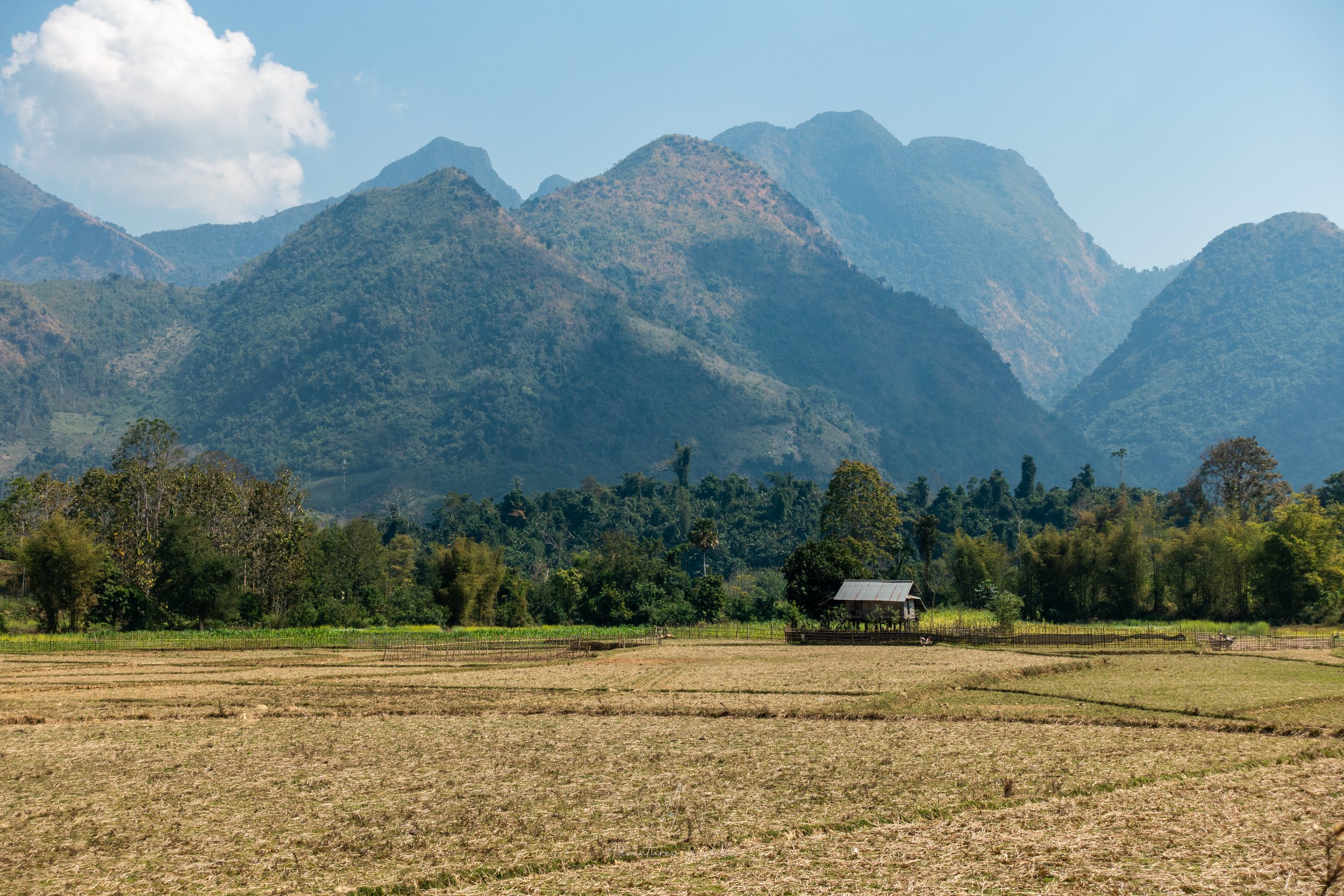
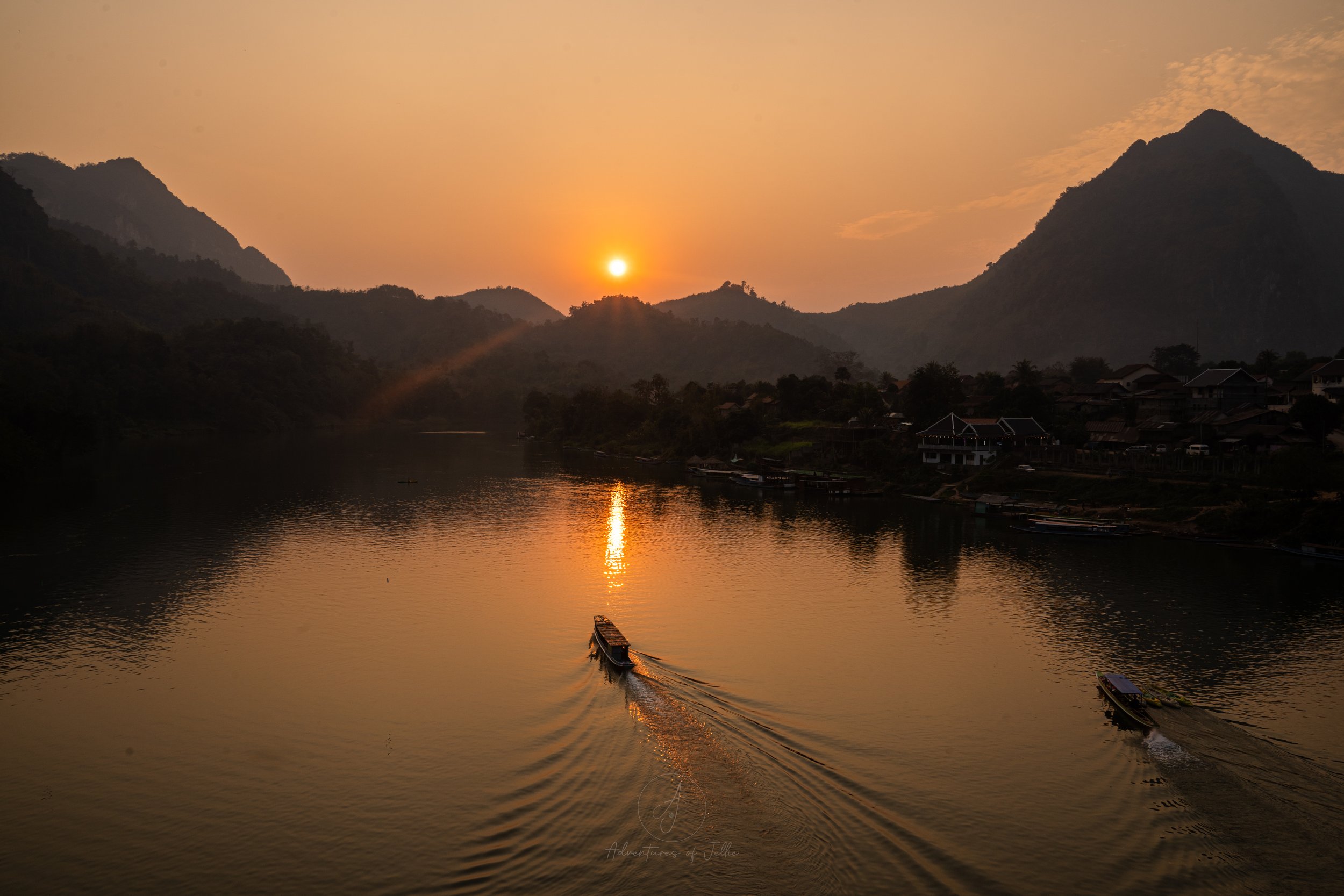
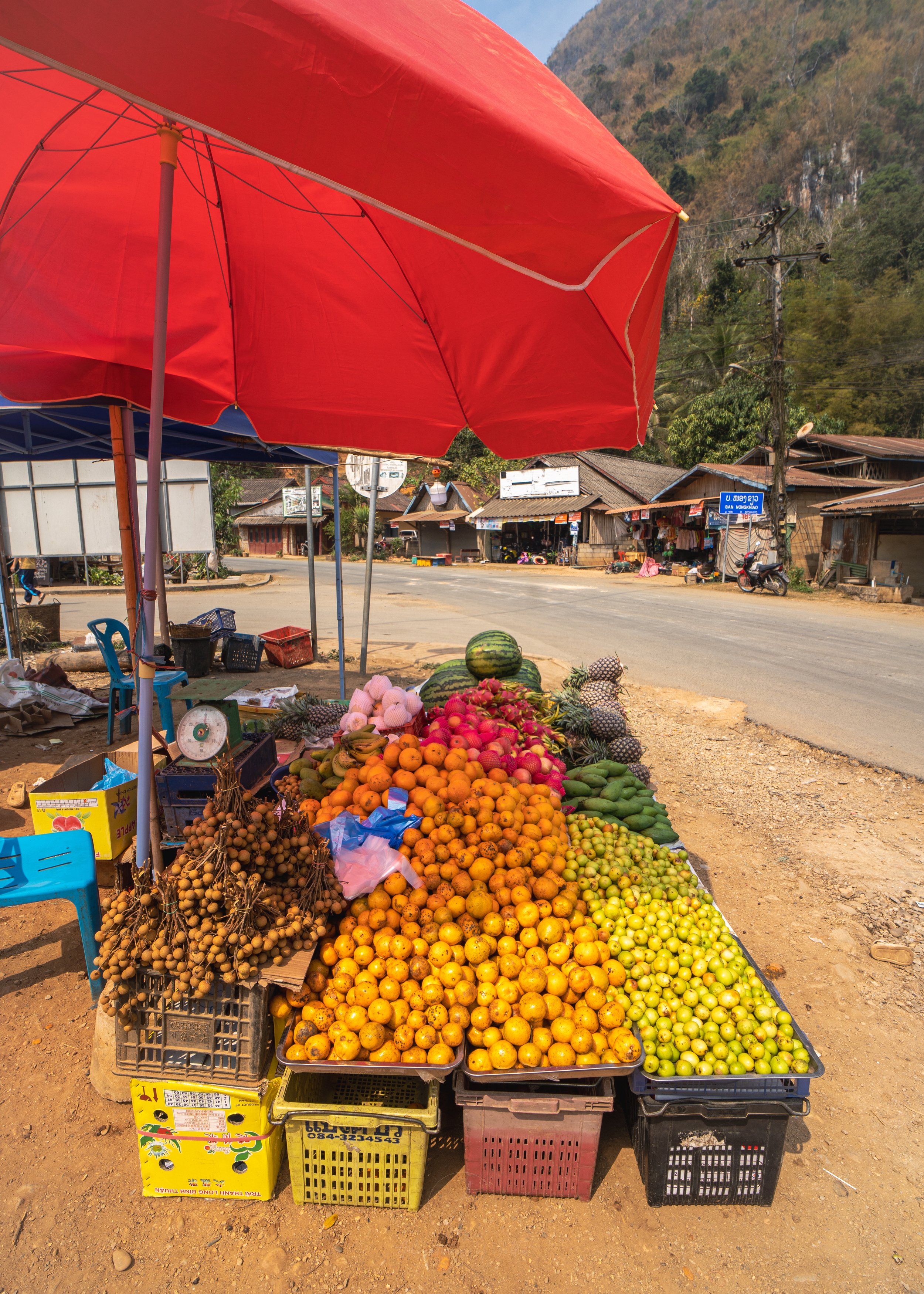
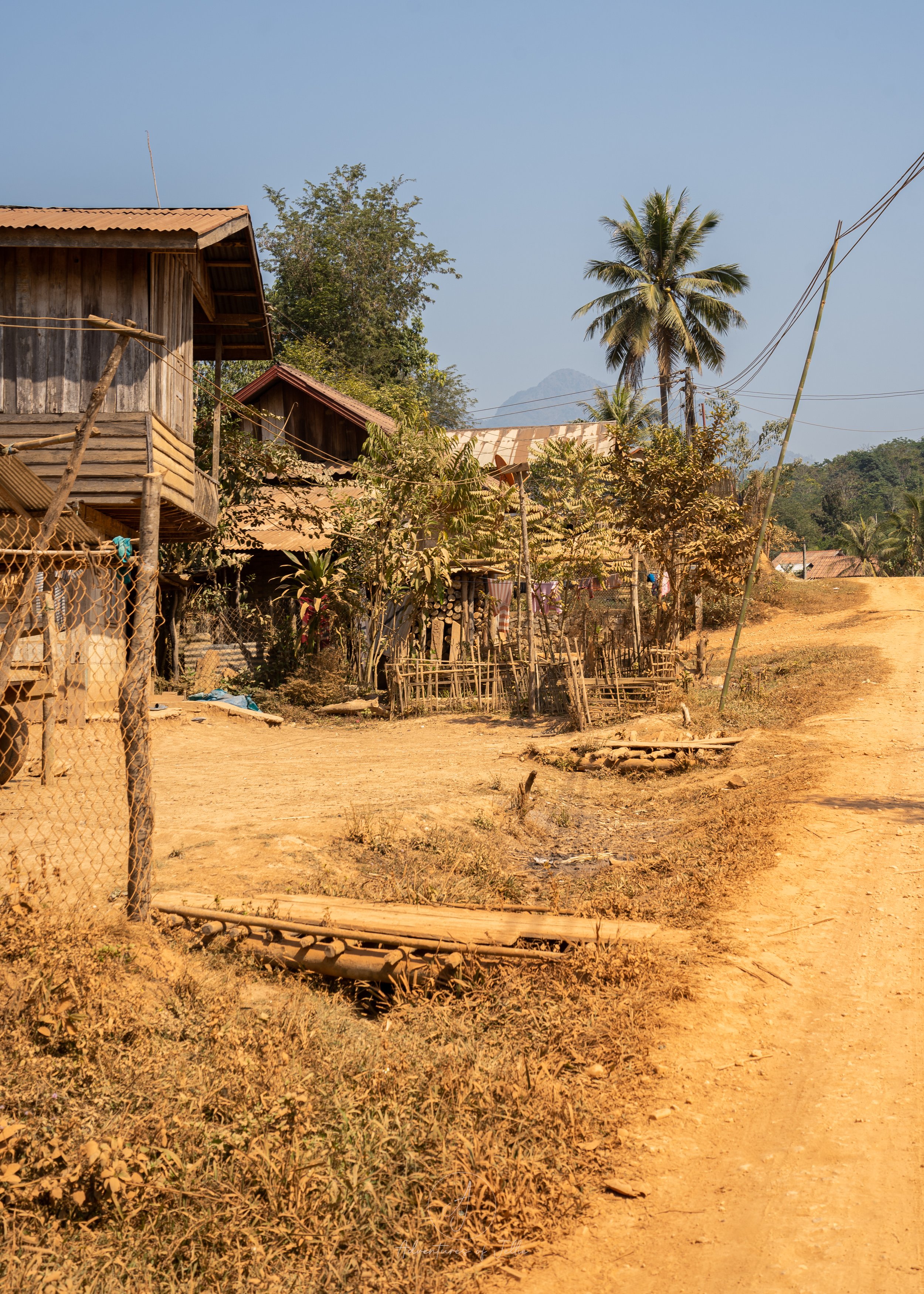
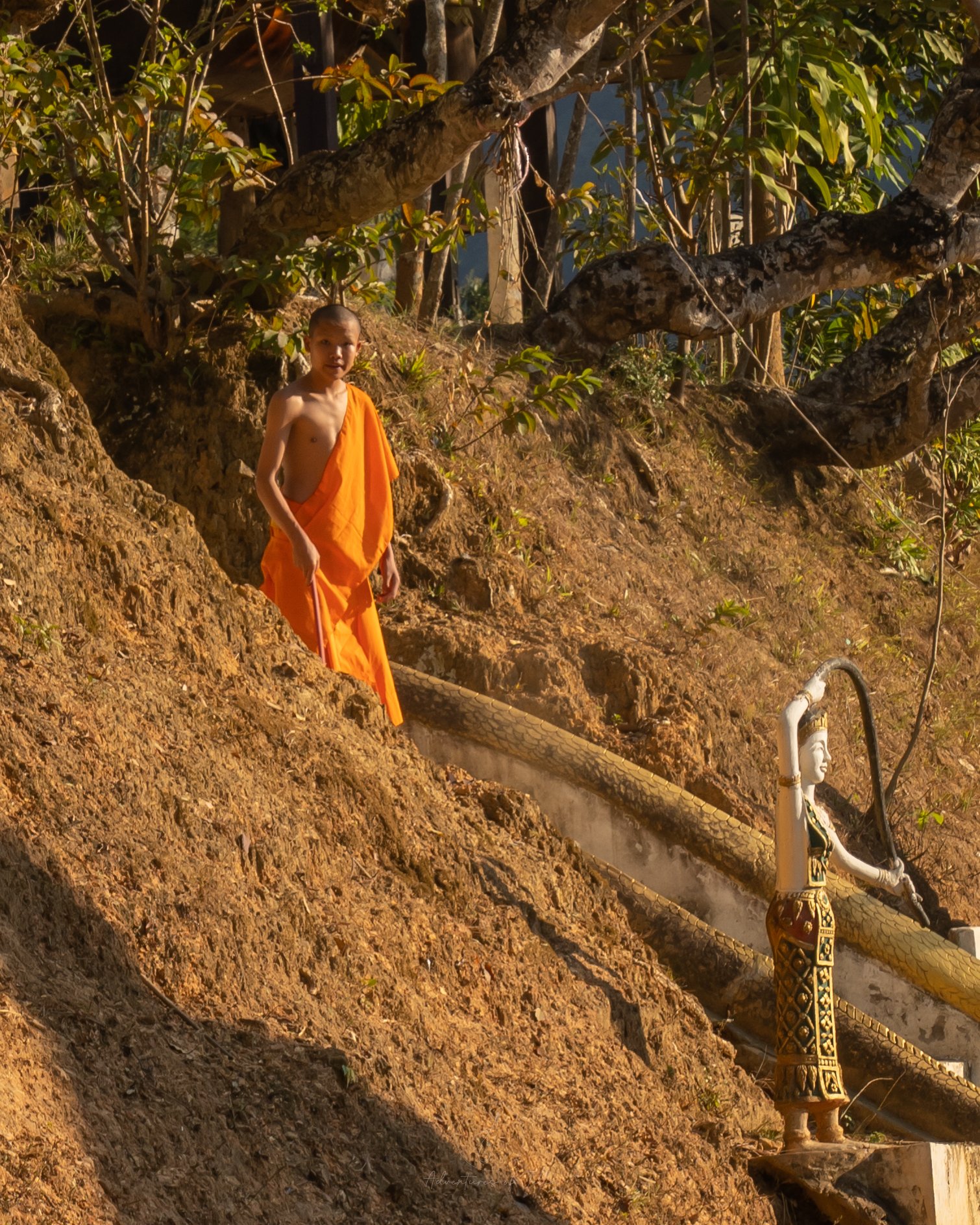
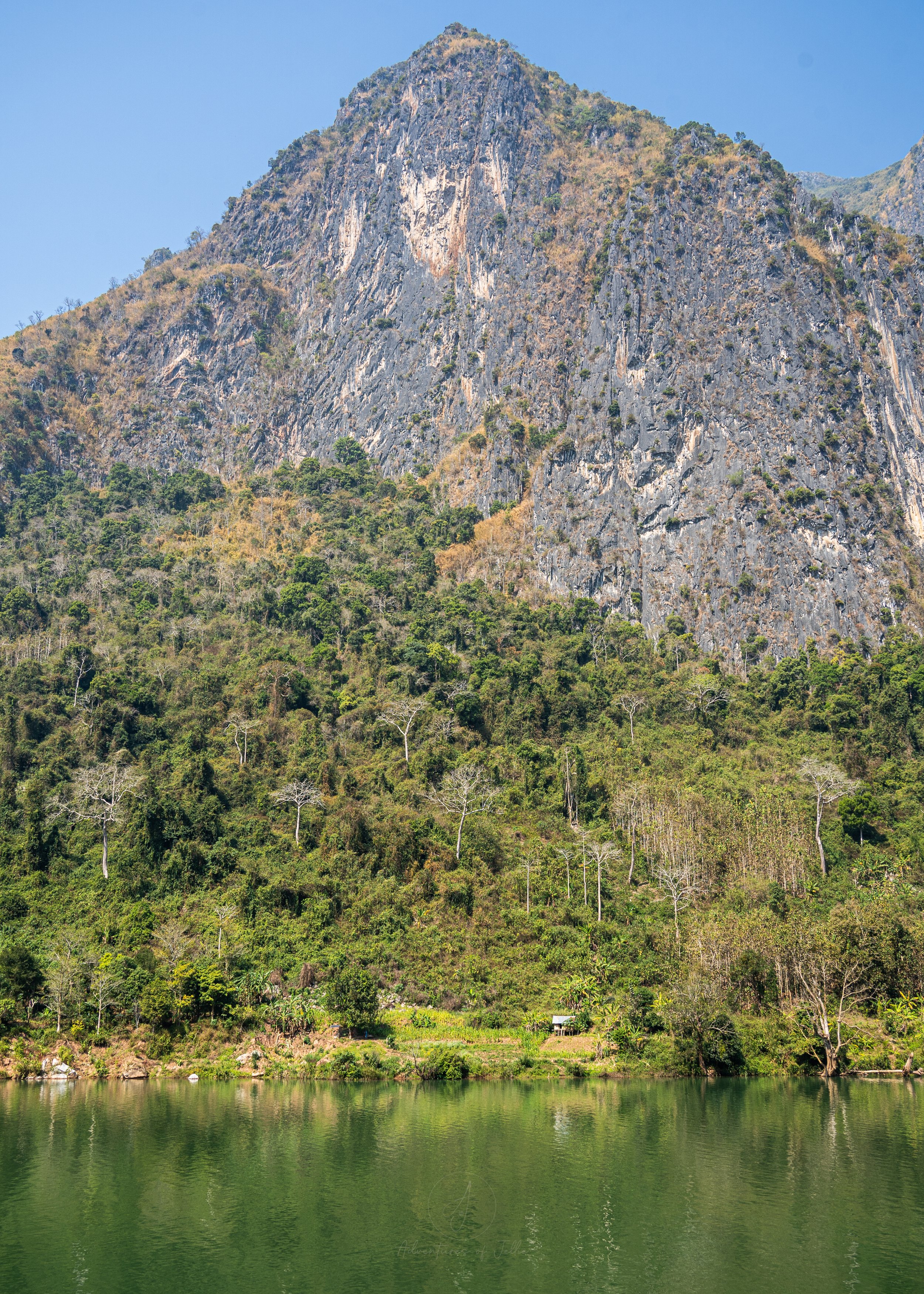
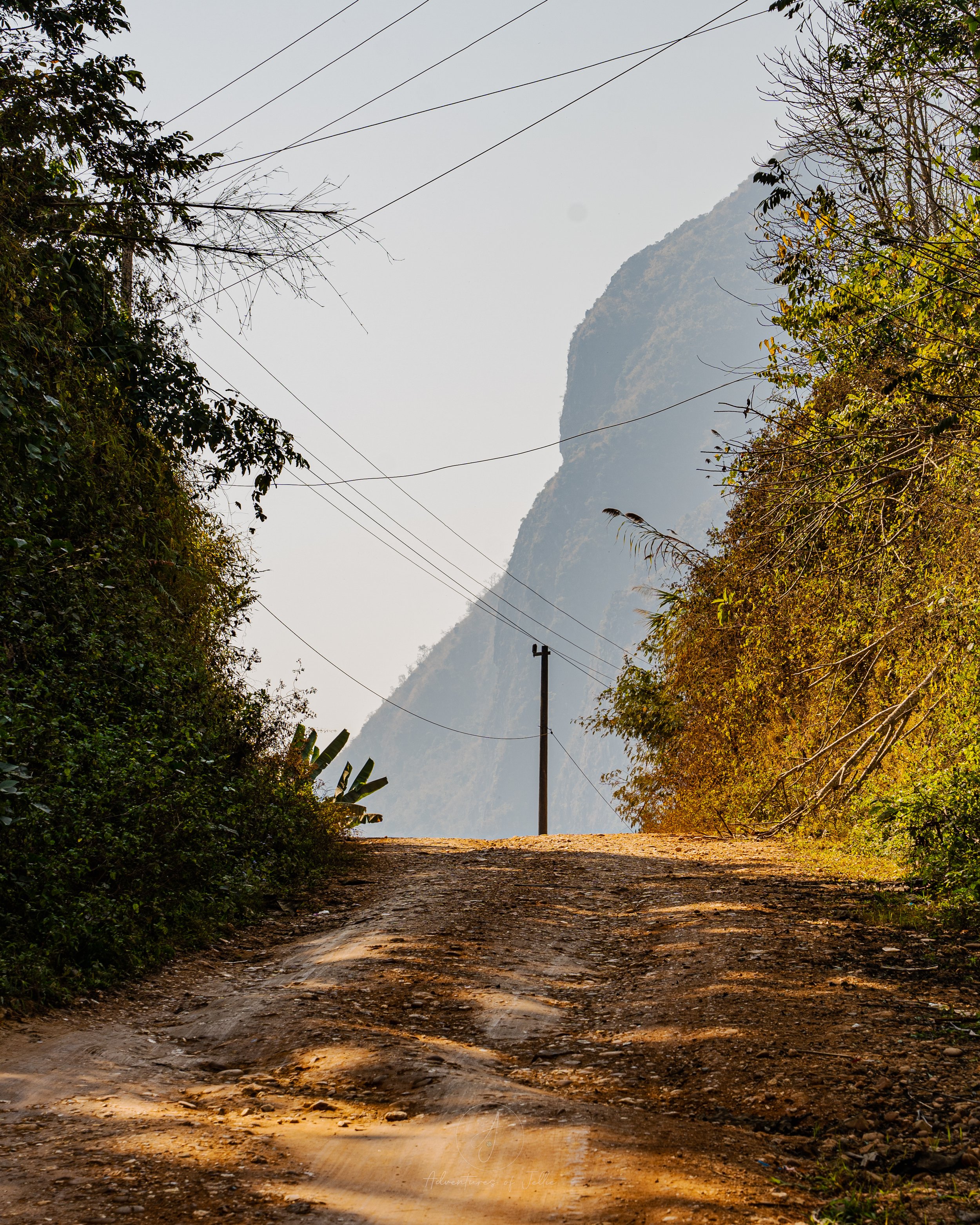
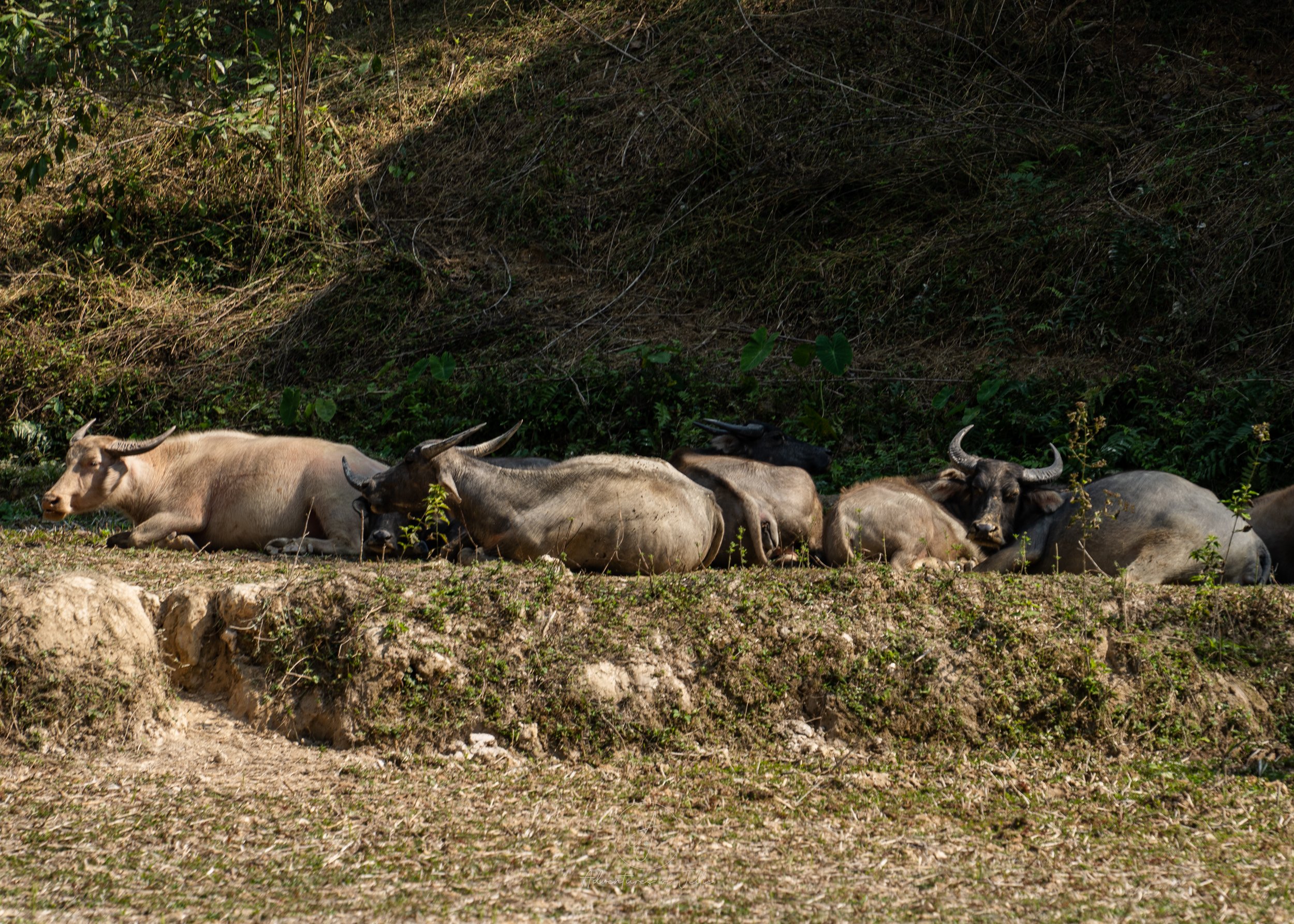
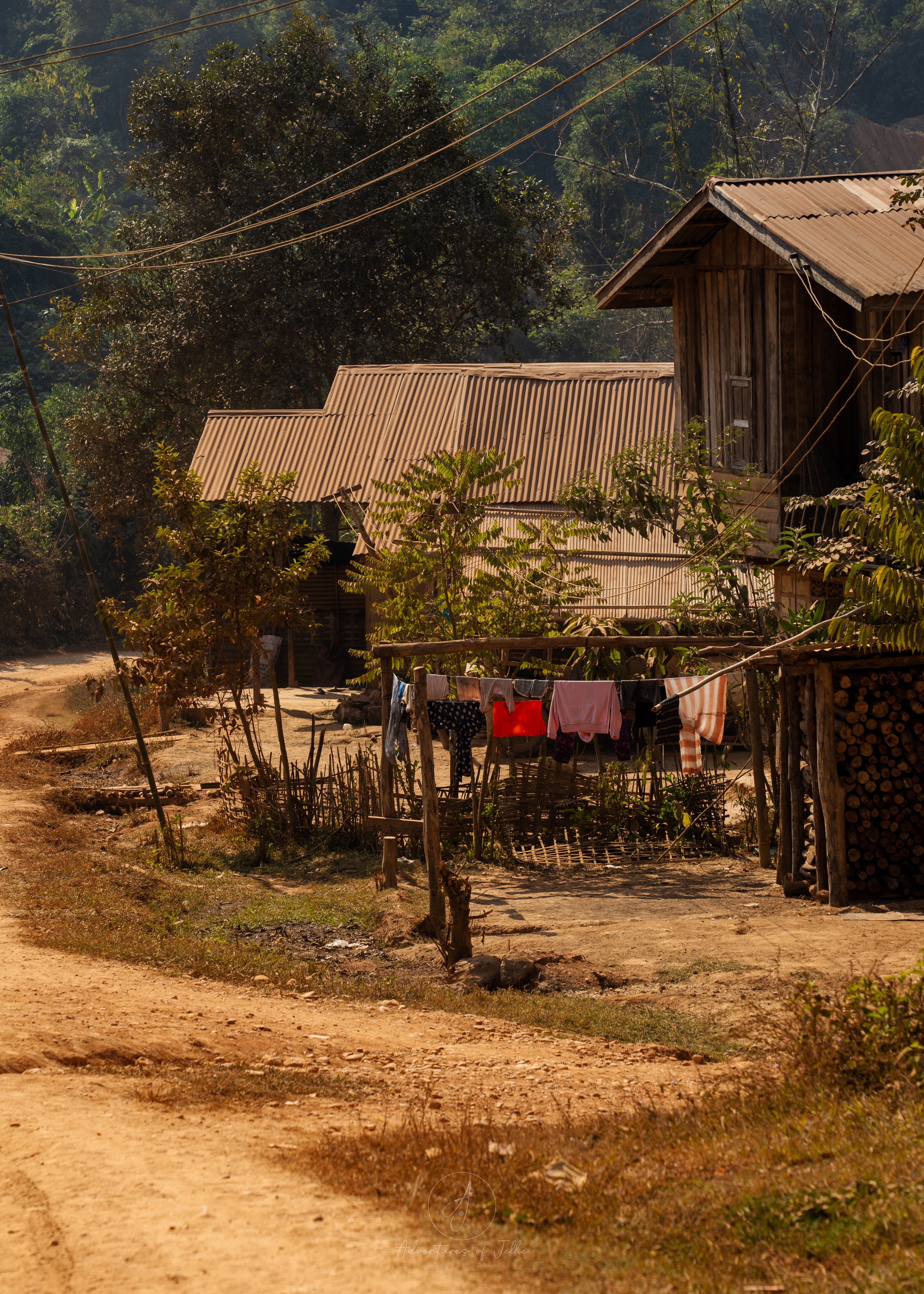
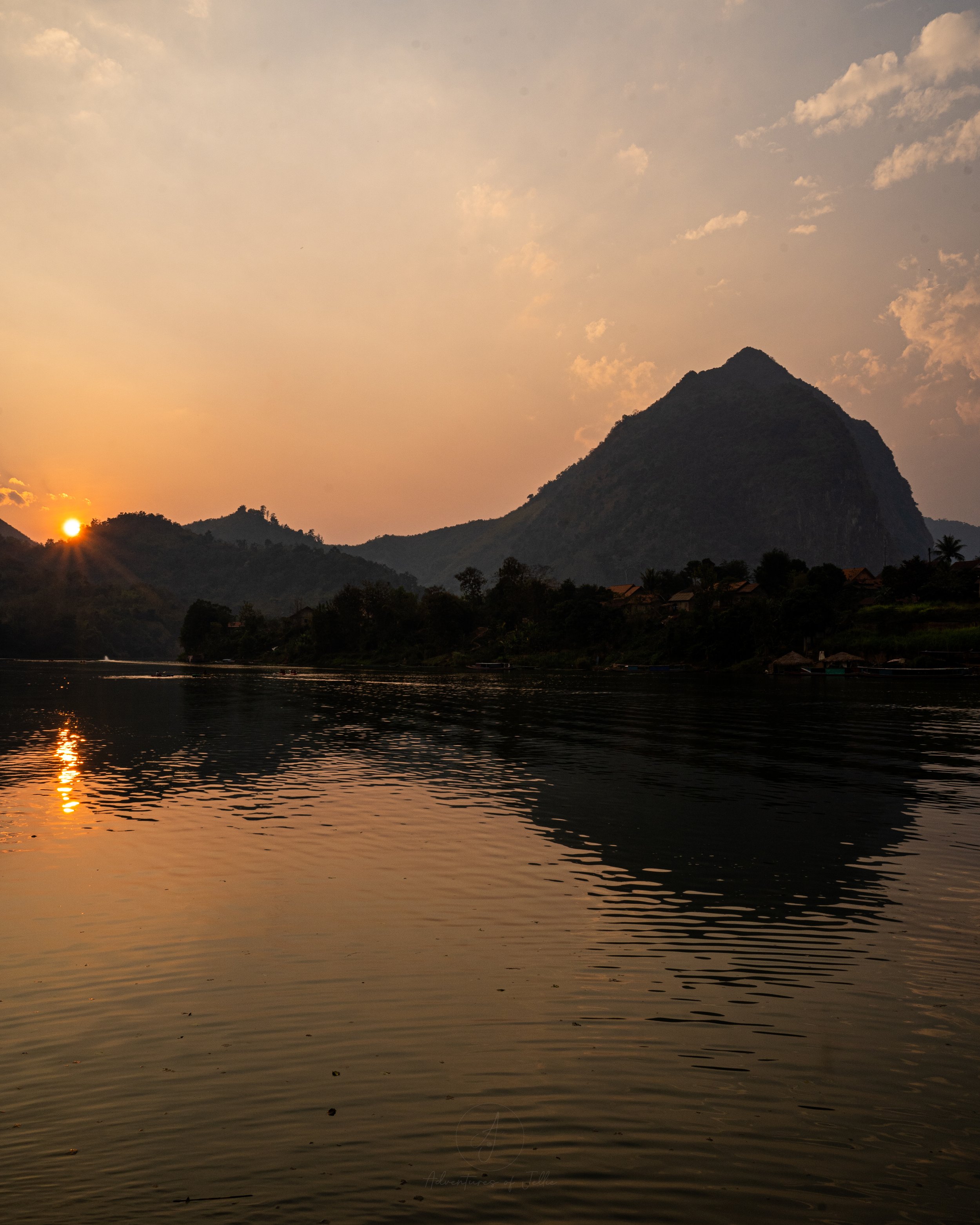
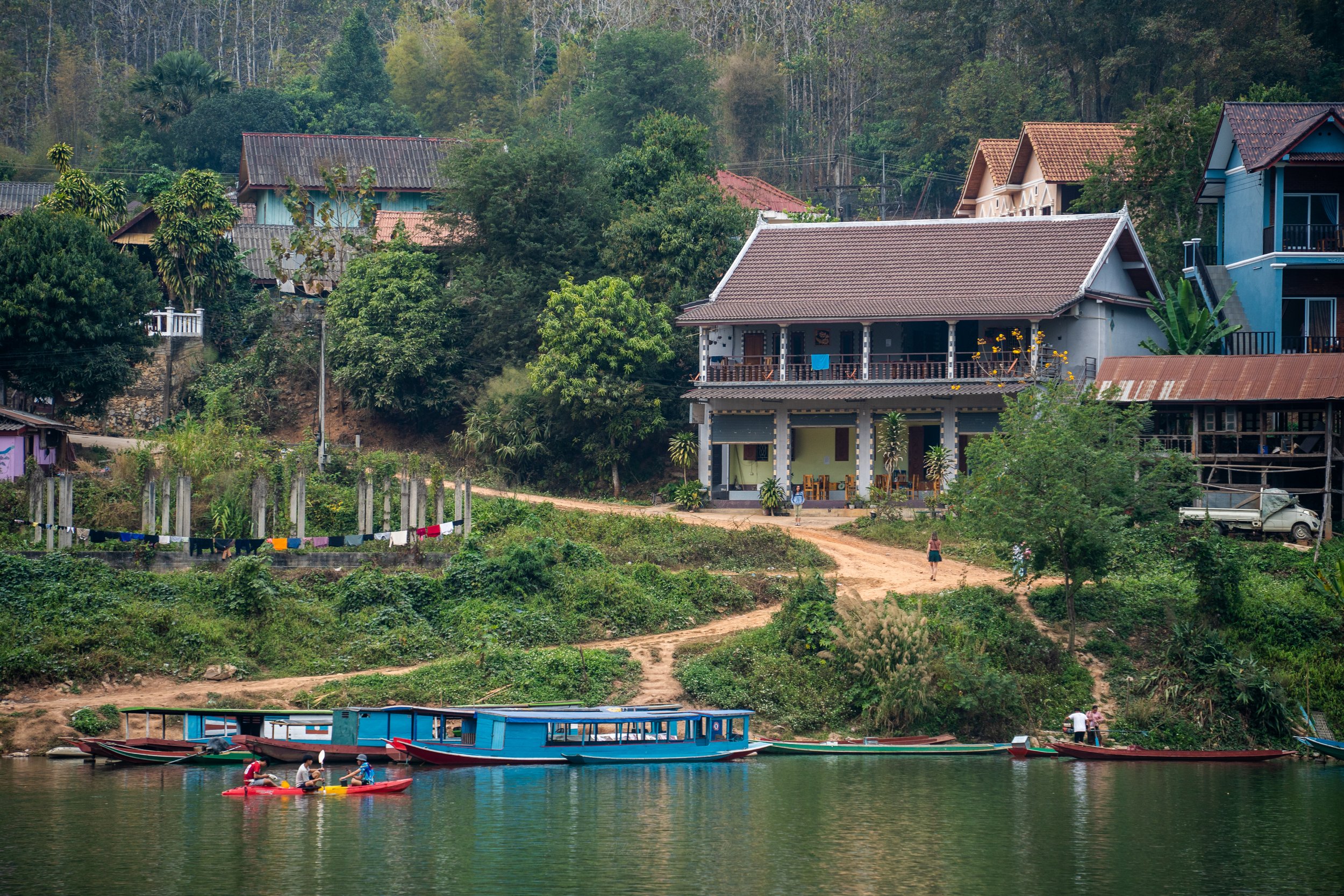
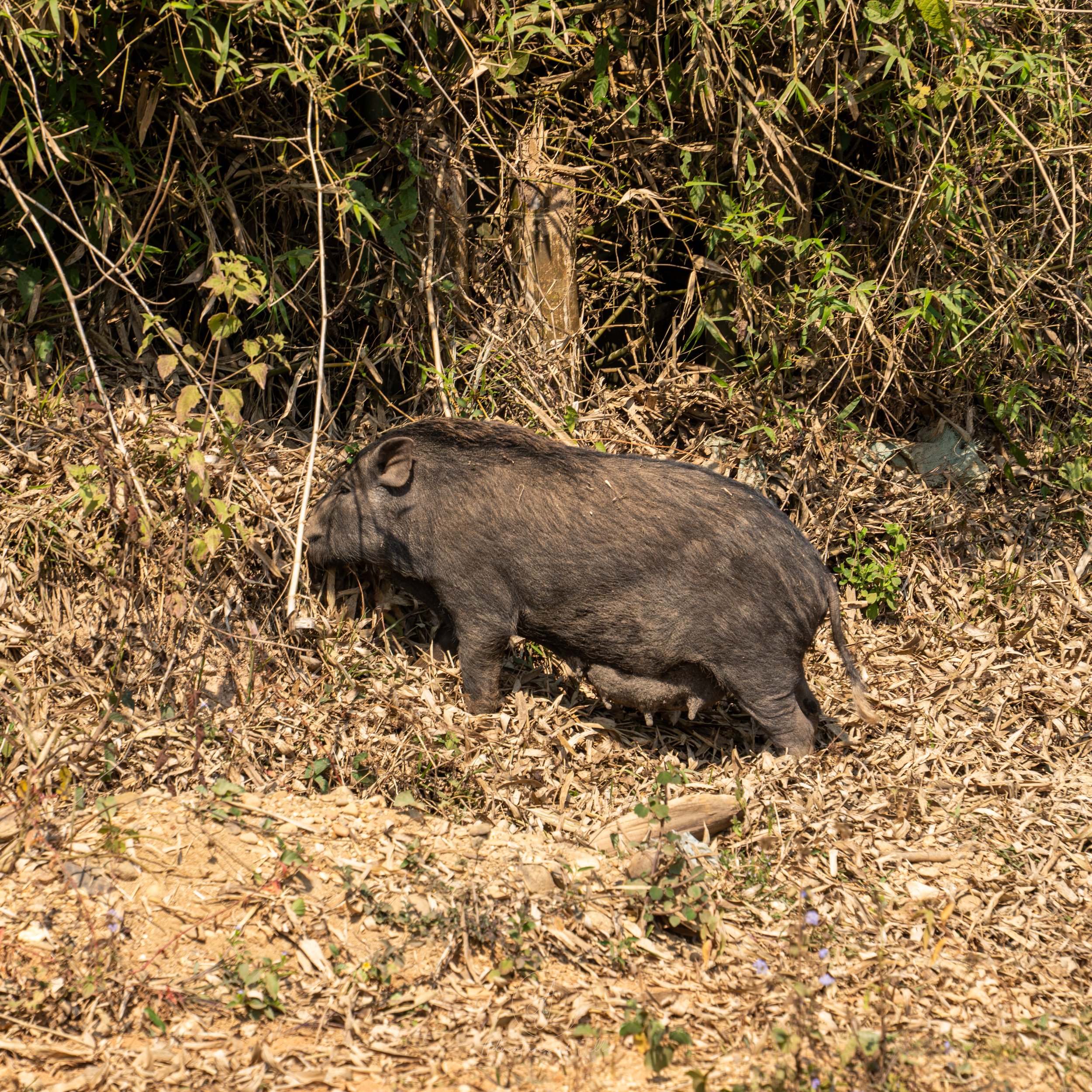
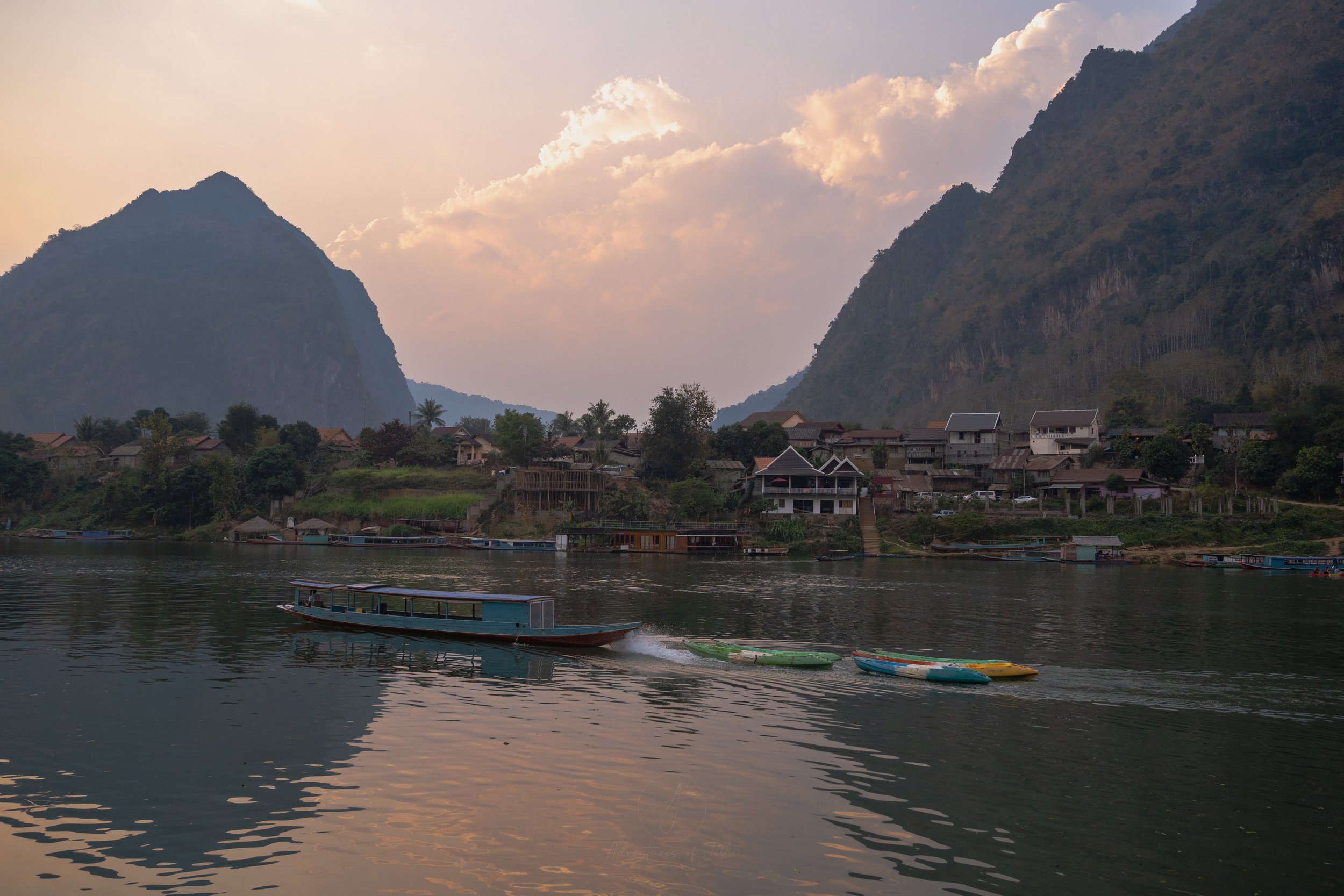
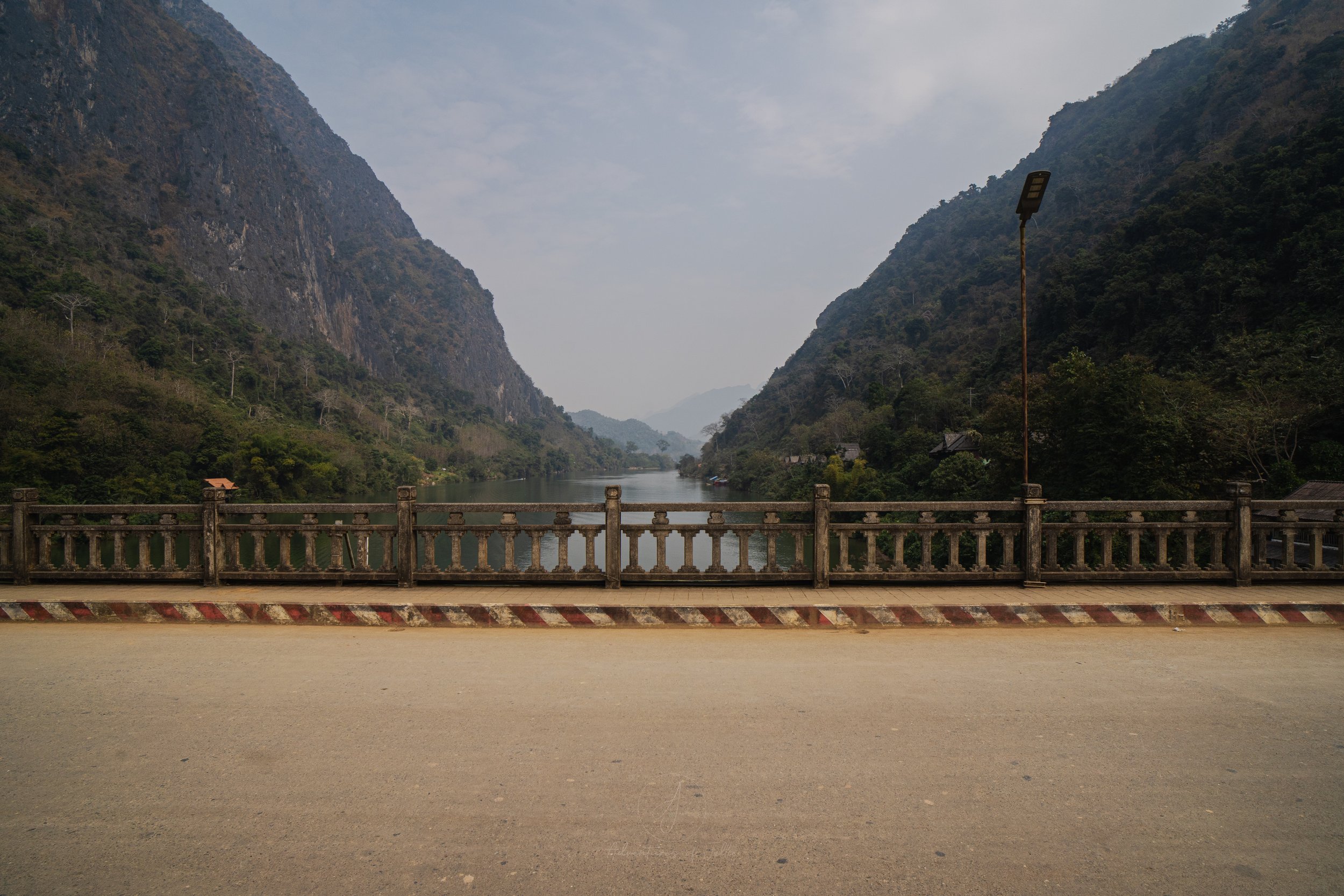
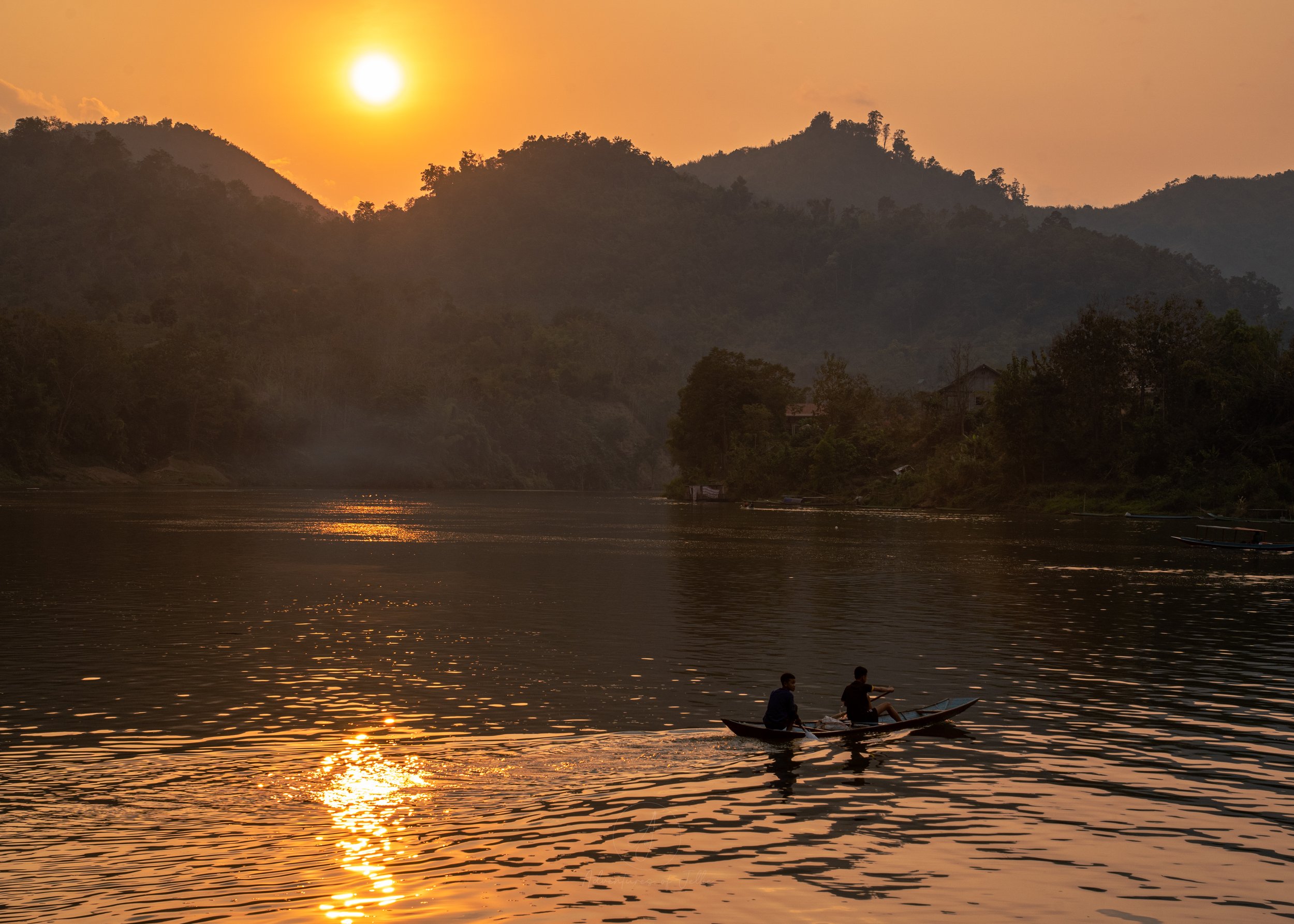
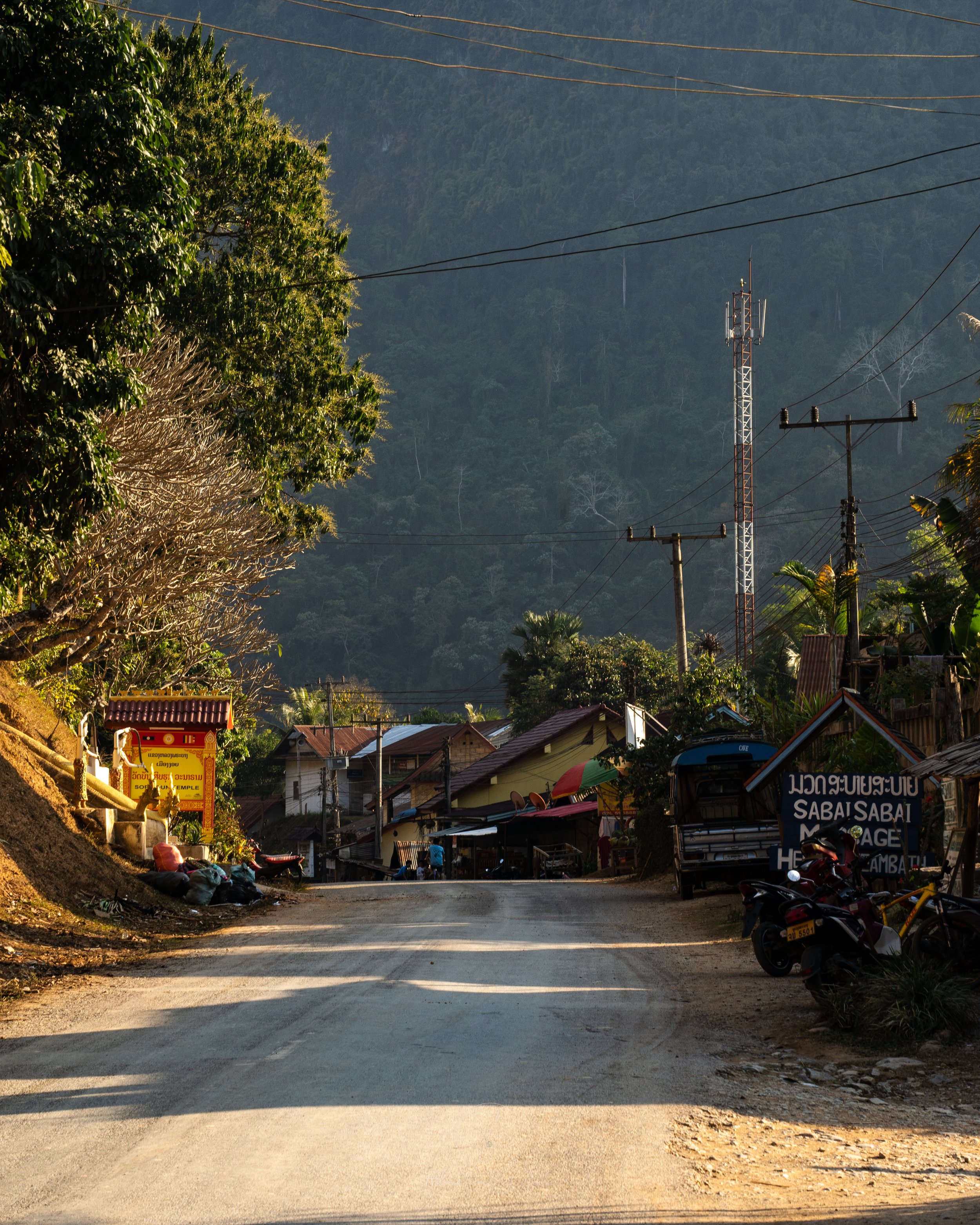
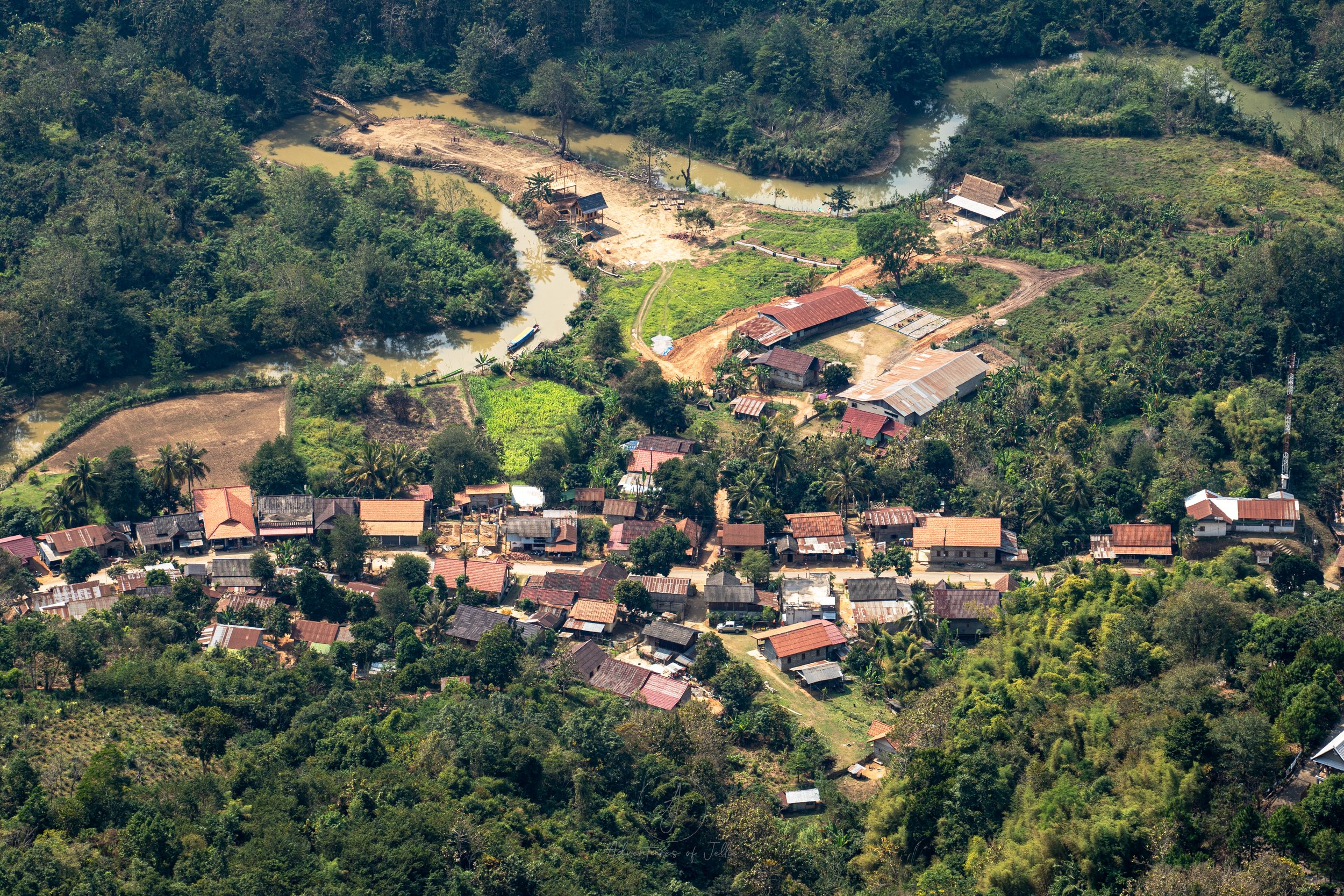
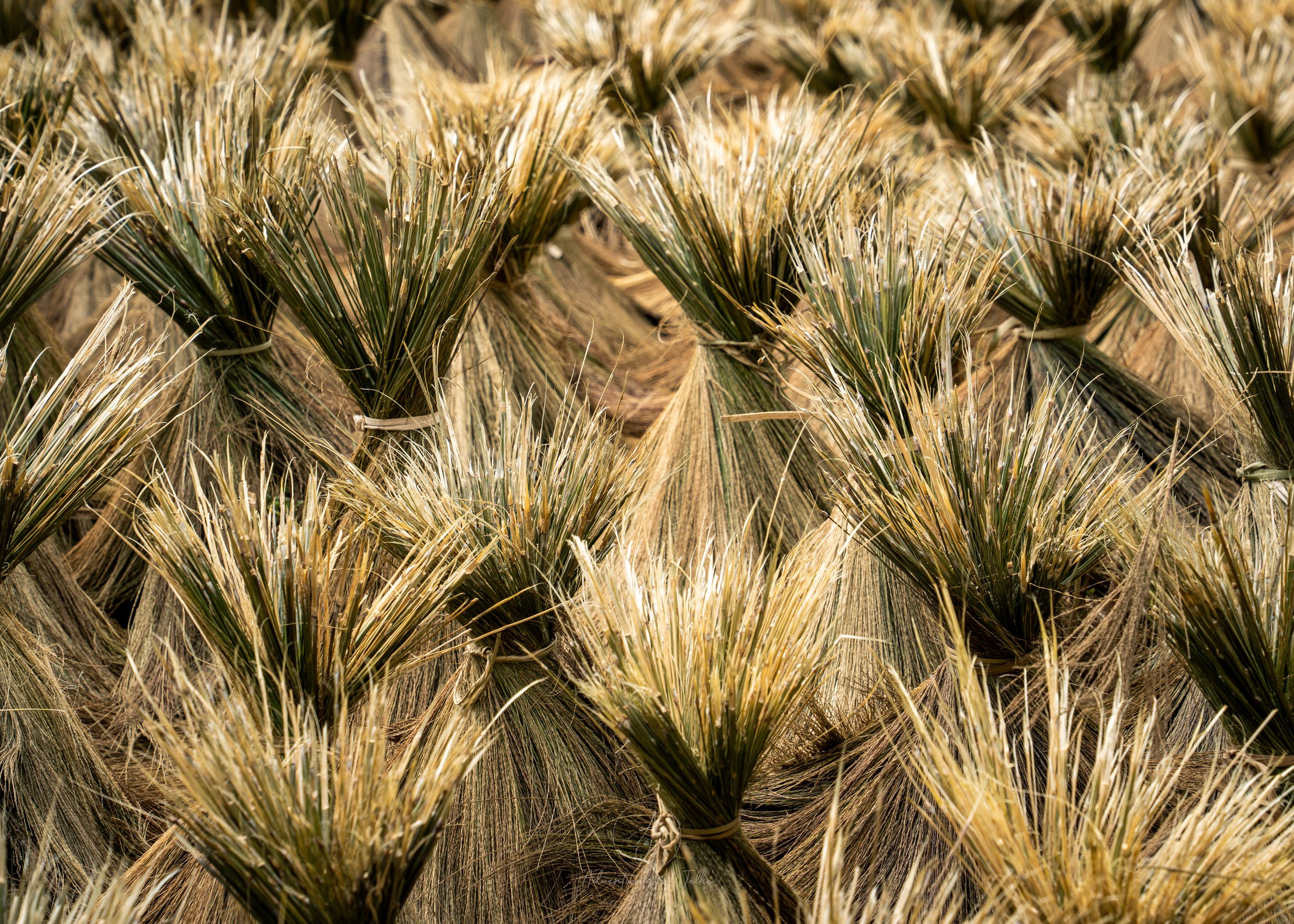
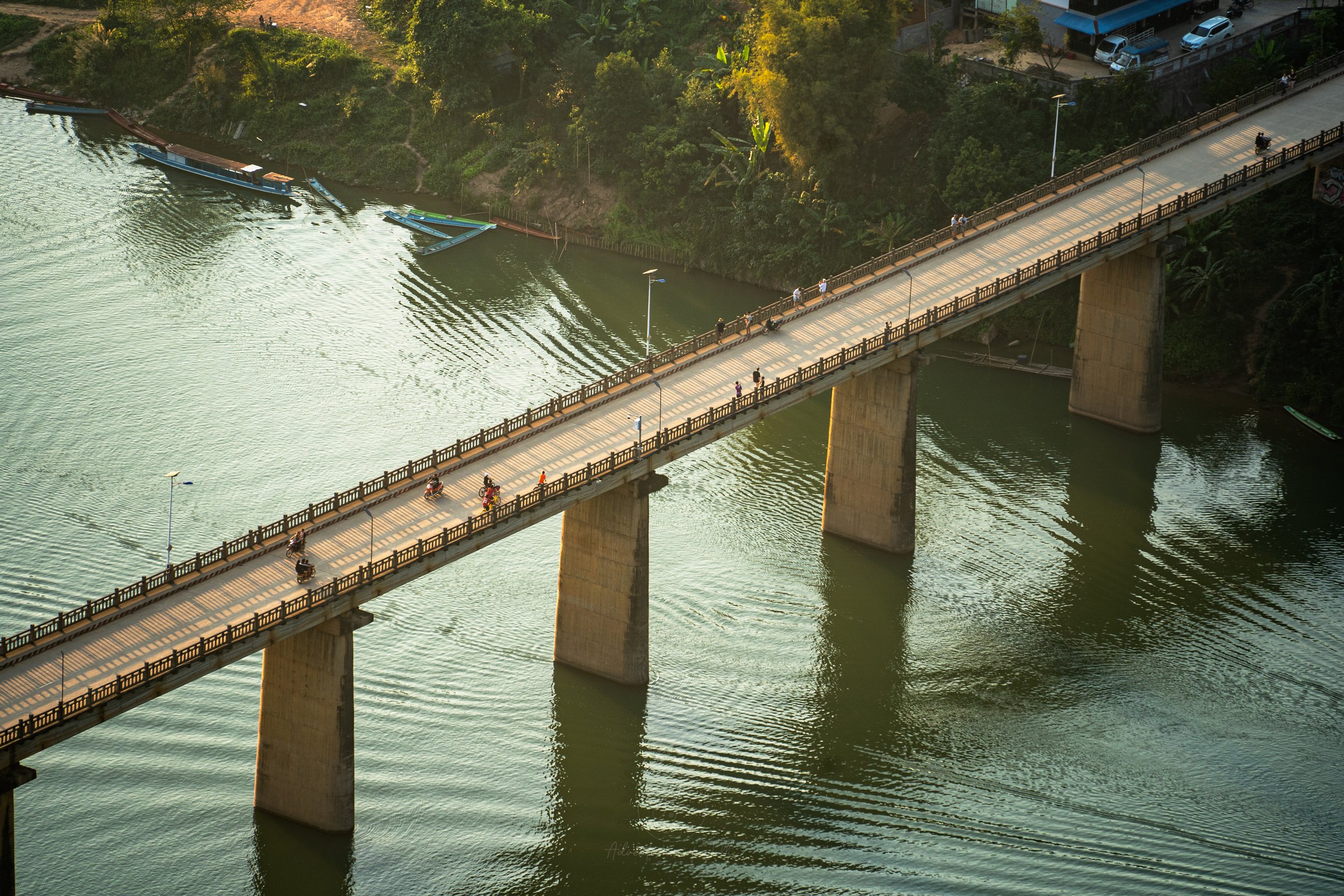
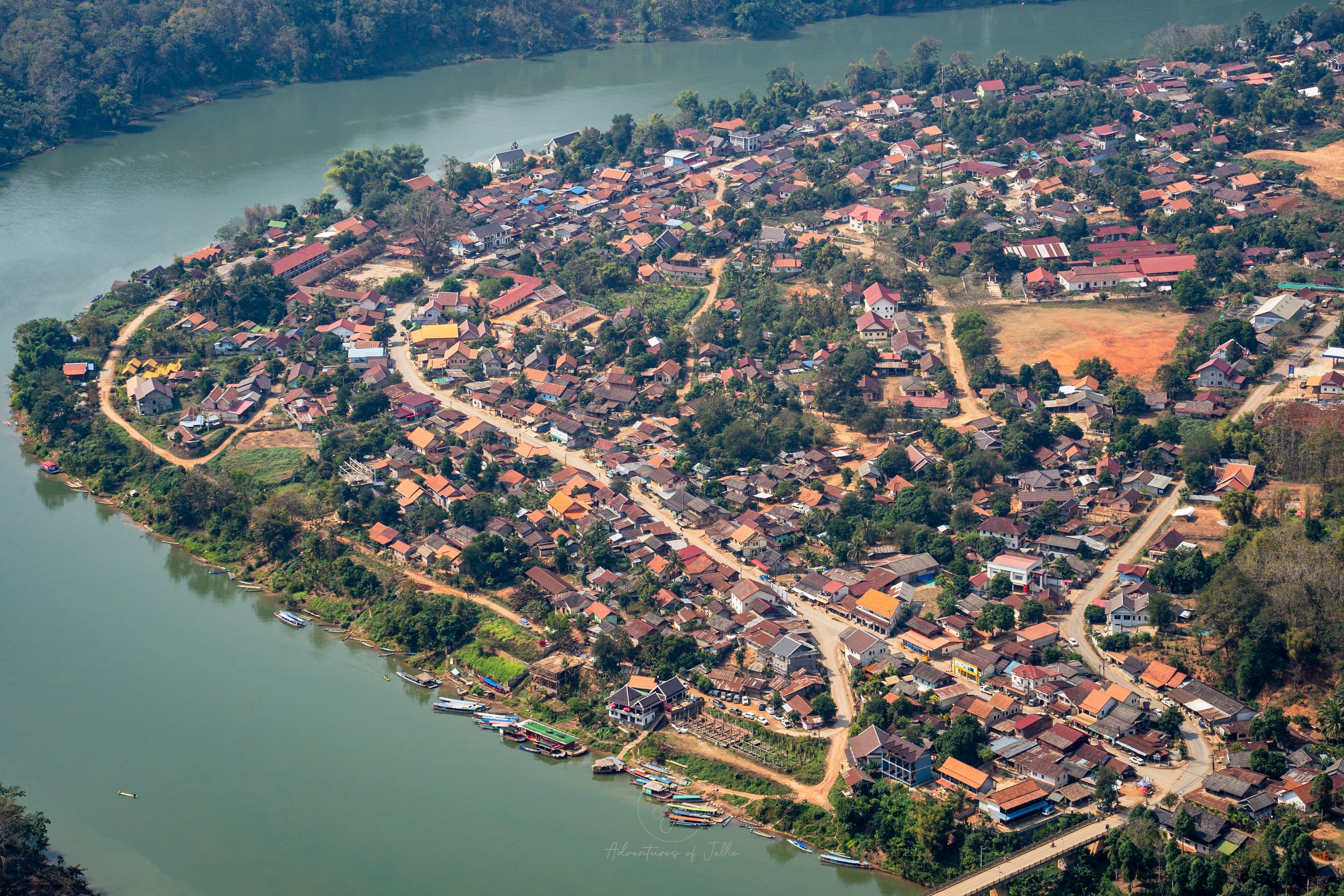
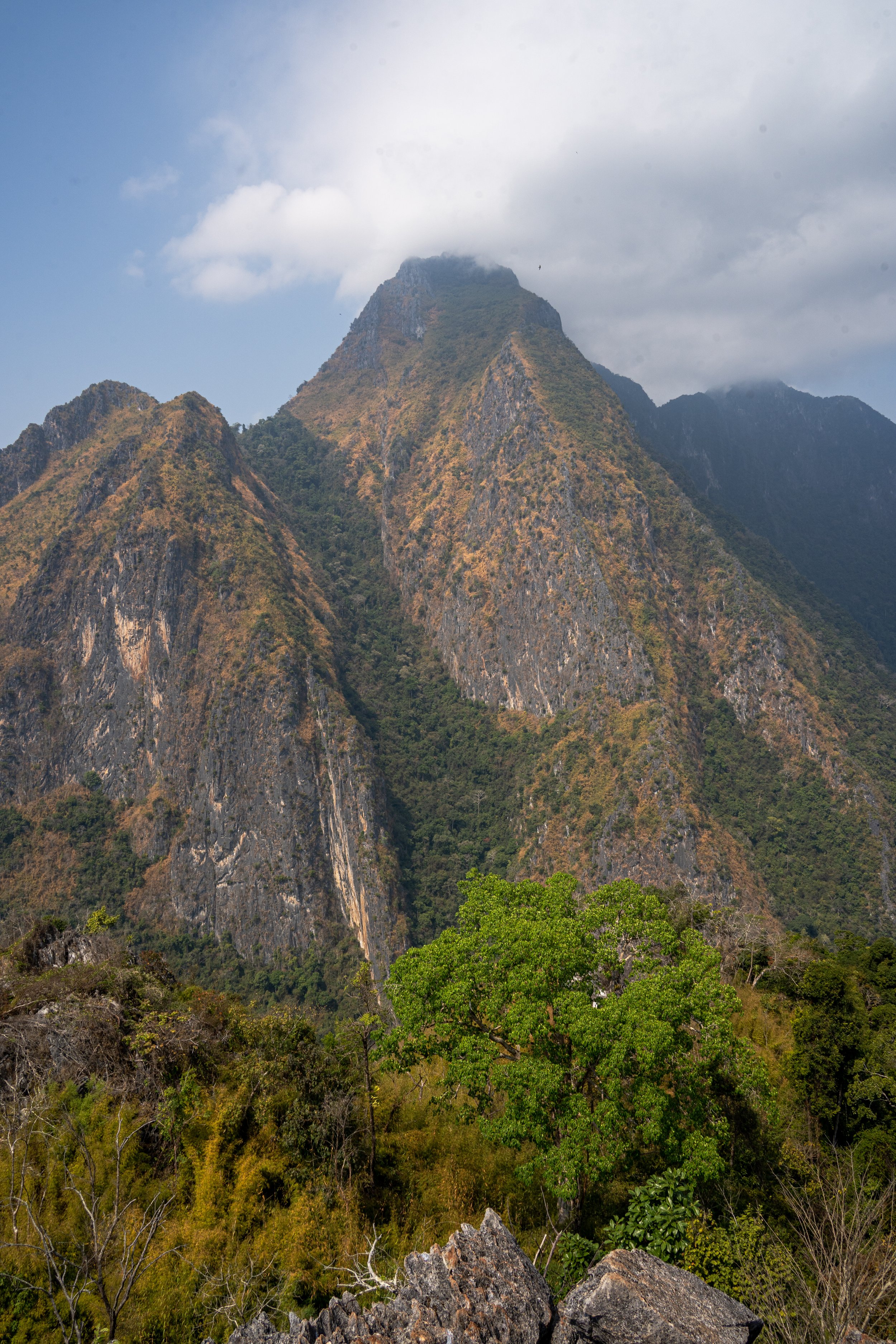
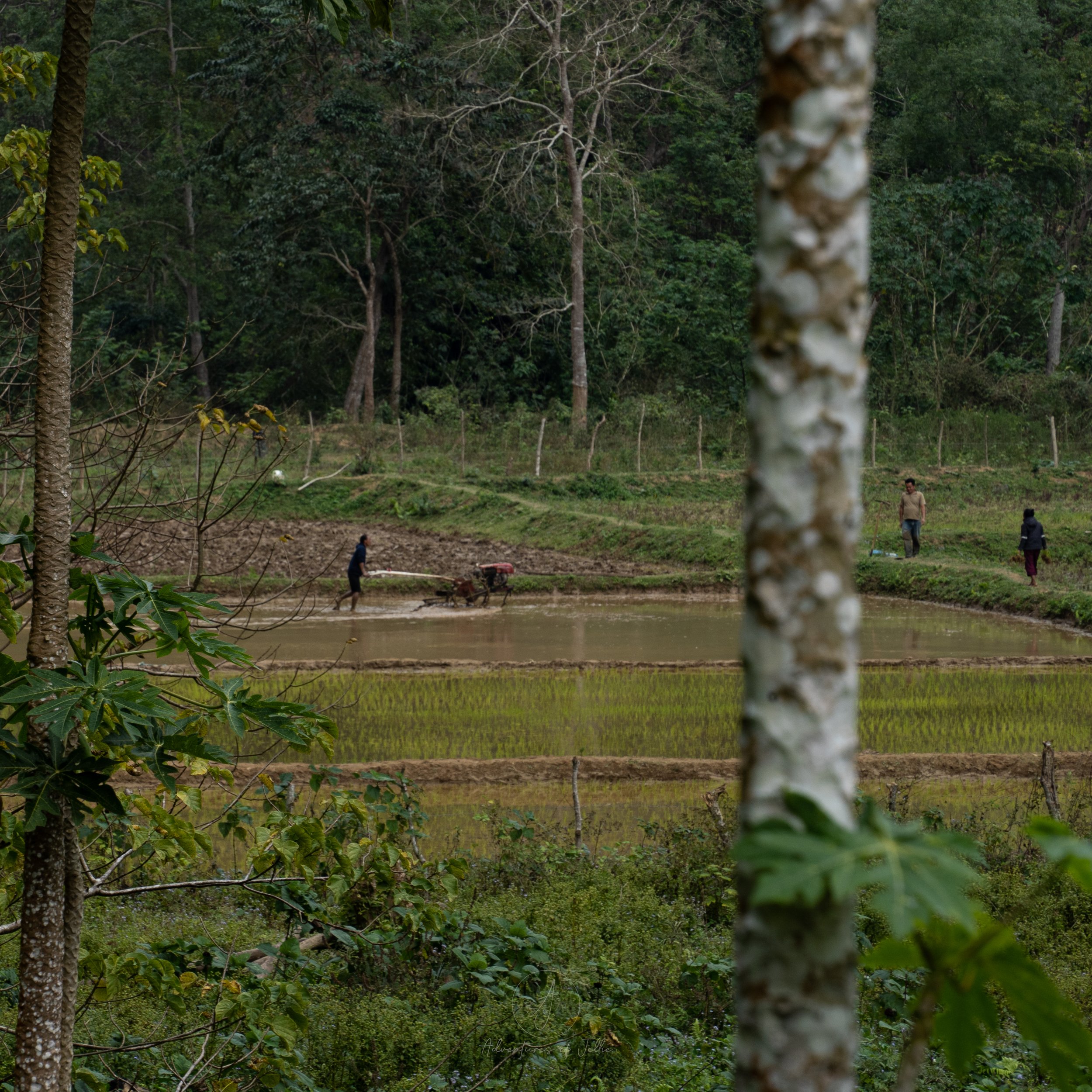

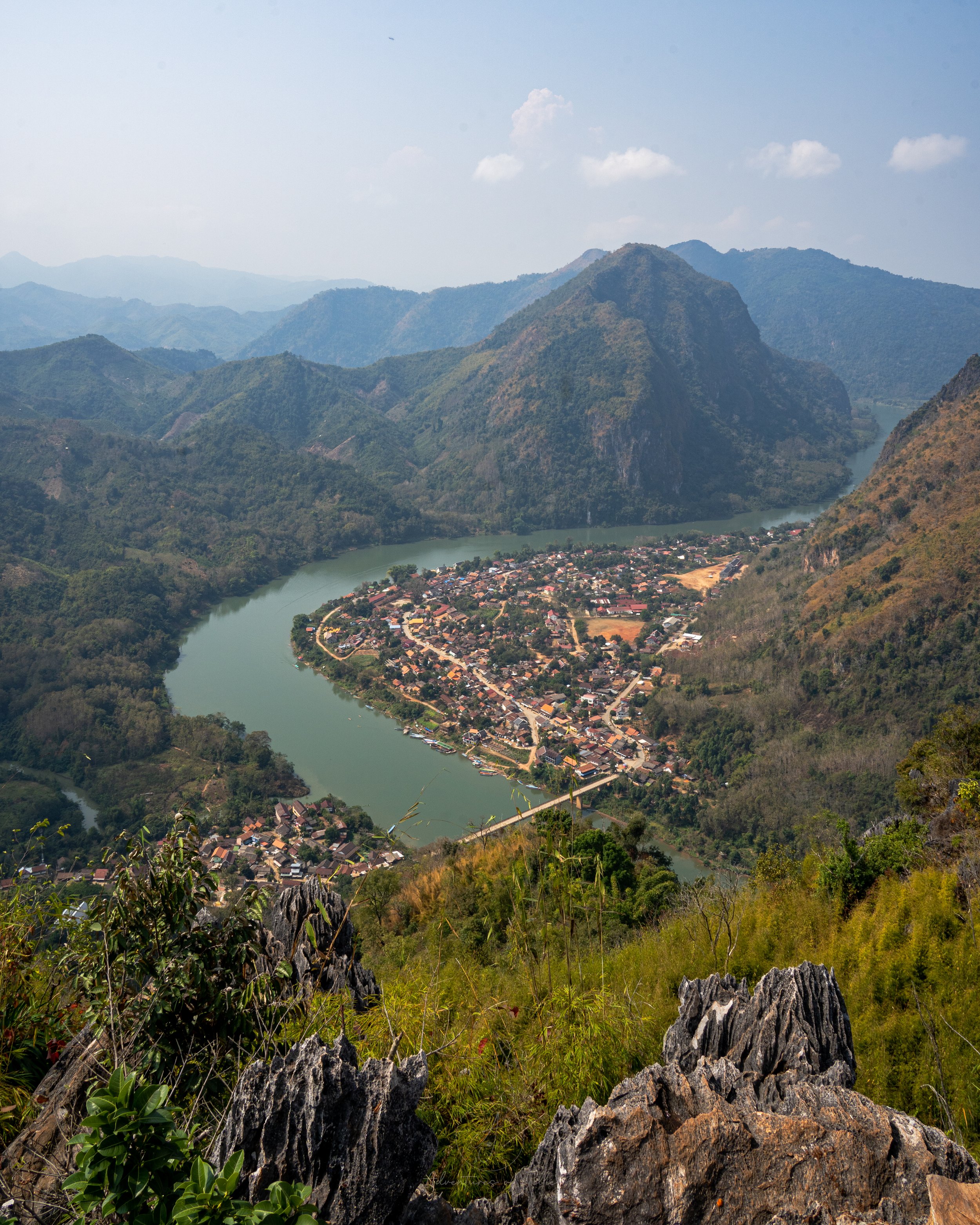
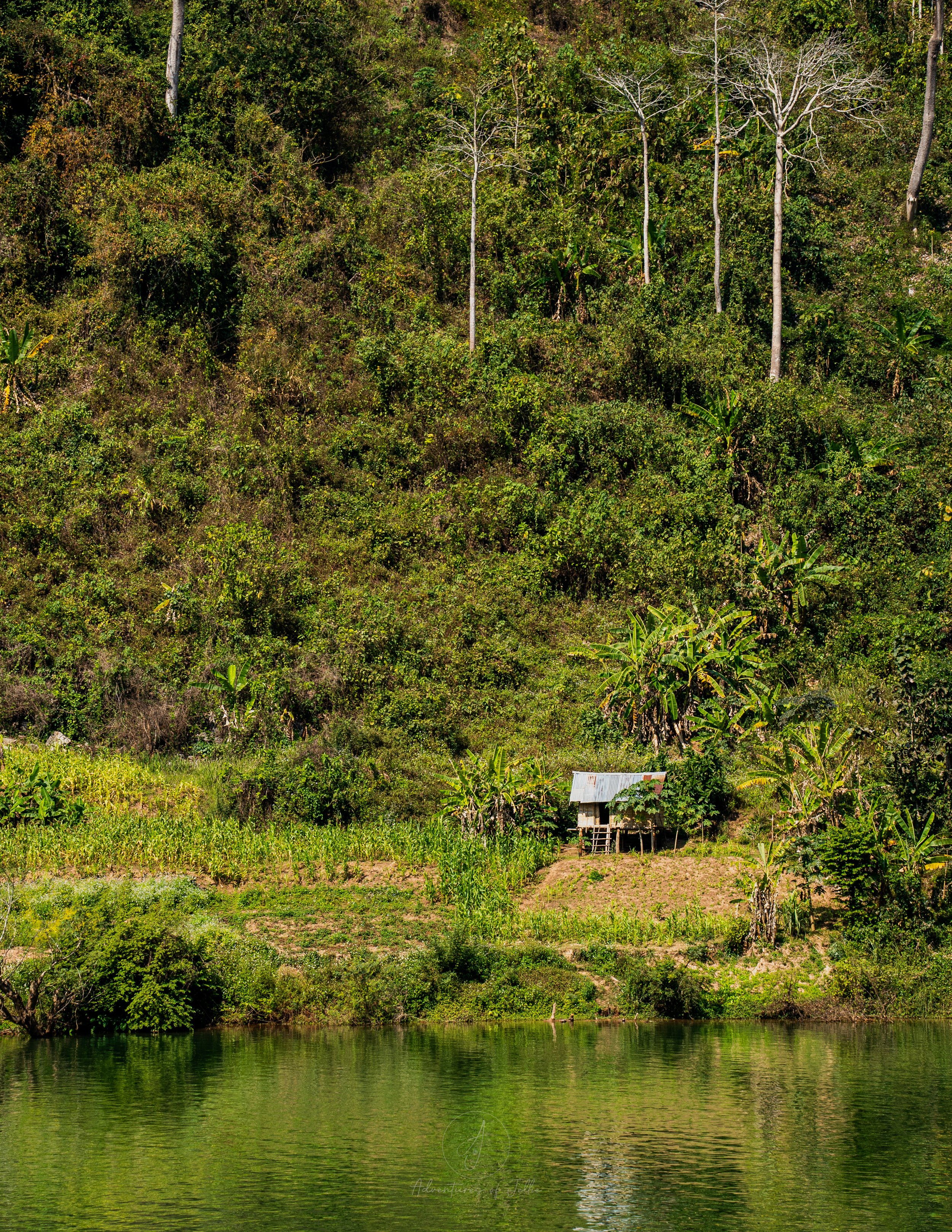
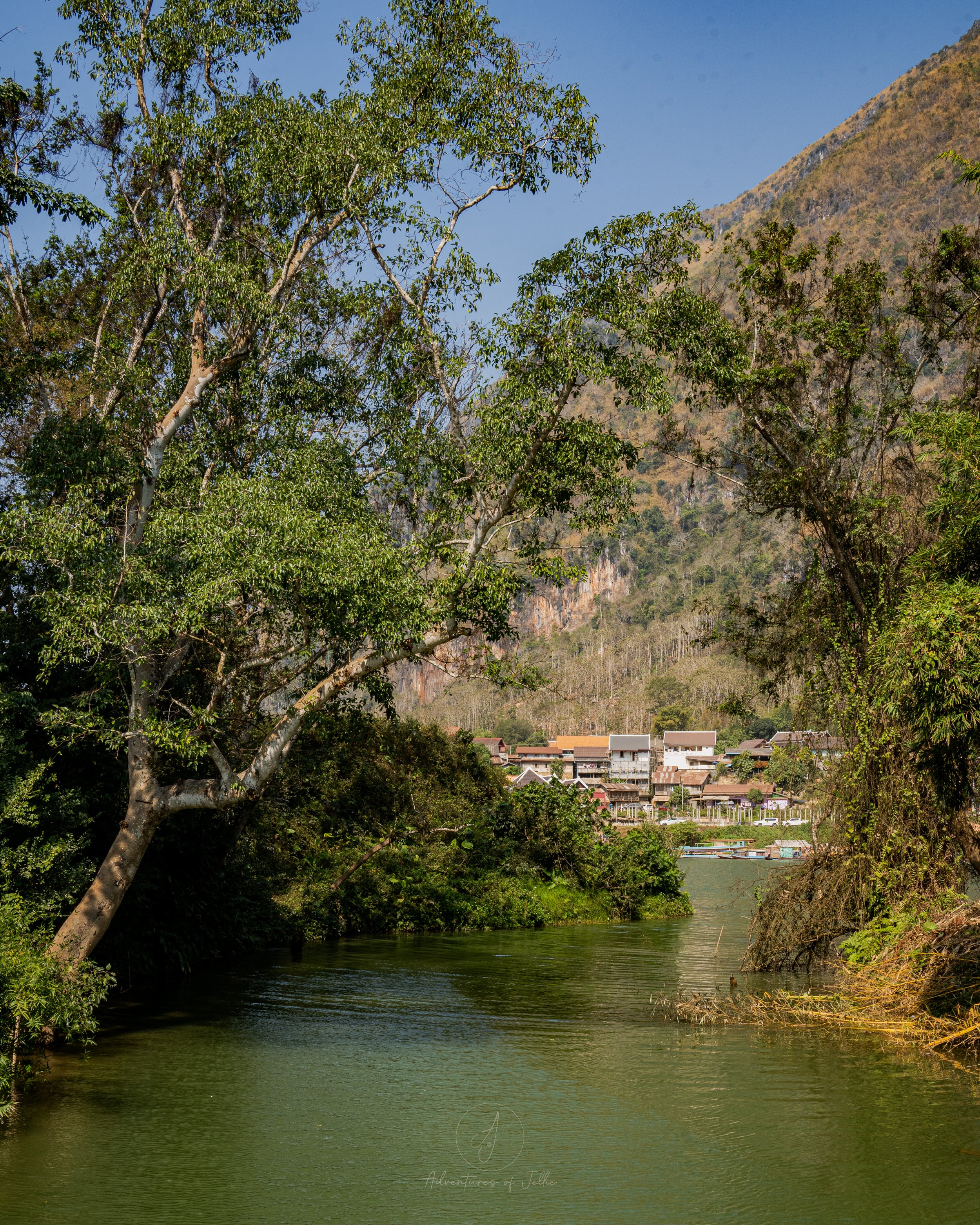
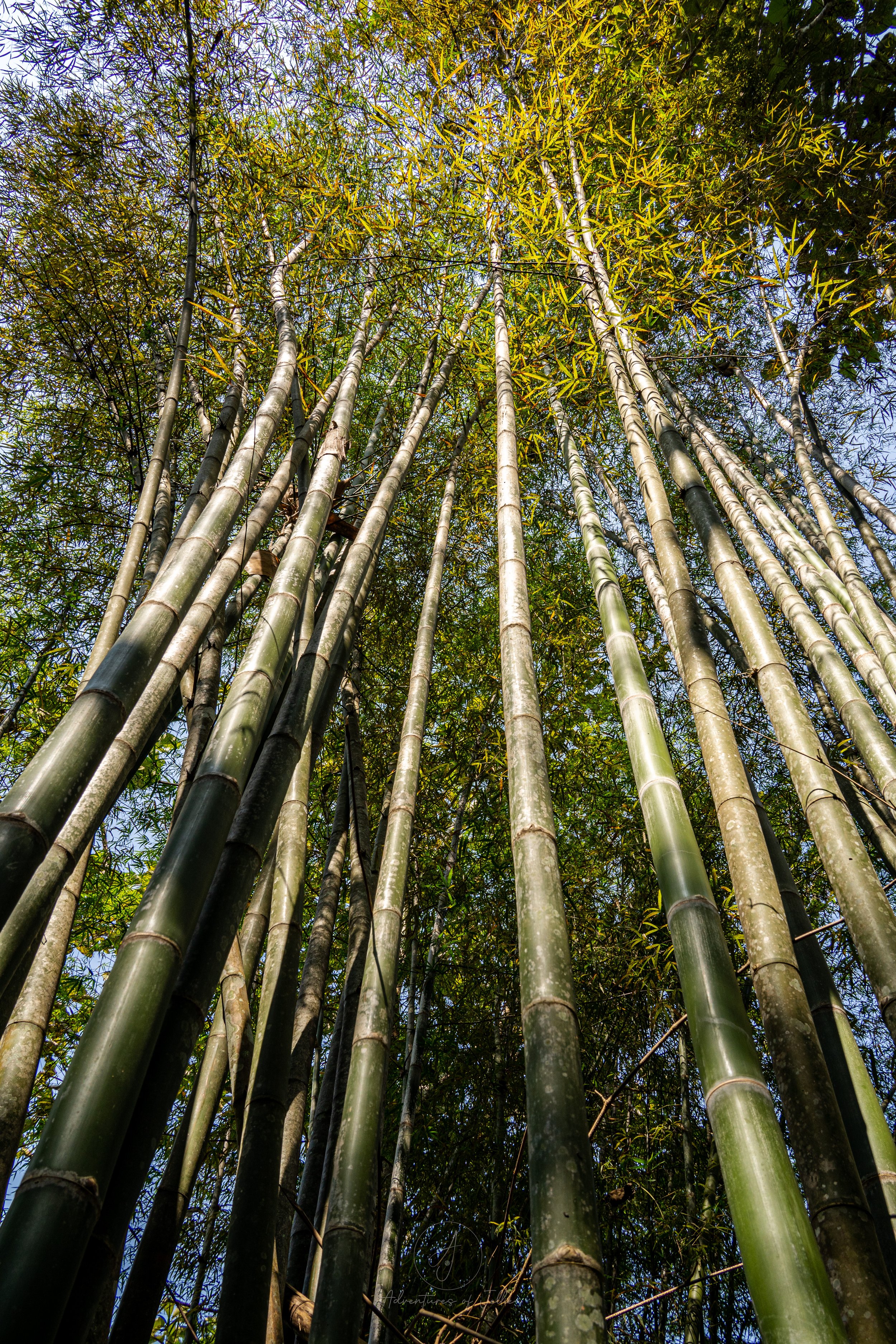
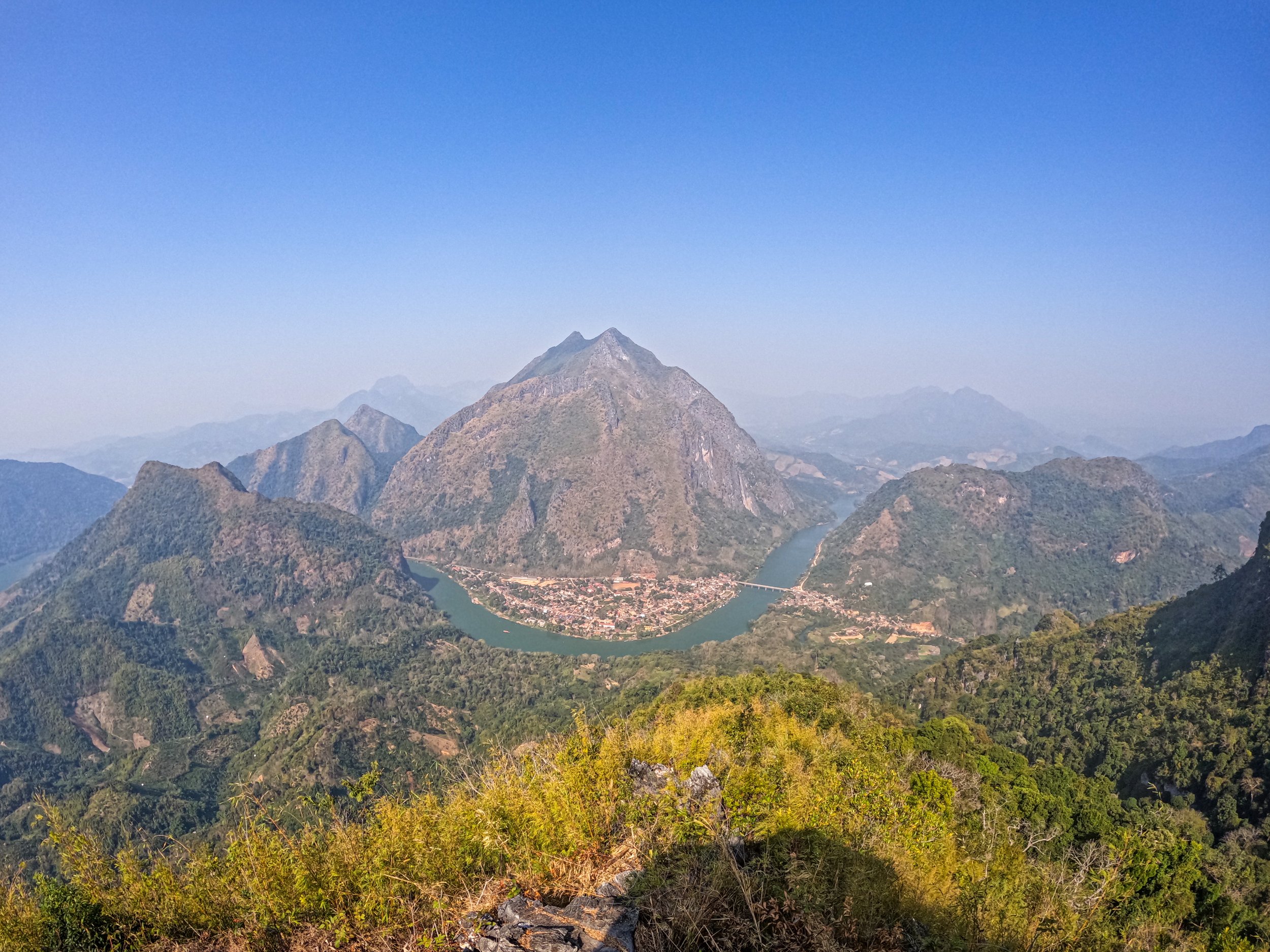
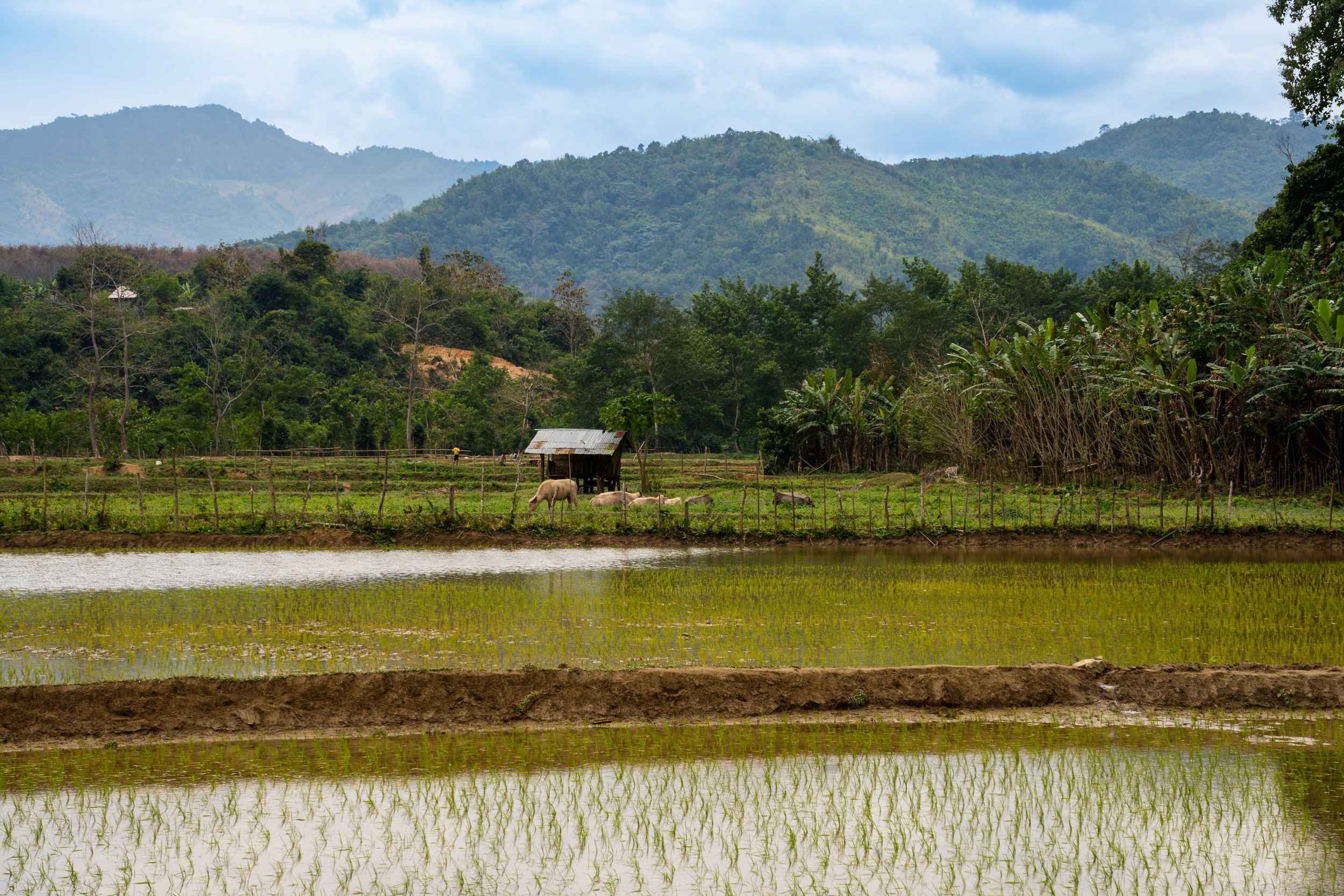
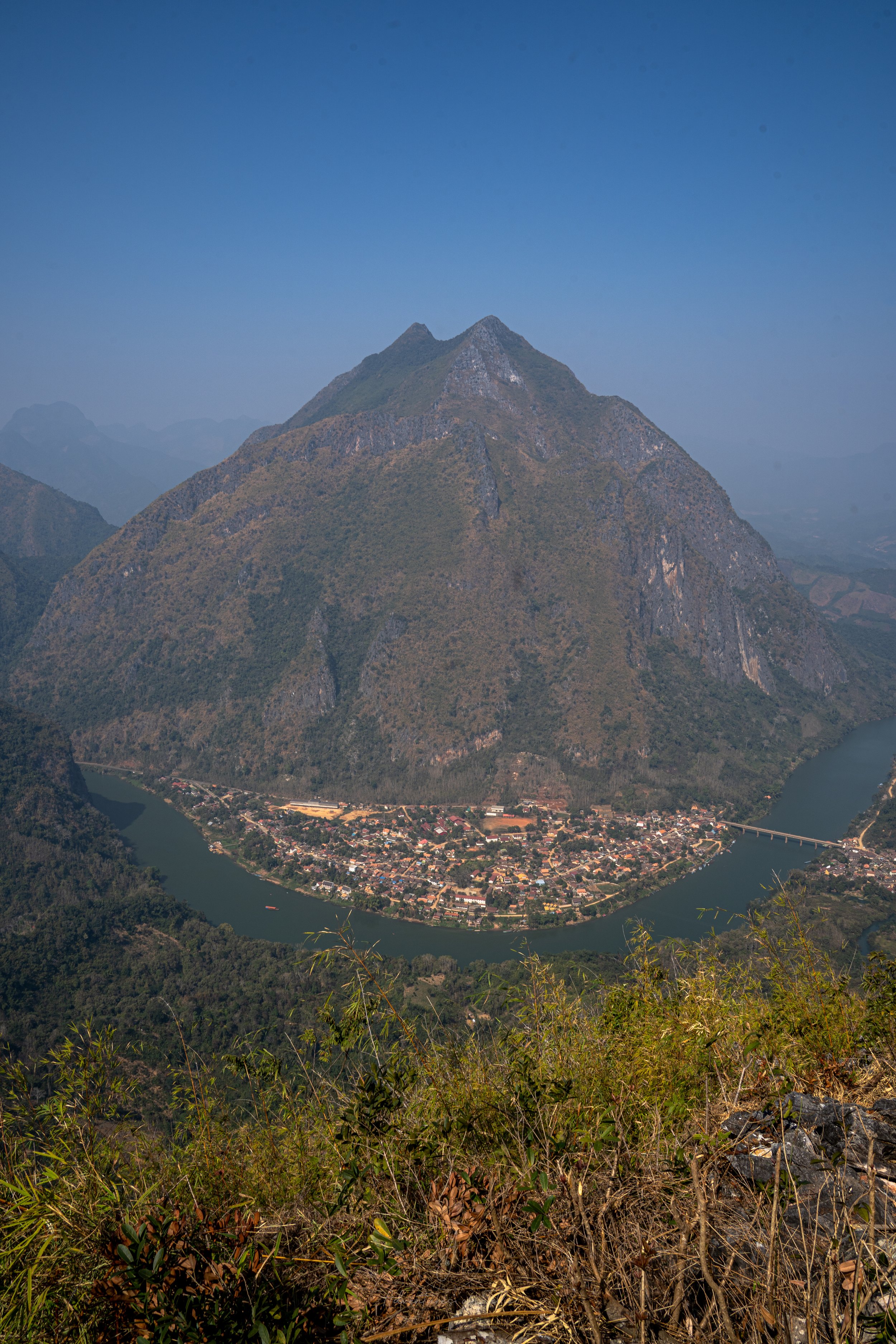

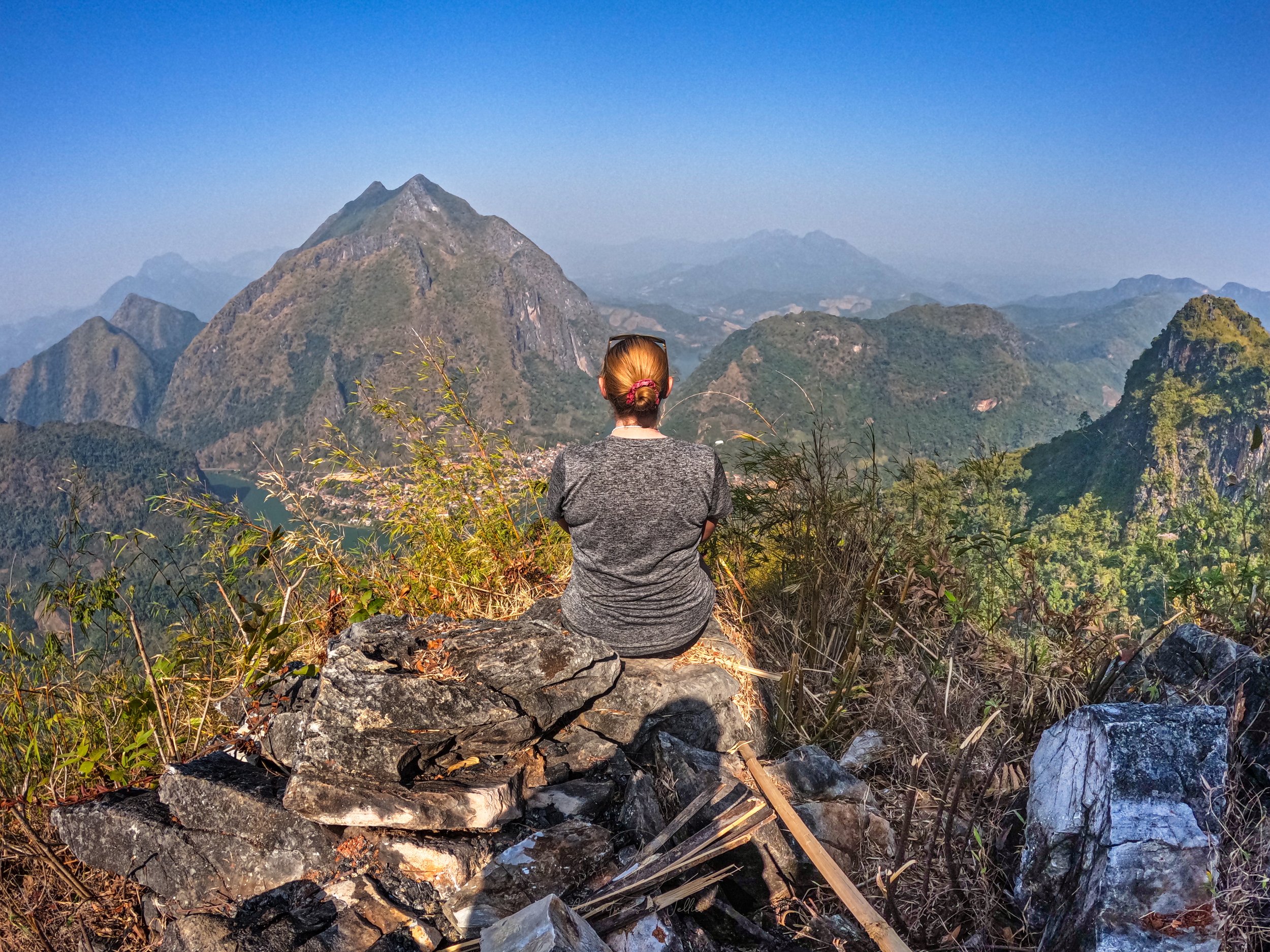
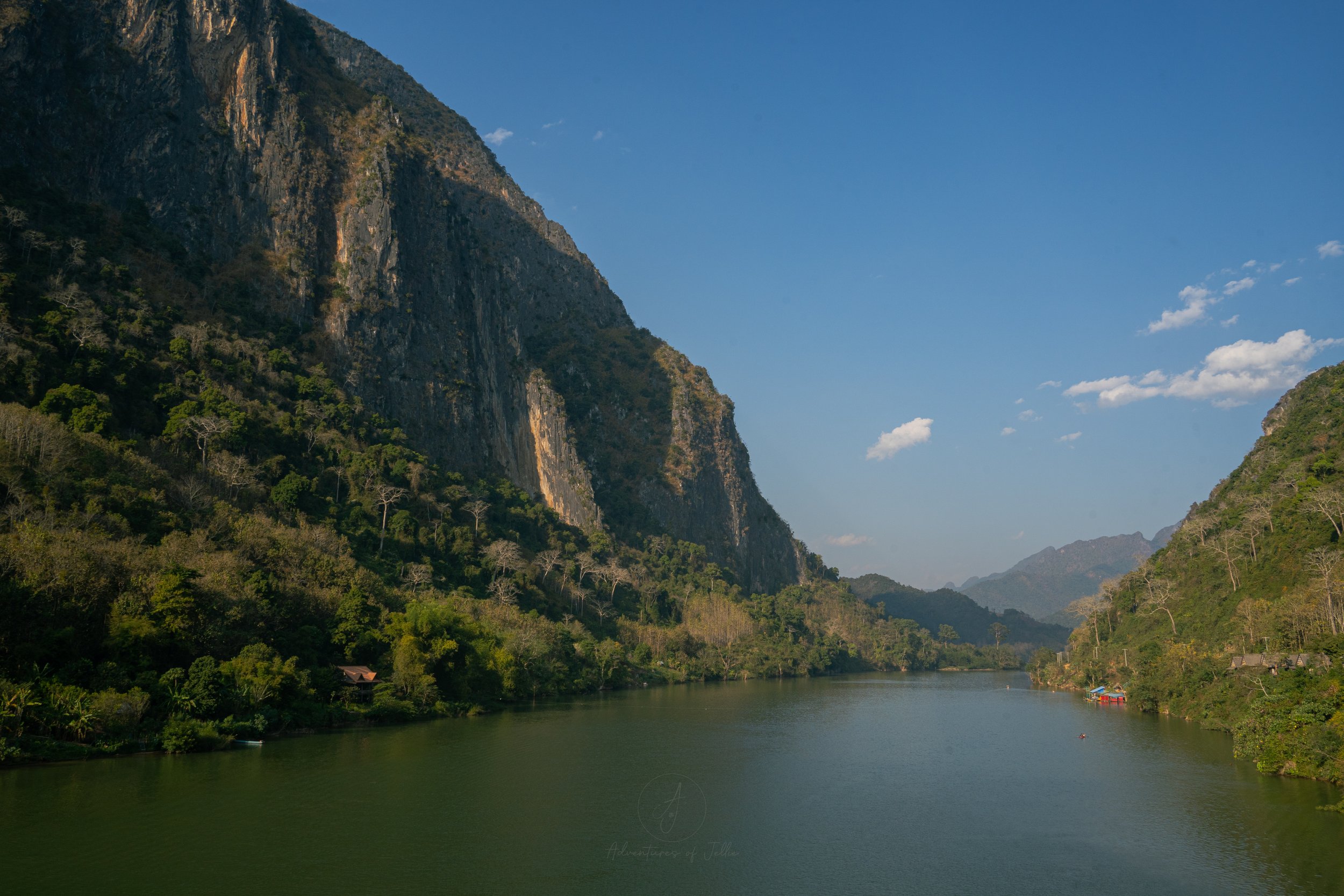
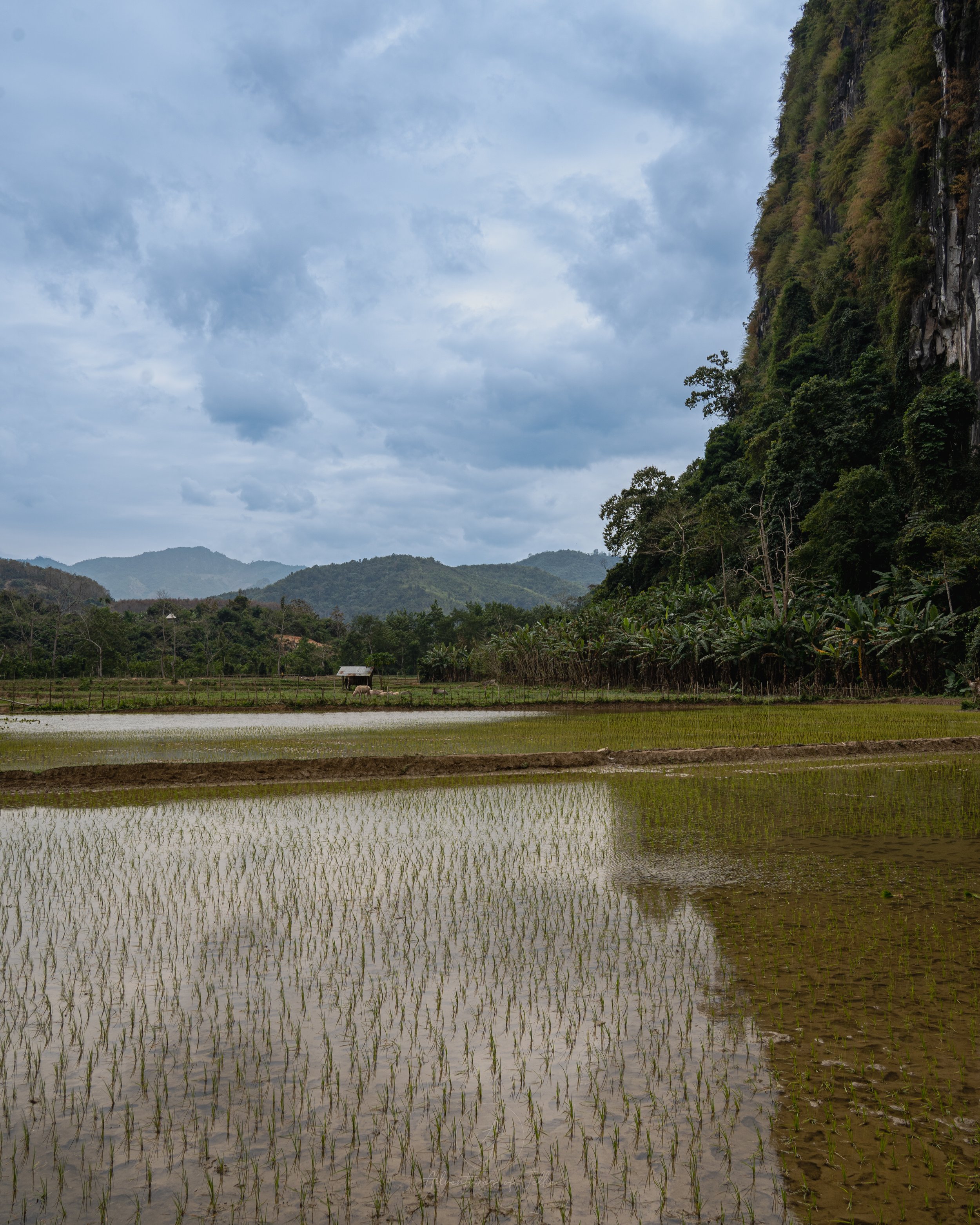
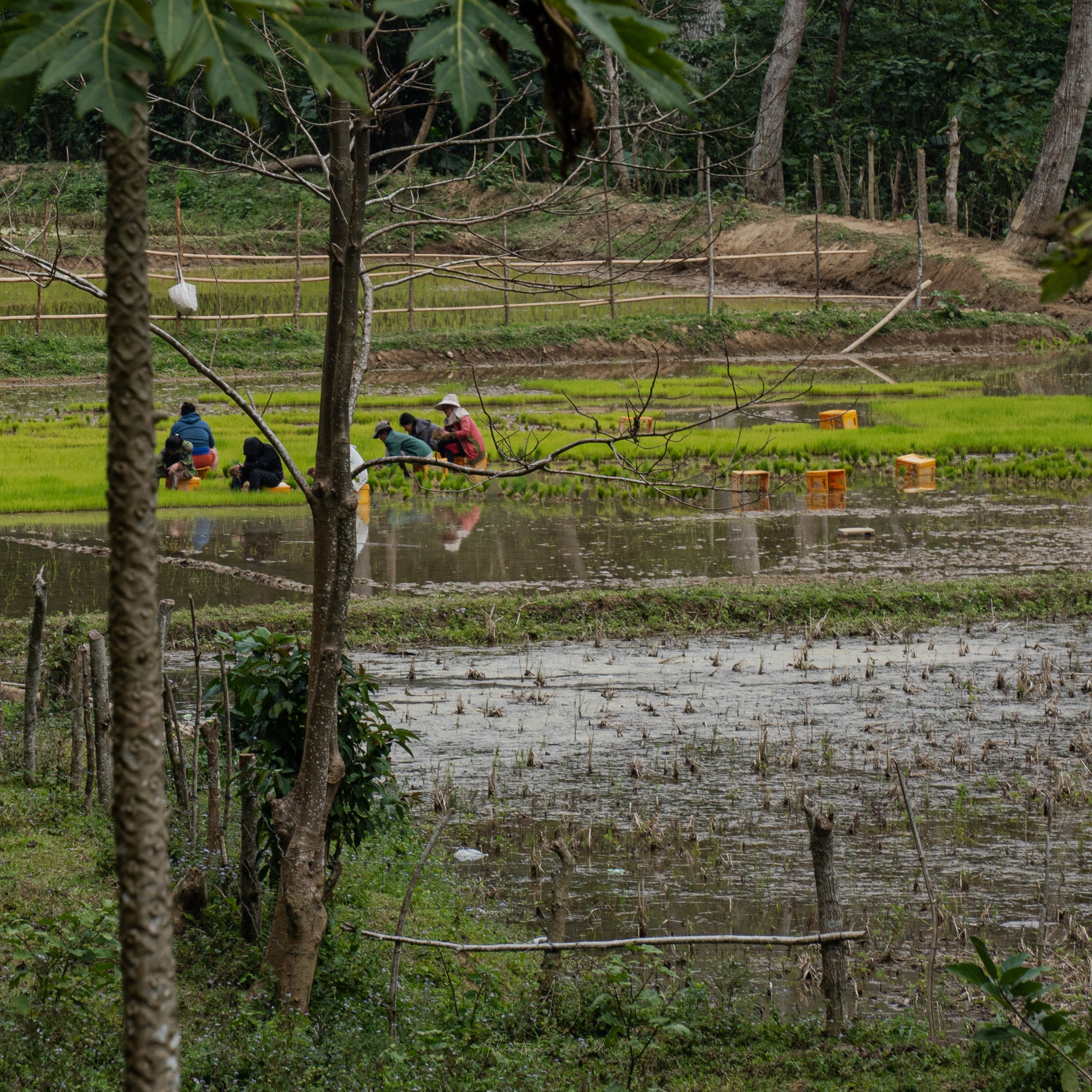
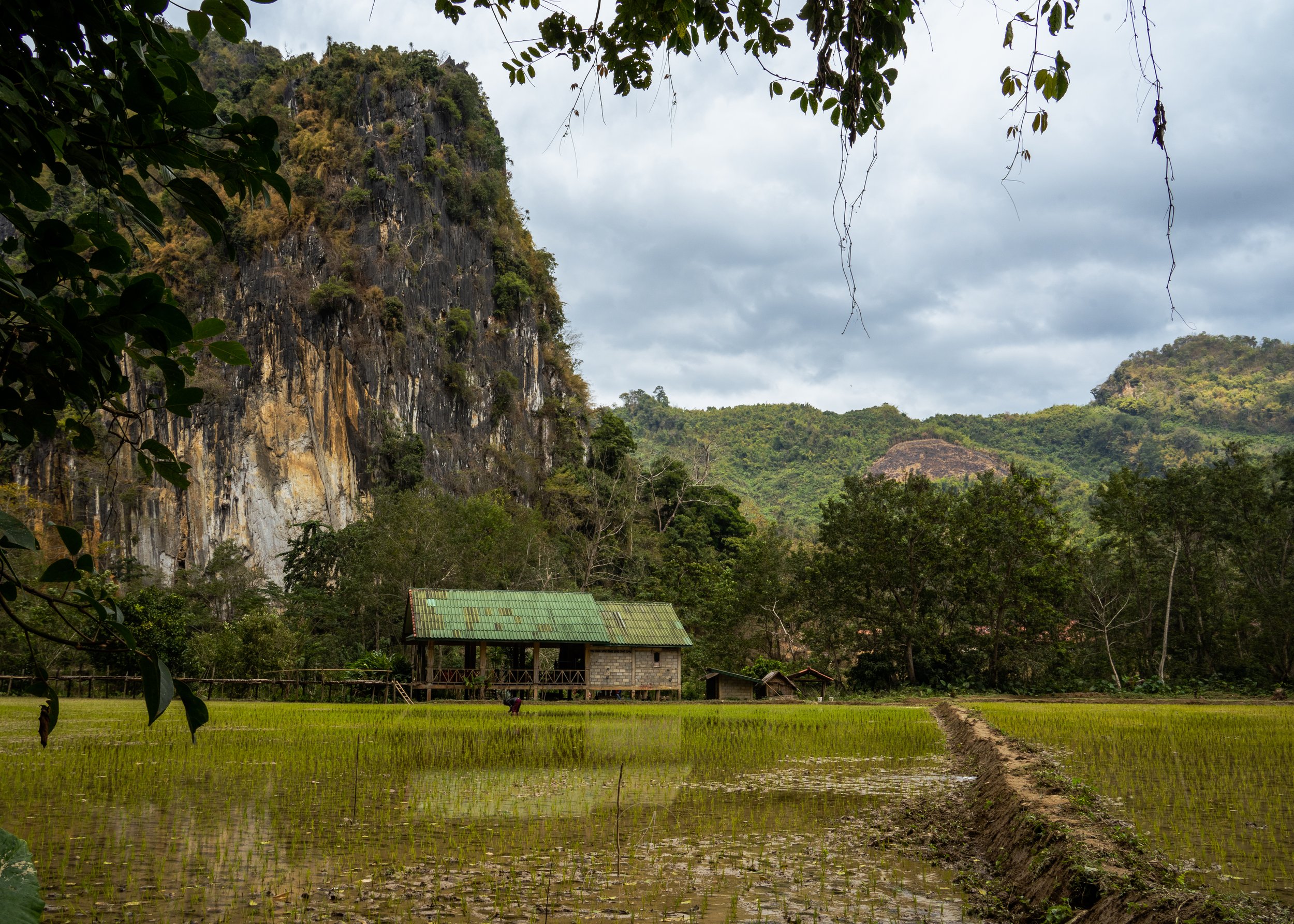
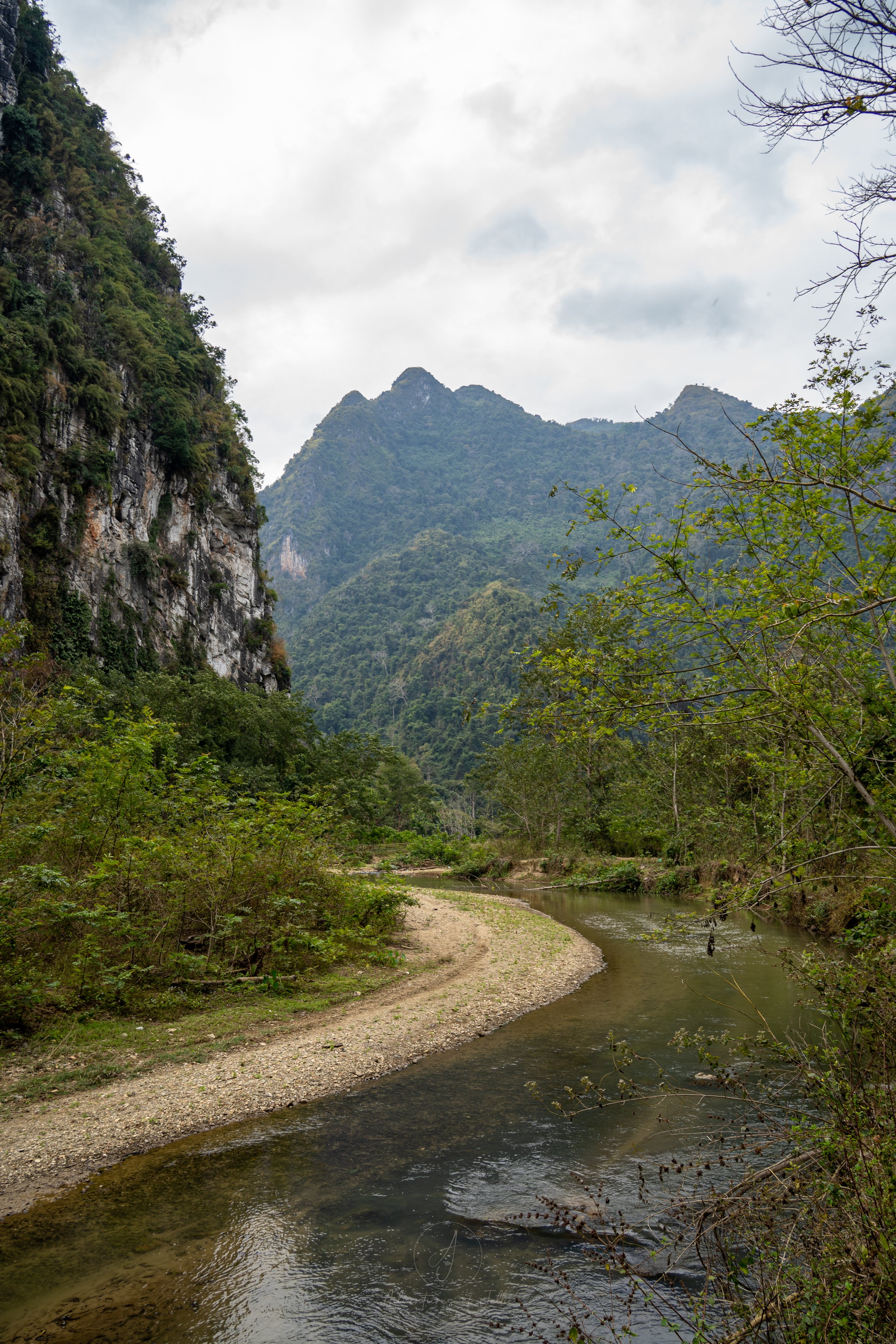
Thank you for reading,
John & Ellie x
#adventuresofjellie
*Prices correct at time of visiting - February 2023
If you’ve found this blog helpful, entertaining or you just fancy supporting us please click the button below!
If you’ve enjoyed reading this article, why not save the pin below?





























































































